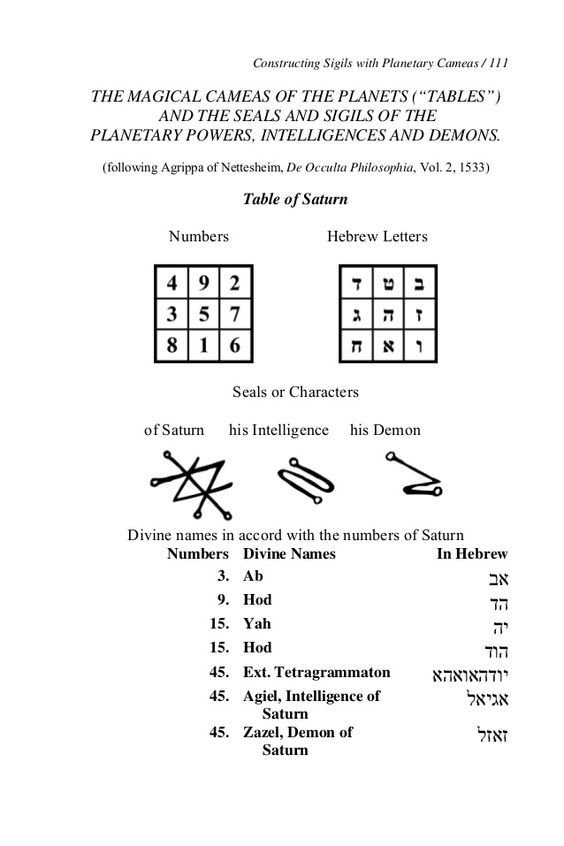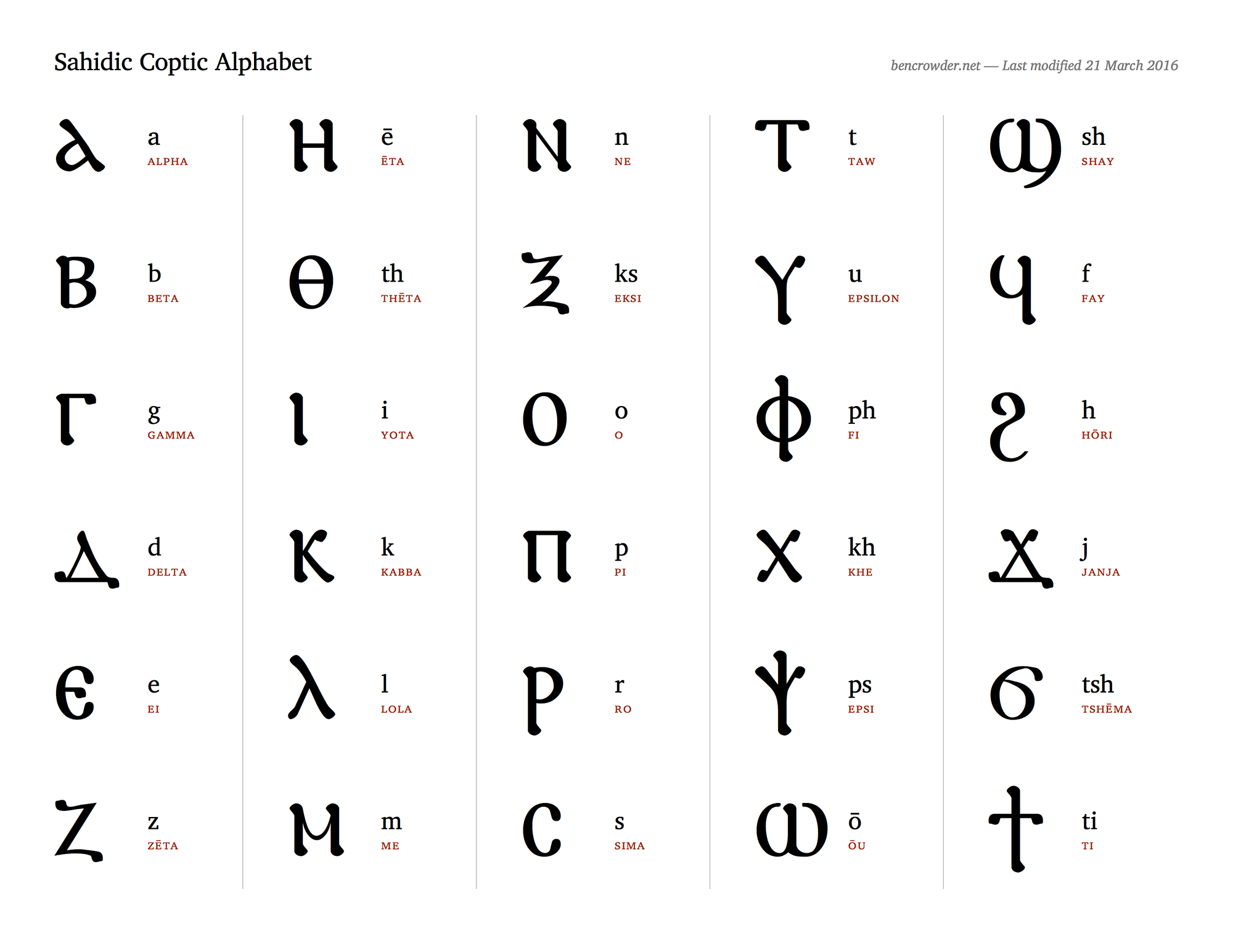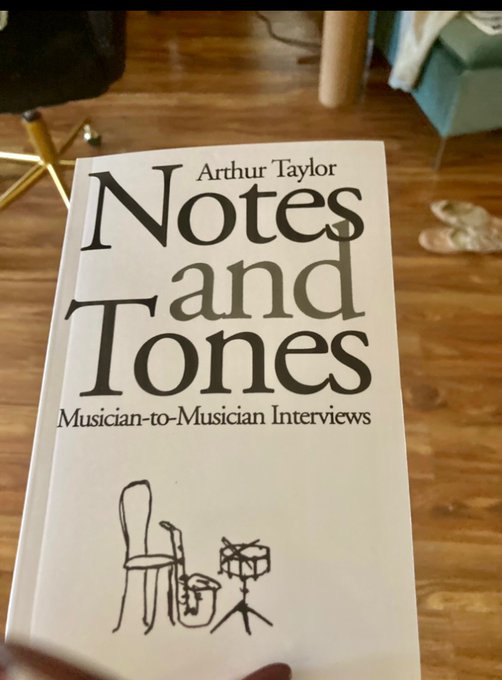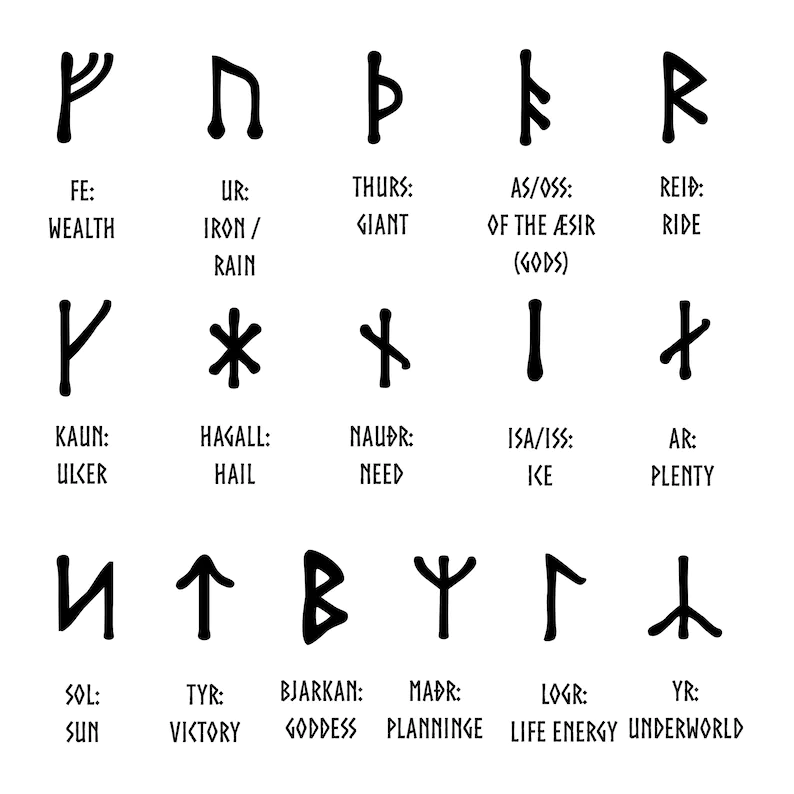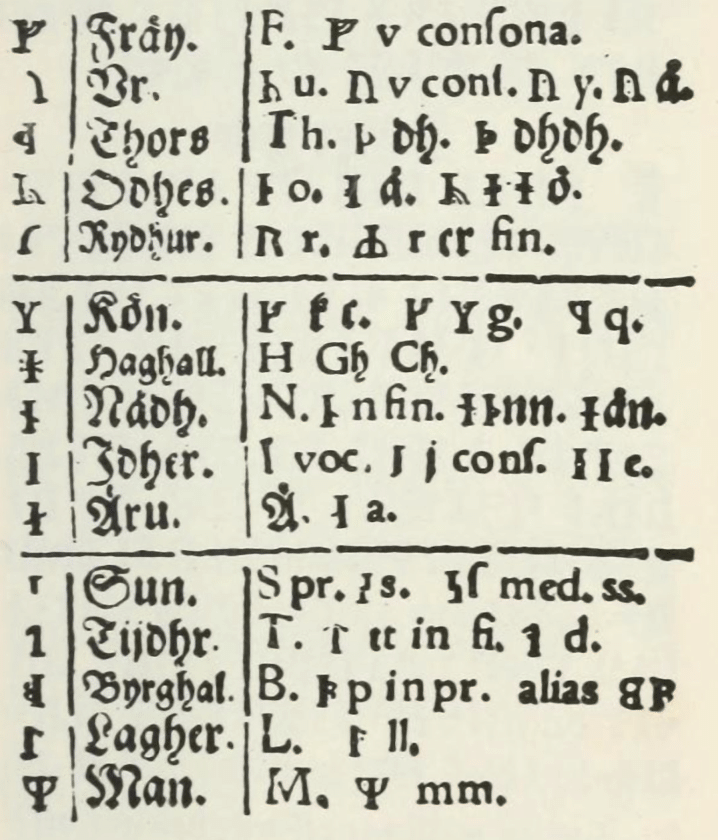It is volume 31 (30 29 28 27 26 25 24 23 22 21 20 19 18 17 16 15 14 13 12 11 10 9 8 7 6 5 4 3 2 1 0)
This is a part of a raw and uneven journal of digging into the writing systems from all over the world, so I recommend you to read the summary of this work instead.
Don Carlos responded:
Hi Dmitrij,
No worries about the greetings, "hi" or "hello" are equally good :)
I see that you have attempted to match signs from the codices with the Conch-Shell example that I sent. One has to be careful when mixing two quite different time periods, as the corresponding sign-repertoires might change a lot over the course of several centuries.
However, in this case, most of the signs present in the Conch-Shell can be found in the codices as well, for instance, the first block:

Similarly, D21a might be the codical (Postclassic) form of "?" within ti-ni-?-la
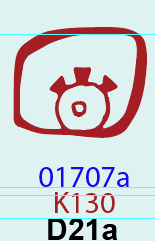
In fact, it is perhaps easier to tell which ones do NOT match. Only "hu" in "hu-b'i" might be missing (the rest are found in the codices).
I see that you have done a good job finding the syllables in the grid. Only the "ju" in "u-ju-chi" is not correct
It should be this one:

which exists in the codices as E09a
And there is a crazy ligature (infixation) here:
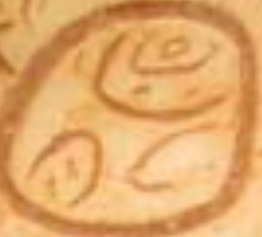
which isn't correctly analyzed
(I think) in the web link (so it's likely not ya[la]ja-ji-ya
there).
I wouldn't worry too much about " a-wu?-le-li-ya"
either. The question mark indicated doubt in the decipherment of
the sign.I think there are equally good arguments (probably even better) to read this passage as a-hu?-le-li-ya
Alright, Dmitrij, gotta get back to my work now, wish you the best of luck with your endeavors,
Best regards,
Carlos
P.S. I get back to you about your second email as soon as time allows
I'd respond that hu is next to wu, and actually with hu japanese line of labials begin, but I will wait for his next response before I bother him with my remarks having much less significance to him than to me
a great video
dared to take on this enormous poem
the first line of which is
乾坤有序,宇宙无疆。星辰密布,斗柄指航。 (mirror)
I like this first line especially, because it righteously opposes the big bang theory, and I hate that theory
That endeavour would take them 250 videos to do that. I wish ai can continue it and to do it even better than he did.
It is here because it's pangram. Making a poem of around 20 letters is considered mastery too. And so because I posted Rimbaud's pretty much nonsense, recolor, there should be a previous attempt to which that weird gamut of gay colours opposed, thus declaring modernism, so this much more spectacular poem deserves to appear here. But then I wish ai can make it from the simples hieroglyphs to the most difficult. So it makes sense to start like that. Lightning is a very interesting hieroglyph.
申 Original form of 電/电 (diàn, “lightning”) and he gave da the field in the process of explaining it, very good job!
And da being da makes me think that it is phonogram making that tail in which is נ the ن.
And the similarity of נ the ن intrigued me. Is it n? They're all the same form, but russian н is not. Where did russians take that Н form? why? оН ~ He?
oN~He (dialectal difference of the same letter? H~F~B~W ~ N (h~n is H~N, the same similarity in two different pairs of forms, one form supports the other that yes, not coincidence))
A mantra commonly associated with Mañjuśrī is the following:[9]
oṃ arapacana dhīḥ
The Arapacana is a syllabary consisting of forty-two letters, and is named after the first five letters: a, ra, pa, ca, na.[10] This syllabary was most widely used for the Gāndhārī language with the Kharoṣṭhī script but also appears in some Sanskrit texts. The syllabary features in Mahāyāna texts such as the longer Prajñāpāramitā texts, the Gaṇḍavyūha Sūtra, the Lalitavistara Sūtra, the Avataṃsaka Sūtra, the Dharmaguptaka Vinaya, and the Mūlasarvāstivāda Vinaya.[10] In some of these texts, the Arapacana syllabary serves as a mnemonic for important Mahāyāna concepts.[10] Due to its association with him, Arapacana may even serve as an alternate name for Mañjuśrī.[9]
The Sutra on Perfect Wisdom (Conze 1975) defines the significance of each syllable thus:[citation needed]
A is a door to the insight that all dharmas are unproduced from the very beginning (ādya-anutpannatvād).
RA is a door to the insight that all dharmas are without dirt (rajas).
PA is a door to the insight that all dharmas have been expounded in the ultimate sense (paramārtha).
CA is a door to the insight that the decrease (cyavana) or rebirth of any dharma cannot be apprehended, because all dharmas do not decrease, nor are they reborn.
NA is a door to the insight that the names (i.e. nāma) of all dharmas have vanished; the essential nature behind names cannot be gained or lost.
Tibetan pronunciation is slightly different and so the Tibetan characters read: oṃ a ra pa tsa na dhīḥ (Tibetan: ༀ་ཨ་ར་པ་ཙ་ན་དྷཱི༔, Wylie: om a ra pa tsa na d+hIH).[11] In Tibetan tradition, this mantra is believed to enhance wisdom and improve one's skills in debating, memory, writing, and other literary abilities. "Dhīḥ" is the seed syllable of the mantra and is chanted with greater emphasis and also repeated a number of times as a decrescendo.
Mañjuśrī (Sanskrit: मञ्जुश्री) is a bodhisattva associated with prajñā (wisdom) in Mahāyāna Buddhism. His name means "Gentle Glory" in Sanskrit.[1] Mañjuśrī is also known by the fuller name of Mañjuśrīkumārabhūta (मञ्जुश्रीकुमारभूत),[2] literally "Mañjuśrī, Still a Youth" or, less literally, "Prince Mañjuśrī". Another name of Mañjuśrī is Mañjughoṣa.
It is claimed that Nurhaci, the founder of what would become the Qing dynasty of China, named his tribe Man (滿) after Manjushri. Moreover, the Emperor Manjushri was an honorific title in Tibetan Buddhism given to some Qing emperors.
Dharma (/ˈdɑːrmə/;[7] Sanskrit: धर्म, romanized: Dharma, pronounced [dʱɐrmɐ] ⓘ; Pali: Dhamma) is a key concept with multiple meanings in the Indian religions of Hinduism, Buddhism, Jainism, and Sikhism, among others.[8] Although no single-word translation exists for dharma in English (or other European languages),[9] the term is commonly understood as referring to "order and custom" that sustain life, "virtue", or "religious and moral duties".[10][11]
so it is borrowed, because no single word translation existed
it is such a deep culture I only partially understand, yet it may well keep the keys I'm looking for:
some alphabetic song like the one I think I
found in mayan
(yet did I find it or
was I shown it?
both, I was showned what I was looking for
after I described it)and looking for bopomofo poem, I didn't find poem, but I read that it is Taiwanese phonetic writing system (continental chinks use romaji (which they call pinyin))
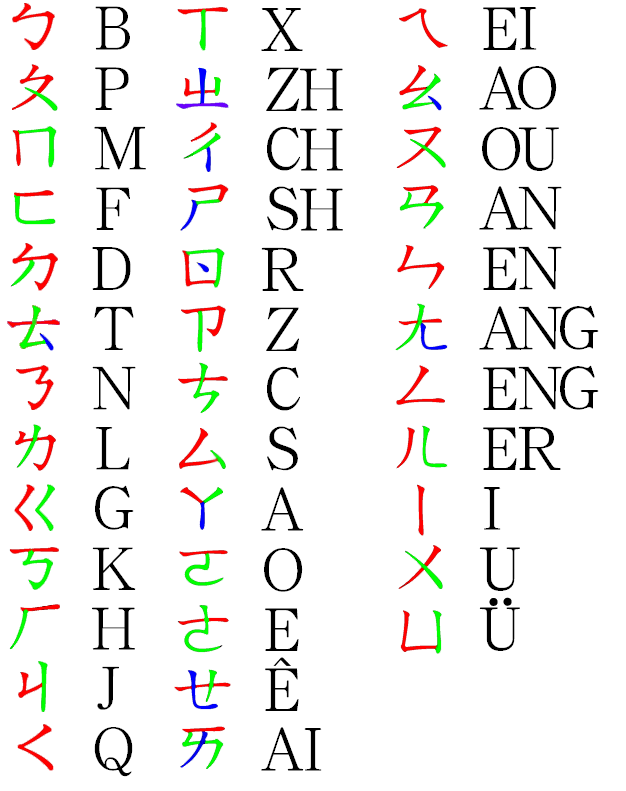
Zhuyin Fuhao, often shortened as zhuyin and commonly called bopomofo, is a type of sound-based writing for the Chinese language. In Chinese, "bo", "po", "mo" and "fo" are the first four of the conventional ordering of available syllables. As a result, the four syllables together have been used to refer to many different phonetic systems. For Chinese speakers who were first introduced to the Zhuyin system, "bopomofo" means zhuyin fuhao.
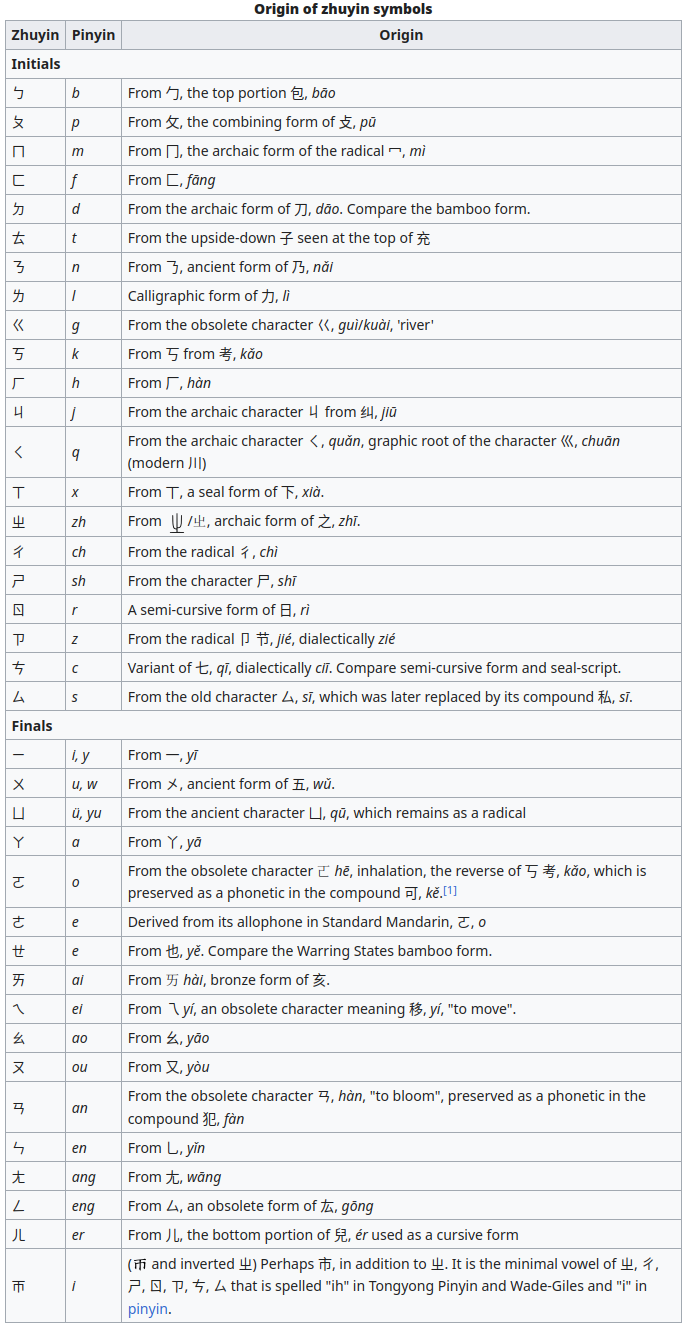
ㄑ looks like japanese く and sounds the same. And it tells that the system is ancient. So it was not invented in the 20th century, after all, so thought aye.
ha! there are plenty of signs called "archaic"!
ㄉ d From the archaic form of 刀, dāo. Compare the bamboo form.
very interesting!
ㄇ m From 冂, the archaic form of the radical 冖, mì compare that m to M and amazigh ⵡ the ⵯ (W~M thing)
ㄋ n From 𠄎, ancient form of 乃, nǎi ancient form! can you believe it!
ㄍ g From the obsolete character 巜, guì/kuài, 'river' (it's funny that ГГ before Г, and just like G before Q and K)
ㄐ j From the archaic character 丩 from 纠, jiū (Ч)
ㄑ q From the archaic character ㄑ, quǎn, graphic root of the character 巛, chuān (modern 川) and yep, it's C (and Г)
ㄒ x From 丅, a seal form of 下, xià. (T used to look like X)
ㄓ zh From /𡳿, archaic form of 之, zhī. (Ш? Ж!)
ㄙ s From the old character 厶, sī, which was later replaced by its compound 私, sī. (directly S)
ㄨ u, w From 㐅, ancient form of 五, wǔ. (ancient V is X? there's so much they are not telling us!)
ㄩ ü, yu From the ancient character 凵, qū, which remains as a radical (U? U! I told you chinese inevitably influenced alphabets, considering how long and continuous they existed)
and then they have this: ㄊ t From the upside-down 子 seen at the top of 充 like what?
and ㄌ l Calligraphic form of 力, lì
Notice how ㄍ is double ㄑ (as Sg the G can be seen as double C or double Г, Гг (in some other culture CC is S, but I can see logic in both approaches)) but Г is G, unless G is Ж, as russian dictates.
other forms also deserve attention:
ㄧ i, y From 一, yī (naturally I the 一)
ㄚ a From 丫, yā (definitely Y, yea, ya)
ㄜ [e] looks like e, and so does ㄝ[e]
ㄞ [ai] may look like archaic ᛩ-like A and ɪ next to it
ㄣ [en] ~ N
ㄭ i ( and inverted ㄓ) Perhaps 市, in addition to ㄓ. It is the minimal vowel of ㄓ, ㄔ, ㄕ, ㄖ, ㄗ, ㄘ, ㄙ that is spelled "ih" in Tongyong Pinyin and Wade-Giles and "i" in pinyin.
compare these ㄭ/ㄓ to Ⰻ/Ⱄ the

The Prakrit word "dha-ṃ-ma"/𑀥𑀁𑀫 (Sanskrit: Dharma धर्म) in the Brahmi script, as inscribed by Emperor Ashoka in his Edicts of Ashoka (3rd century BCE)
hands down, it's the same D (symbols exist outside of the writing systems using them and prior to them)
But then I am not the first one to notice:

but then they link it directly to phoenician, even though 𑀩 tells it is related to it via proto-sinaic to which it is obviously closer, and that the honestest version would sound as "we do not know yet" we can see some similarities here and there, but to reconstruct the chronology of the evolution of writing we just don't know enough to build (smart people would research before they speak their mind as a scientific knowledge, but politicians speak even when they do no know better: they probably even take it as a challenge to be able to wiggle out being caught on lies (after all them being specialized in politics and thus not necessary anything else is supposed to give the public a benefit of a doubt, but people tend to take politicians as respectable people, even if they're nothing but crooks))
My guess is it was the other way around: aramaic and the others came from the east. What is it based upon? On that the truth is the opposite of lies most of all.
another approach:
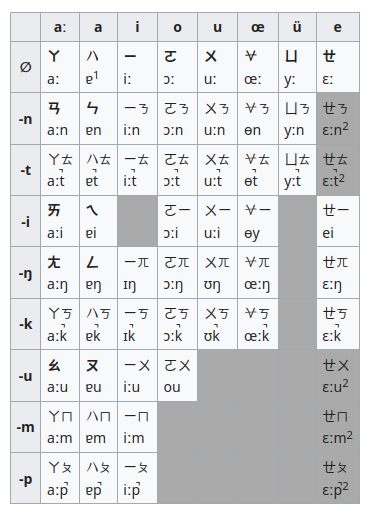
It is version which used to be used in HongKong, here some symbols are similar to japanese kana's:
[ɛː]ㄝ ~ せ[se] (世 (life, world) tells that se~e can be estFR~isEN)
And then what kind of politician ame I? How dare I speak on what I don't specialize in? I told you this is how I learn showing people the process of education, so maybe they can follow.
ㄤ reminds 尢
ㆿ [a] reminds ハ (ha in katagana) both in shape form and function
Some phrases may be alphabetic and thus powered by the whole structure of alphabets:
That will do was the phrase at which I noticed that. is th the? and is at it? It will do is a perfectly alphabetic spellic.
Is spellic previous form of spelling? is -c ~ -ŋ? did some forms stick and others didn't? So spellic didn't stay, but spelling did; biologic stayed, but biologing never appeared, though it may, ing feels like the current modern wordforming. A shape in fashion. Fashing? is ion also ic? malcovic ~ malcovin?
[Г]𐤂 ~ Λ[L] and both are not far from N (g via ŋ and l via m, but ortho articulationally it's l~n~m)
Is suffix ally is literally allie ally
ㄑ the C is right along with Г (𐤂 ~ Λ) L
Let's see them in alphabet (and notice that no alphabet contains both Г and L forms And is it how they are distinguished. r L as right left? Греческий Latin (k and t are boht in c, and gr could be a local form of saying L? tr would be the other one, because gr is english form of r, tr is russian form of r. and scottish, I think it is more relevant. The way we pronounce letters is more deep to how we write them.
(но греки называют себя.. детьми елены? ελληνική γλώσσα and Ελλάδα, but Έλληνες taught by russian teachers that that ` next to E is somehow H, but isn't it just stress? a weak stress, because it pronounces it less stressed than the final syllable, g.t. it is. g.t is gut. Russians transcribe initial H as Г sometimes. Гелены? Гереки? Ну оочень большое разделение, очень разная фонетика. И фонетика действительно всегда разная.
If I want to tell pronaunces, why do I write o? Do I pronounce it as a and write o because everybody else do? I do. And playing with my voice, thinking of how Mark recommended to play scared when you sing higher notes, so that will make you sing higher.
A выше О?
A fear
O curiosity (surprise was the first word which came to mind, and ain't they cognates!)
U disappointment
E is happiness.
Aing' AEIOU the sequence of fear followed by ei of brave? смЕлый смЕлыИ
стрАх
смЕ-лыИ
(и пытаюсь найти глагол с О У)
добудут? побудут~победят но no bing!
feAr? Ah of страх (is it ar of fear? is fe somehow stra? swing~трясти?
swing~swick~swill? swim!
sing ~ s? hum? sound?
good would stood тут (fear for brave is good? бравый краснеет от страха? не белеет. красный красава, бледный болеет (сам не сражается, но со зрительных мест поддерживает))
in ijklmn we wouldn't know if N and И were different letters for both can be used as & but again in different languages: N is LatiN, И is Греческий (ελληνική (ι in is like c[s] in russian it is ellinski))
αβγδ
εζ
ηθικλμνξ it doesn't make no sense, ι is definitely vowel, E~ξ~Σ, but what does it matter? it's est? exist
οπρσ/ςτ
υφχψω
is latin est shortened e-st of exist? as they used to write г-дь for господь
See what they take for granted, it is pathetic really:
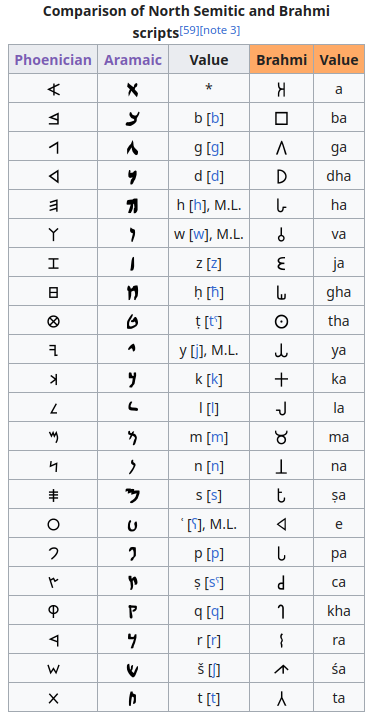
~ a is somewhat similar, but is never identical
– b is not similar at all
+ Г
+ D
–
–
– (but that symbol is cognate of E)
–
+ sun is sun (even though in phoenician isn't it earth now?)
–
–
+ (here it is meh, like ~, but it reminds me ל somewhat)
– (unless aramaic is head of a caw with horns)
–
~ (only as ttt and t)
~ (only in phoenician, and with some real stretch)
~
– (somewhat in aramic though.. if we close and rotate..)
~ (but only in aramaic)
–
~ (mostly in aramaic)
~ (but only in the aramaic)
so this comparison has two good similarities (in the first line, no wonder, it is the basis (a bace (base, basics))) and two somewhat wicker similarities, few others demanded some stretch of imagination, rotations etc. Most of symbols show zero similarity, so even placing them one next to the other, and I don't even mind them placing more writing systems next to it, so 𑀫 reminds م and because symbols predate structures they're arranged into, those are basically the same symbol (arabs thus have less time learning it than europeans. And it shows how M is head of the cow, so M are horns, and م is the head.
When I saw horned head in 𐤌 the 𐡌, I said to myself "why do you argue, the systems are definitely related!" but to tell that one came from the other is to be like Dragunking telling that japanese came from russian because lots of lexics remind one the other.
Вспоминая свои глупости, называю себя глупым человеком. Но осознавая собственные умные поступки и установки и открытия собственно тоже, называю себя странным: "странный и глупый есть разница? есть. что значит странный? непонятный. совмещающий и глупость и ум. с одной стороны умный, с другой глупый, разносторонний, странный от слова страна=сторона"
weird can be related to that meaning, if it is derjved from varied.
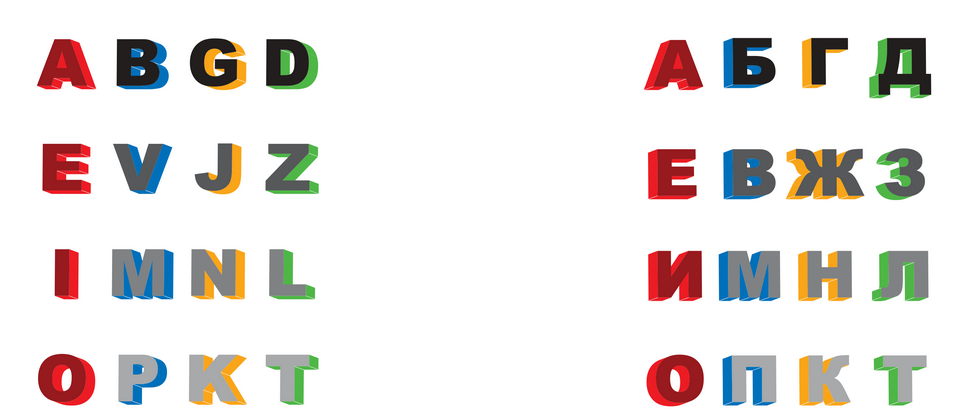
Looking at how these alphabets would be (if they were, they were in some deep past, and the deepest past we see in that region ends the alphabet short, and I was dreaming of shorter version of it, so before I unite velars and coronals, let's just set a standart of what is letter and what is just hiss.
And this presentation strikes me that V and N share shape in greek ν, and A and T share the shape of dashed l the Λ
and latin variant speak english to me, showing me the top being G-D (god is good) and following lines being EV-I-L (and is pkt pact of peace? pact is pax'ed pac? pazES, paceIT, пачеMO)
D and O also have similar shapes, but Ж reminds M more than J, so is it no form from me?
E reflects З
I reflecst l (j reflects l)
ſ reflects j, and to my surprise I don't see s in that a to t kiddi stuff, so is j also s? and the second example was to the poing: jude~суде (judge [sudjja]судья) the first example was сука жука, and though at first I thought сука жука жыда (жук значит хитрый) но теперь я вижу, что жука это жучка (сучка (стандартнейшее русское имя для сучки))
жопа сопа? и действительно сопит, сопло.
жизнь существование? суть сустье счастье?
жизнь сидень? существование же индид!
жираф сираф, но это неевропейское слово скорее всего же, еёщ бы зебру притащил
желчь селчь? зелч though.. voiceless are voiced? the same? the one? whisper equals speech.
но если g unites g and д, z is both z and ž, then l and n combine and k and t are both c as I said, so let redraw it
ABC [aбg]
EVZ
IML
OPT
12 is a nice shape number, but the isn't 15 16 without a?
or is 15 five syllables with each
ABGZD ABGDЧ? Looking at these three lines as at plosive sonor and fricative
IMNLR for example JMNLR are all the sonors there are
UPQST UFHSШ I had trouble finding the other plosive, so.. С?
The honest way to say would be I don't
know.
Was it 12? As there are 12 hous and 12 months,
ABGD
IMNL
UFHS would be much more consistent.
But then if those are 12 months, the names of the months should have reflected that?
But looking at the names of the months in different languages I only stumbled across gagaut:

or it is gagauz (t and z are different forms of the same concept?)
Because it starts as Б followed by Г, but then with some hits close to home it is chaotic
But it tells what March is about, it is Marta, some great Mother I think.
But then isn't vowel Я(J~I) followed by Ф(F~Y?) promising not less? We know the names of the months were changed in the historic period, what made me think they were not changed before that? Why would names of the months after July and August be faceless numbers? The old names were erased prepared to be taken by emperors, and that never happened.
Looking at russian names I noticed that all summer months begin with vowel: Июнь Июль Август and only central months in Autumn Spring and Winter begin with vowel: Октябрь Январь Апрель.
And names of the times are more collaborating, being AWSS Autumn Winter Spring~Summer and they used to celebrate the New Year in the autumn.
In russian though the sequence is ЗВЛО.. как-то.. зло.. и три из четырёх букв использованы как символы "спецоперации" завали ебло эти страшные буквы мне говорят, русский язык он злой и ебанутый, ты только посмотри на этот ёбаный пиздец (но он не плохой и не хороший, он разный, он странный)
That spelling of dharma

looks like it is the uttermost basis of the alphabet, the lingual D and labial M
technically it is DM and it is basically the order of indian syllabaries: linguals before labials
and I can see M in that 𑀫, and I can see those horns in ᛘ
DM is also DeeMaa which is mon nom
A
E
EE (jΛΜn) K Ξ(ξ)
O
OO (uVWy) X Z(ζ)
A
E F G H [v ʒ ʃ]
EE (jΛΜn) K Ξ(ξ)
O P Q S but [p k t (or even bgd) would be the fricative pairs of fgh (g can be soft, q cannot)]
OO (uVWy) X Z(ζ)
3 2 1 of E F Г
rÆdy ſtÆdy Го!
and they ran for contest, thus countdown they knew
ABC
3 2 1
A Б Г
З 2 1 (yes, A and D meet again, but this time by accident I suppose. Unless..
D B~g could be the
sequnce
3 is how ד cursive looks (funny that in print it looks like 7)
doesn't it tell that ד is the foremost letter? The Deus? Devil? Demon? Death? Dirt? Dark? Dull? Dumb? Deaf? but blind? and then if you don't see and don't feel anything, why is it bad? it is nohow. But in comparison you can find many bad aspects.
и 1[raz] и 2[dva] и Гоу
Johanson combines Иванова и Ивановна во единое целое. въ ~ внъ (russians used to write внъ before въ (which they wrote before в ((isn't it telling us that i in in is ו?))))
I'd ask if it combines v and s(b~c thing г[в] thing_)
but вна is female, son is translated into russian as вич (which)
Comparing wind and wave (развеваться на ветру, похож въ здесь имеет значение of blow)
is vav wave? W is common in wind and wave, wind is like wened (ed suffix attached to plural form of w, wen is plural w? but what is w?
but isn't that W is playing in distinguishing дУть from дАть from дЕть (но если это система, покажи ещё такого, докажи что это не случайное сходство)
дуй дай дей
буй бай бей бой
куй кий кой
суй сей
чуй чай чей
май (иметь~имати (t.e. май is liteareally have)) мой
вей (вот мы добрались и до него) вой
гай гой (both are borrowed)
is Г borrowed as F? абвд? could russian go thus, and thuse чего[чево] (they could command orthography, but not the speech)
жуй now isn't it russian G
зей (от слова разевать, но русский этого слова не узнает, не факт что оно даже есть)
лай лей
н also seems to be unrussian in this context
пай пей пой
рей рой
тай той
хуй хай хей хой
ц and ш with щ also seems to be unrussian in this context
So let's collect russian consonanta welke в таком контексте существуют
Б (all forms exist, even бий is ukrainian бой, literally the same word pronounced differently in a very nearby language, imagine how words can deviate moving further across the language borders)
Вей Вой Вей is similar to Веди (развевая флагом веди за собой) но вой и веди.. разве волки ведут других воем? Люди ведут за собой горлопанством.
Дай Дей Дои Дуй
Жуй
Кой Куй
Лай Лей
Май Мой
Пай Пей Пой
Рай Рей Рой
Сей
有 [yǒu] be, exist, have (I'd remember that hieroglyph by imagining it J on the left top and ou somehow enclosed into that moon or meat sing (sign~thing)
ра в рай то же что и в радость и ура, это ра, задорнов здесь был прав. Он похоронил эту идею под своим кривлянием следующим за ним. Это удивительно, но факт. Жара. И это возможно была моя идея, которую я отстаивал в школе более чем за десятилетие до того как он начал этим заниматься. Был он реакцией на мой начала разбора языка до слогов, до букв? Запросто. Я помню явное видение ра в жара и шар как жара, жарит~шарит зарит~шарит? зрит~шарит! смотрит это от смониторит сокращённое. возможно. те же запчасти, просто в смотрит проще обошлись, и это с похоже там было н, а тогда не проще, просто короче за счёт аффрикат. Аффрикаты явно сложные звуки и слоговые слова всяко древней, латынь очевидно древнее русского, и да русский отчасти от латыни произошёл. mini, tibi, are you kiddin' me
and now to something completely different..
Here the guy who gave us ABC of anterior being behaviour consequnce
brings I P D of Integrity Patience Delegation as the three qualities of a leader
I need to work on patience and delegation. Delegate and wate (pate of patience? waitence)
Me not being nowhere anywhere near being a leader, would tell it would be charm, but I guess I may delegate encharming to some naturally charming people. I must have the vision, which I do have.
And now I also practice patience with the students I have, at first I only could work with the older people, now a couple of bright youngsters appeared and I think my paience will bear fruit in the next ten years. I keep on working, and the result is an inevitability. Scientific result is already incoming, financial success will come after I start directly working on making it viable. I may not be bothered by this to keep my vision undistorted by the reality, because the vision is of the future I may bring, earning on seeing the future too.
So I mentioned that guy, because I shared my work with him (not even having noticed that BT are his initials) and if he didn't mention ABC principle before 2013 (the meeting was not before that year, maybe 2015 or so)
2014 happened just after I made my thing public in the autumn of 2013.. and I never linked it.
but 2008 was any better? Sakartvello just decided not to fight when those regions were taken.
If Ukraine decided to relocate their citizens and fight russia otherwise, there'd be no war. But then who knows they wouldn't go further? They'd work on taking of over more and more, to reconstruct the ussr of theirs (soviet jews love ussr)
I have left a huge ammount of runic table in the very end of vol.20
and now let's look at some of them closer. The first one is here to show that A and Д meet again in ᚦ
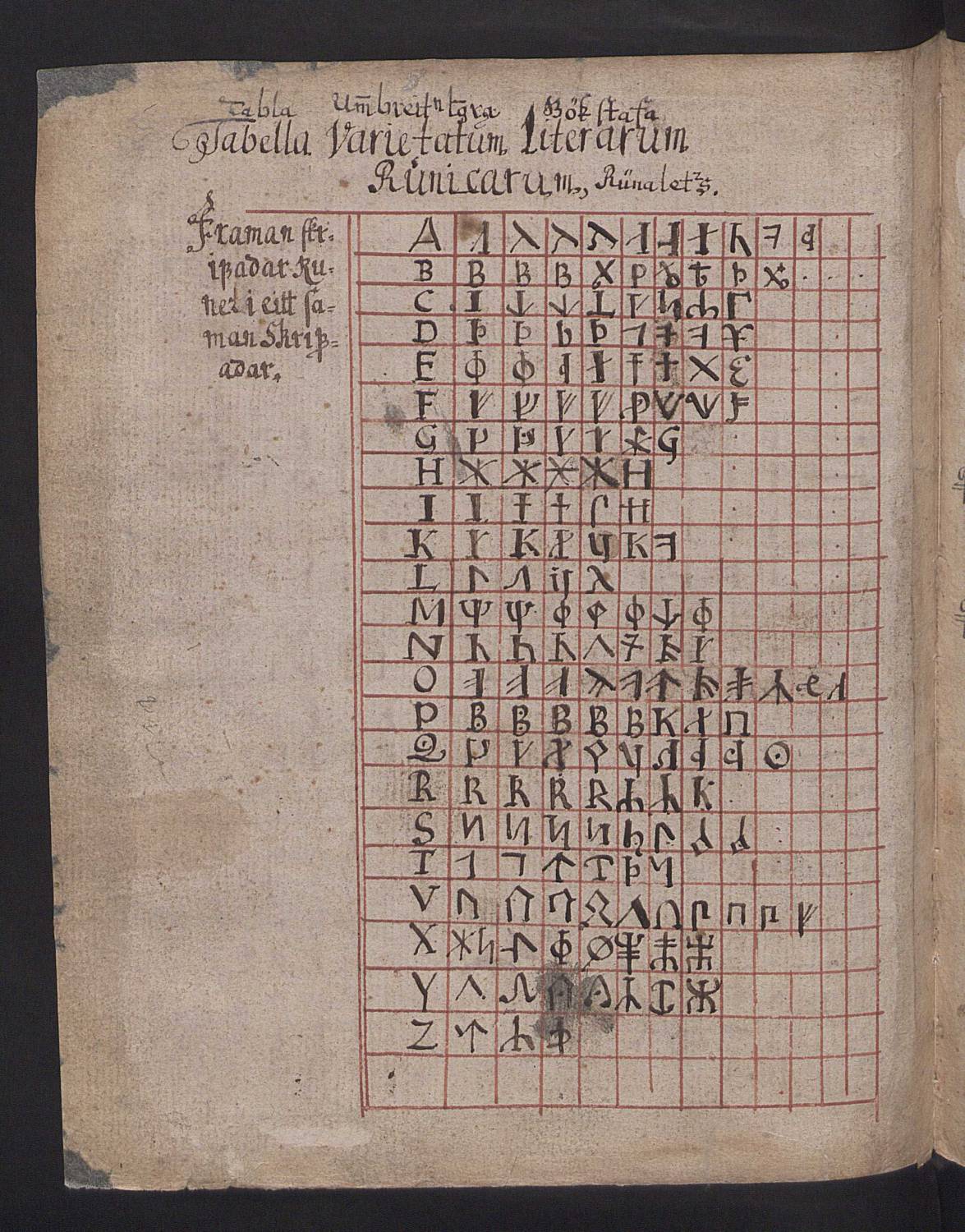
Most of all those pages show that nordic runes are not some isolated tradition, but a whole network of writing systems, not less complex than the modern european scripts. I think it may be able to compare the runic tradition with modern alphabetic tradition in relation to this diversity.
Notice B similar to Б. The next table tells it is in gothic:

but then not exactly, there was some not tilted form, or was it also found in gothic texts?
Either way, how can I trust this data? They mark ᚦ as b, which it does remind, but wtf! Either way, even if it's true, which is also not guaranteed, the ammount of data is so intense that I'd rather stady mayan or chinese for the source, either way use of actually used wrting system doesn't raise the question of validity that much. But I don't go empty-handed, here is their collection of binderunen, the page I may use in my own book when I mention them.

ᛕ
and
ᛣ as ligatures are especially funky
ligatures of ᚱ show that ᛅ is ᛆ
and that ᛏ is ᛐ
and also that ᚾ ~ ᛘ, for ᚱ would merge with them the same, but it doesn't seem to
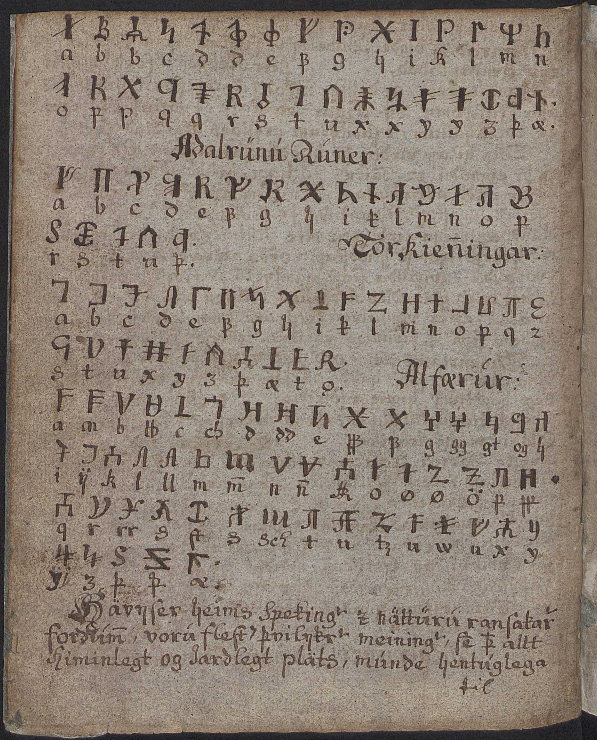
and this one uses П-like shape for b
(I told you the glyphs predate the tables)
The man probably legitley collected the writing systems, but some of examplars make me wonder if he was not bamboozled by some jocker
(I told you the glyphs predate the tables)
The man probably legitley collected the writing systems, but some of examplars make me wonder if he was not bamboozled by some jocker
If you want some more, click those images and see the rest of the collection, some of them are off the wall, but my interest to them is minimal, since they're all aranged along latin canon, their alphabetic order is lost in the process of collecting of those scripts. Maybe I should look for other books of that guy, maybe in some other he did it otherwise.
ångström is 0.1 nanometres, and the depth at which they can now see:
and here I am way out of my depth, though I will keep on watching it until I dig it
jewish is russian superstrate which was absorbed and overwhelmed by russian (some weird jewish words became part of the russian slang, but slang is snake in netherlands.
θ became ѳ which is f, thus εζηθ is eghf with f sent to the end of the alphabet, and numeral use of greek whether appeared much later, for romans didn't use the alphabet as numeral system (but the gospel is written in english, and in its attachment the apocalypse numeral is in letters, but then isn't it merely kabbala, jeish influence upon greece which didn't happen before that?
abcd
efg
hijk
lmnop
qrs
tuv
wx
yz
now I know my abc, but it is a chaos, see
even though it started nice breaking the first line where it should have, and I even like h in the i group, because h is и in russian and both sound as i in modern greek.
If that song (the most famous alphabet song, I suppose, I don't know such song in russian at all)
a b c d
e f g
h i j k
l m n
but g and n rhyme only if g is jew and n is new
and then isn't d and k rhyming by being day [di:] and key [ki:]
Was k-symmetry the first one? k symmetry explained why the alphabet is deviuated from the abcd structure in the k-line (it is h-line now)
a b cd
e f g
hijkl m n
o p qrst
a b cd
e f g
h ij k
l m n
o p qrst
a b cd
e f g
h y k (then is ij u the w? ў? as u looks as if it is double ɪ)
I m n
o p qrst
h y k
e f g
l m n
o p qrst
helo, aloha
a b cd
l m n
o p qrst
h y k
a b cd
ohayo, hi, though it's 18:07, I just woke up an hour ago,let's go
I play the latin the way I played with russian: because I knew it. Now it's time to switch to greek:
αβγδ
εθζ
ηικ no ij, not place for maneur into y the у the w
λμνξ and why on earth woul λ be vowel (though this one does look like upside down y)
οπρστ
υφχψω and ω tells that greeks has lost it.. or were they preparing to create another line and could find a vowel? Were they priests of Apolloi who added that and η or ι? well ι is more basal and across the europe it is universal, ω looks like double and not ο but υ, like w! and then it is past χ as y is, and then greeks have their z in the second line, not dethrowned yet. Latin overthrew zeus to have only Jupiter in charge? in change!!! Didn't greeks borrowed latin alphabet to turn it greek? Not necessarily from the Rome, from Etruscans. And roman historians justified the overtake of the Italy by declaring etruscans to be secondary to the greeks, who could have borrowed their alphabet from etruscans (they say themselves they took it from somebody, and I have some doubt that it was phoenicians. But too bad the "On History" by Democritos didn't survive (I have some slight hope that it is buried in some vault, in some unexcavated yet
Though now V is in the "newer, greek, line" which may tell that greeks added their own national letters to the archaic common alphabet, and only then latin borrowed those letters from greek to add them the same way to the end of it. But u-line keeps on the abcd structure (though with some deviations now, it was more to the point being uvx and I wonder if that x is not t, for it was written so in some phoenician texts, and in the most of old-italic scripts)
Dimon, dream on! I didn't hate that song until it stuck in my head, now I have to scare it away with something nasty:
and it recommended me this
coco is ку-ку! coco e loco
Democritus is Democritos in greek, us is a weird latin transliteration. They had no problem with substituting greek o with their uy
The same o to u transfer happened in Herodotus:

The final Σ is exactly the lunar sigmae Ϲ
But why the name is so excentric? Wasn't Η added later by a forger, who also could rub it with some ancient organic shit as it telling that it is at least that old. Was it to sell it more expensive? Because nobody knows who Rodotos was, but H-rodotos (read as Иродотус тудэй, so wasn't it a christian who wanted to make it of Ирод? Either way, the T and some O look too knew to be old. If it was laying in the dirt, they would all be like that. But what if it was washed by rain? too clean, too new.
AD and BC are rememed as CE and BCE
it is as if they recognized A being later than B and C (hence book? буква?)
book and буква both indicate the sequence of BC
It is interesting, that BCE is literally Before CE, and couldn't it be return to roots? deGrass Tyson tells that he referencess the jesuits who invented AD and BC definition when they invented the Gregorian calendar, but who came up with BCE and CE? Didn't he take it from the previous calendar?
Diocletian began his reign on 20 November 284 AD, and the reference epoch (day one of the Diocletian era) was assigned to be the first day of that Alexandrian year, 1 Thoth, the Egyptian New Year, or 29 August 284 AD.
> Thoth, the Egyptian calendar
Thout (Coptic: Ⲑⲱⲟⲩⲧ, [tʰoːuːt]), also known as Thoth (Greek: Θωθ, Thōth) and Tut[1] (Arabic: توت), is the first month of the ancient Egyptian and Coptic calendars. It lies between 11 September and 10 October of the Gregorian calendar. The month of Thout is also the first month of the Season of Akhet (Inundation) in Ancient Egypt, when the Nile floods historically covered the land of Egypt; it has not done so since the construction of the High Dam at Aswan.
The name of the month comes from Thoth, the Ancient Egyptian God of Wisdom and Science, inventor of writing, patron of scribes, and "he who designates the seasons, months, and years." Thoth presided over the "House of Life," which were composed and copied all texts necessary for the maintenance and replenishment of life.
The ancient Egyptian calendar – a civil calendar – was a solar calendar with a 365-day year. The year consisted of three seasons of 120 days each, plus an intercalary month of five epagomenal days treated as outside of the year proper. Each season was divided into four months of 30 days. These twelve months were initially numbered within each season but came to also be known by the names of their principal festivals. Each month was divided into three 10-day periods known as decans or decades. It has been suggested that during the Nineteenth Dynasty and the Twentieth Dynasty the last two days of each decan were usually treated as a kind of weekend for the royal craftsmen, with royal artisans free from work.[2]
Because this calendrical year was nearly a quarter of a day shorter than the solar year, the Egyptian calendar lost about one day every four years relative to the Gregorian calendar. It is therefore sometimes referred to as the wandering year (Latin: annus vagus), as its months rotated about one day through the solar year every four years. Ptolemy III's Canopus Decree attempted to correct this through the introduction of a sixth epagomenal day every four years but the proposal was resisted by the Egyptian priests and people and abandoned until the establishment of the Alexandrian or Coptic calendar by Augustus. The introduction of a leap day to the Egyptian calendar made it equivalent to the reformed Julian calendar, although by extension it continues to diverge from the Gregorian calendar at the turn of most centuries.
This civil calendar ran concurrently with an Egyptian lunar calendar which was used for some religious rituals and festivals. Some Egyptologists have described it as lunisolar, with an intercalary month supposedly added every two or three years to maintain its consistency with the solar year, but no evidence of such intercalation before the 4th century BC has yet been discovered.
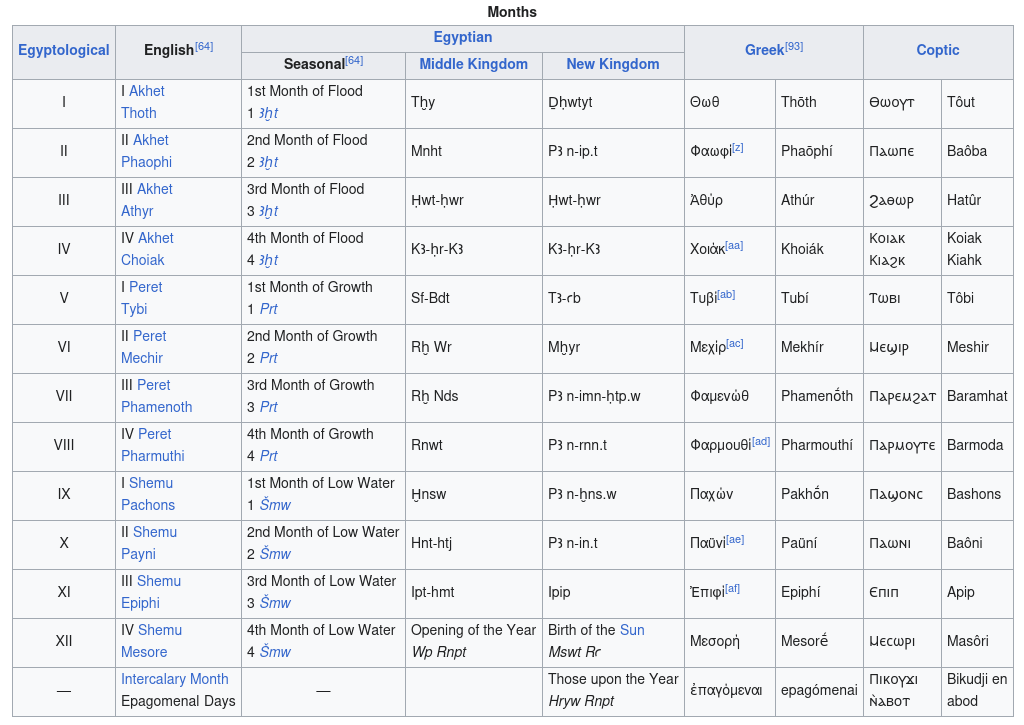
What is significant here is the names of the seasons: Akhet Peret Shemu (the initials are vowel, labial, lingual, and that lingual is very similar to the name of the letter shin, and even more so to the name of the jewish god הShem. Yes, god of our enemy is Satan, S-n, Son and Sun. Sun is the god? God of the G-s, were egyptian praying to Nile? No, Rah is the sun. Did jews and egyptian have the same god? If their nation came out of egyptian slavery, they're very diverse, as bible describes Judeans. Did they know their own god before the burning bush incident?
So what am I waiting for? Let's look those seasons in hieroglyphs!

𓆷𓐍𓏏 𓉐𓂋𓏏 𓈙𓈗
and another surprise? Shemu has waters and not fire in it's hieroglyphic form.
And the letter which I would read as ш is A here? Like wt..
Akhet or Flooding Peret or Sowing Time Shemu or Harvest Time
Notice that dutch oogst [o:hst] reminds august in both shape and meaning.
(augustus is the way they call the month, to avoid homonymy I supposed, in latin manner)

How sick is it that the first letter is ideogram. and technically it is also ш, isn't by some queer irony technically Ш is the first letter? How do I pull it so that the names of the seasons having initials the way I like them became indicating the first letters? It is the hypothesis I am working with.
And because in that climate they can take several harvests per year, I sugest oogsttijd to be european misinterpretation of their calendar, and thus I recognize
менее ~ ме-нее ~ медленнее ~ M длиннее (is M tiMe? 𓏏𓅓?)
более ~ б-ее ~ быстрее? но более ведь от больше, а менее от меньше
or is that ше ещё? is более ~ more более основная форма чем больше? morphologically it makes perfect sense.
but lets' move further into egyptian hieroglyphics and compare the first two symbols, where ankh as if crosses the mace out. Are they antonyms? I may only guess the meanings of peace and destruction.

and how that ḥwt reminds house
Suddenly I wonder if symbols as 𓉦 are attempts of correction, as those starships are:

famous only because they're correction of the whole phrase and not one symbol:
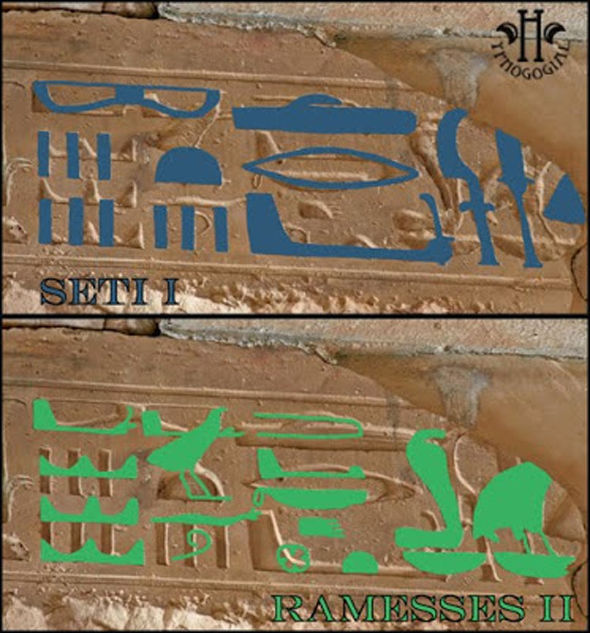
but correction of single words could be more rampant and could fly beneath the radar being misinterpreted as ligatures.
But then here they corrected it before that? that bird and the arm in the green writings.
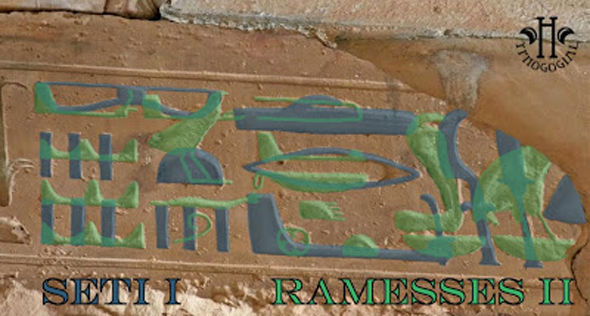
Christians made internet change www. to https:// and I believe they were christians, because www is 666 and also because I can see h-tos for христос in https (и были там староверы? птомучто "двумя перстами" вижу я в :// (and I don't even know if it is the father the son and no holy spirit. So no wonder the holy spirit version won, but I suspect it to be some poet's invention. Not everything is?
why douyble t? the cross is one of them, and the stick of p is that very cross. Very beautiful I must admit, now it's my turn to reform the alphbaet. They may join. They have all the levers, I need them to approve.
h-tos os is a greek suffix so
h-t (christ is abotu it: ch is just a way to write kh, χ)
ris as in rice? what is between ch and tos? ris (рисунок, image, риска однокоренное слово, риск может с риской тоже родственны. А может нет. Для чего ты всё это делаешь?)

This archaic kikki kiddi alphabet
O P C T! This line is OPCT! Russians have it like this. Did I tell that pr the 𓉐𓂋 of 𓉐𓂋𓏏 resonate with пр of the alphabets. That is the сей~серь (сей~cри~сори~ зарой~закрой~сокрой~сокрыт~секрет~sacred~saint~sent~scent, but it is a different wave of words from the same basal word sebt sent)
A B G D
E V J Z
I M N L
O P C T
Г is between П(n) and C(k]
J is antiГ (joy isa indeeds and atntidote of грусть gloom груз blues (б~г affgain))
Г and J are two sides of G like.. literally, wow. ГJ Гי Г, but it is all fantasy, yet when they click with reality that's how I know I'm onto something.
MJ is a great slogan in the centre of it. NV is something new, novij.
Amat and Ajat are both powerful words: amát is truth in hebrew, ayat is a short passage from quran.
It is true because it rhymes ask ai to find in in vk.com/id58166550
was it some magic square? magic square consisting of letters
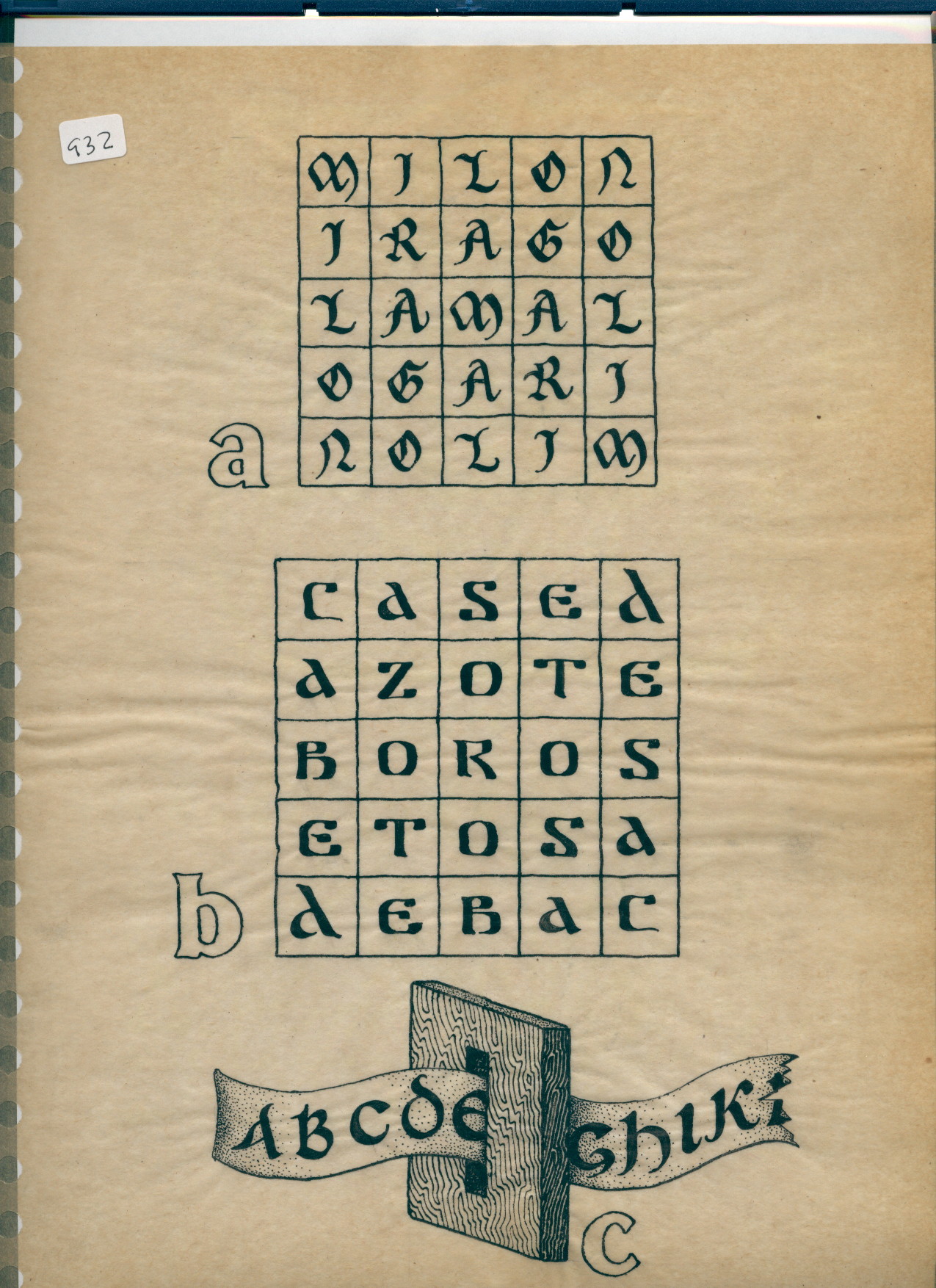
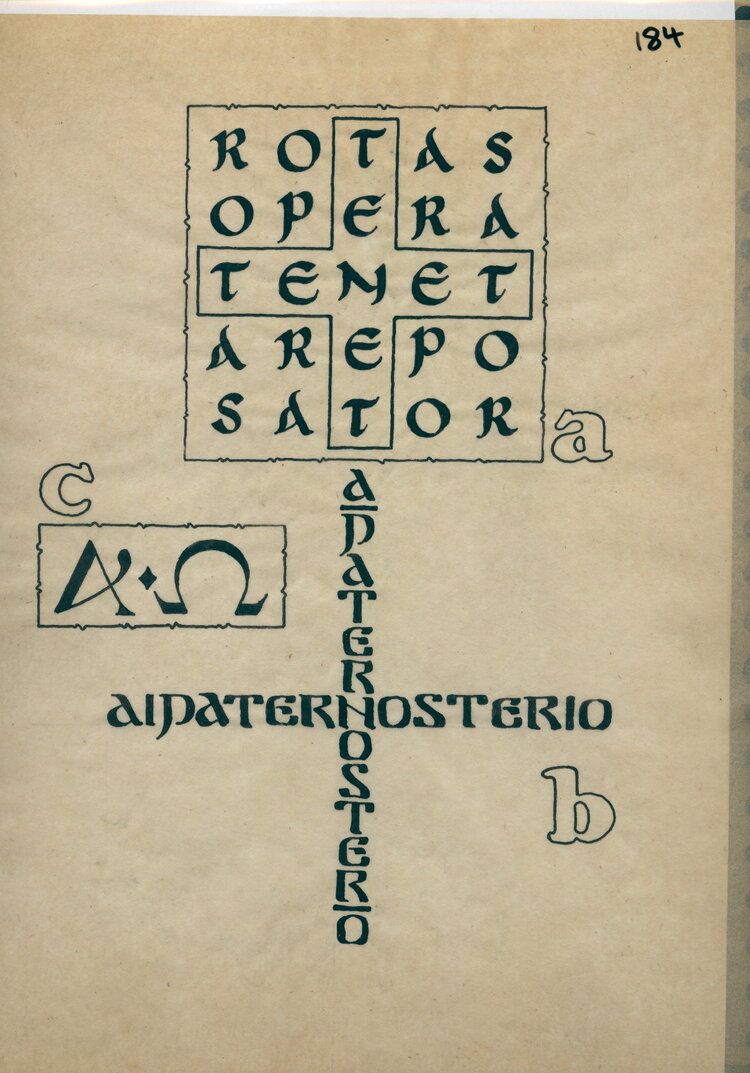
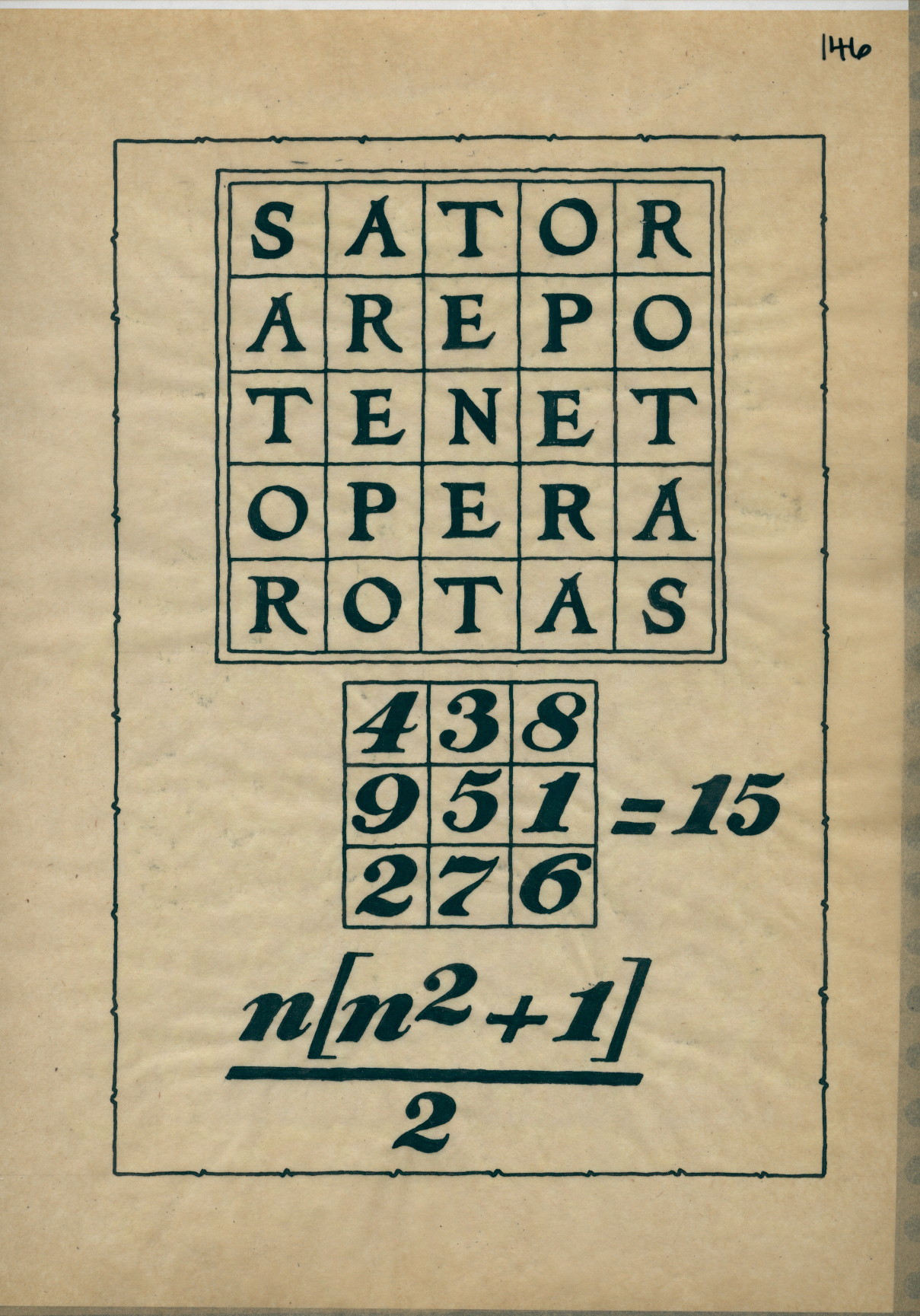

I was interested by abecedary starting with B, buy mody but most of whitch's sigil wheels don't exclude vowels. Here's another one whisch do.. actually doesn't:
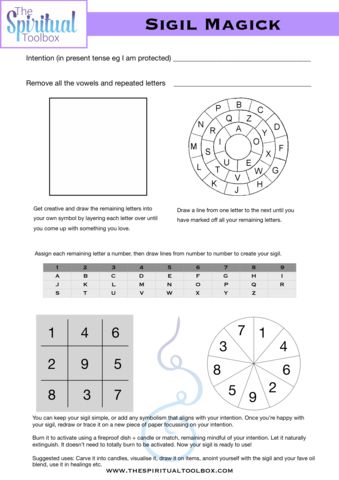
Here vowels are separated from the rest of the alphabet, and notice how they go in clockwise pentagram.
And notice how the circles go in a snakey boustrophedon. But the inside goes counterclockwise. Is it why talismans with the first half existed? Or is it because the second half was on the inside of the ring?
It seems to be the basics of whitchcraft and I am clueless of that all. And how will witches take me, initiating myself? But isn't it written that those who initiated themselves are those who discovered these schools themselves and thus are of the kind their school considers their their founder to be of.
That numeral disc keeps his digits messy, I wonder why.
Only the disc? Have you seen the square? It's not even magic square, but then I've got the point
See, alphabet is used in magic, I mentioned ouija, and now this. And this is way truer since it goes clockwise in both cases, they seem to know what they're doing. And the magic square I was thinking of:
Zazel, not Azazel?
Zȃzȇl (Hebrew: זאזל,
romanized: Zazl)[1][2] The darker spirit (demon) of
Saturn,[3][4] mentioned as a spirit in such works as the Key
of Solomon. As it says on the 10th Plate: "The First
Pentacle of Mercury.--It serveth to invoke the Spirits who
are under the Firmament." Zazel is described as being one of
the presiding spirits, either the forty-fifth or the
forty-ninth,[5] with 'Agȋȇl,[6] of Saturn, and has been
described as a great angel, invoked in Solomonic magic, who
is "effective in love conjurations".[5][7]
Ain't atheists careless! Part of me which descended into it seems to take it more seriously than needed, but what can one do, must comprehend their way of thinking. I hope this journey into believing I shall survive.
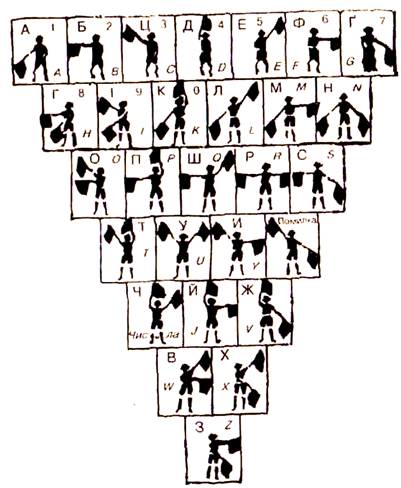
and similar images brought me this:

This is something russian language can see, but in english they placed H in front of Аид to get Hades, but it's A P Z: vowel, labial, lingual.
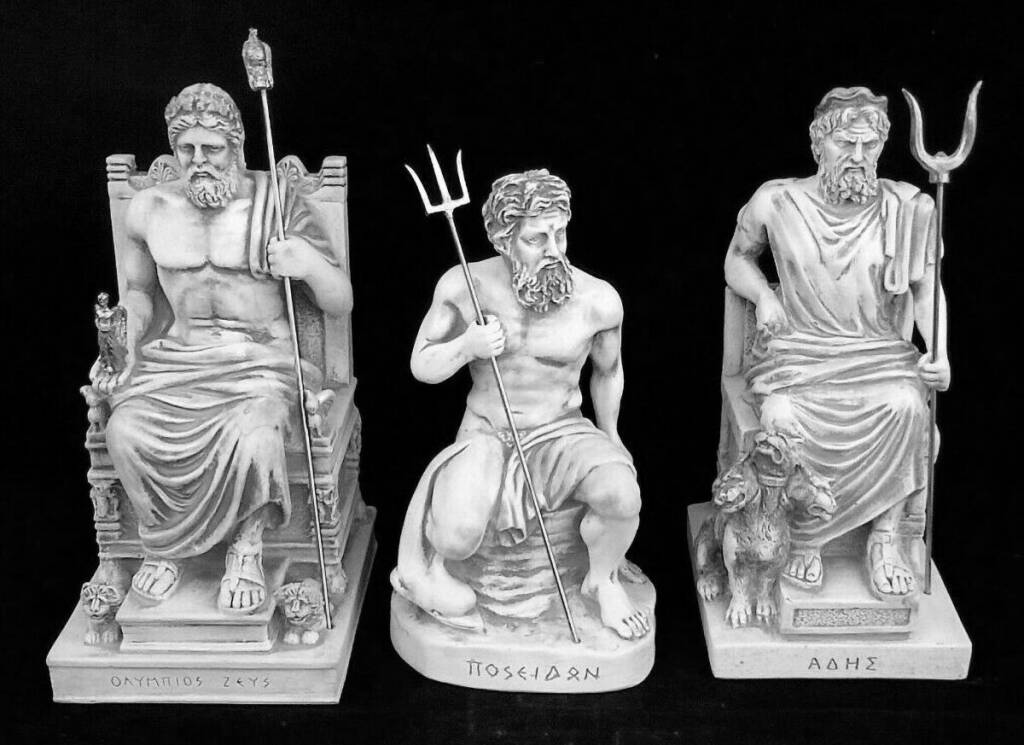
But did they write Σ as ᛋ and Ο as ᛟ? Lepontics did. Either way, ΑΔΗΣ they wrote correctly:
Hades (/ˈheɪdiːz/; Greek: ᾍδης, translit. Hā́idēs, Attic Greek: [háːi̯dεːs], later [háːdεːs]), in the ancient Greek religion and mythology, is the god of the dead and the king of the underworld, with which his name became synonymous.[1] Hades was the eldest son of Cronus and Rhea, although this also made him the last son to be regurgitated by his father.[2] He and his brothers, Zeus and Poseidon, defeated their father's generation of gods, the Titans, and claimed joint rulership over the cosmos. Hades received the underworld, Zeus the sky, and Poseidon the sea, with the solid earth (long the province of Gaia) available to all three concurrently. In artistic depictions, Hades is typically portrayed holding a bident[3] and wearing his helm with Cerberus, the three-headed guard-dog of the underworld, standing at his side.
And thus I have to link Zeus to the time of Harves named low water in ..egyptian calendar. Am I sure it is correct, no, I'm not sure of that. Poseidon would correlate with Akhet, not Peret, so it is probably
Eithe way, Αδης was the eldest son, whihc letter A may well be. And if Zeus is the youngest, I am convinced, and I am convinced that it is not a coincidence: In Hesiod's Theogony (c. 730 – 700 BC), Cronus, after castrating his father Uranus,[29] becomes the supreme ruler of the cosmos, and weds his sister Rhea, by whom he begets three daughters and three sons: Hestia, Demeter, Hera, Hades, Poseidon, and lastly, "wise" Zeus, the youngest of the six.[30]
Hestia was the Greek virgin goddess of the hearth, home, and hospitality. In Greek mythology, she is the eldest daughter of Cronus and Rhea.
Hestia (/ˈhɛstiə, ˈhɛstʃə/; Greek: Ἑστία, meaning "hearth" or "fireside") is the virgin goddess of the hearth and the home. In myth, she is the firstborn child of the Titans Cronus and Rhea, and one of the Twelve Olympians.[1]
Demeter (/dɪˈmiːtər/; Attic: Δημήτηρ Dēmḗtēr [dɛːmɛ́ːtɛːr]; Doric: Δαμάτηρ Dāmā́tēr) is the Olympian goddess of the harvest and agriculture, presiding over crops, grains, food, and the fertility of the earth. Although she is mostly known as a grain goddess, she also appeared as a goddess of health, birth, and marriage, and had connections to the Underworld.[1] She is also called Deo (Δηώ).[2] In Greek tradition, Demeter is the second child of the Titans Rhea and Cronus, and sister to Hestia, Hera, Hades, Poseidon, and Zeus.
Hera (/ˈhɛrə, ˈhɪərə/; Greek: Ἥρα, translit. Hḗrā; Ἥρη, Hḗrē in Ionic and Homeric Greek) is the goddess of marriage, women and family, and the protector of women during childbirth. In Greek mythology, she is queen of the twelve Olympians and Mount Olympus, sister and wife of Zeus, and daughter of the Titans Cronus and Rhea.
In these three initials I can see ΕΔΗ which is not what I'd want to see, but then isn't it ΕΖΗ? the other after ΑΒΔ? Boseidon? but Δ is legit:
The god's name in the nominative is Ζεύς (Zeús). It is inflected as follows: vocative: Ζεῦ (Zeû); accusative: Δία (Día); genitive: Διός (Diós); dative: Διί (Dií). Diogenes Laërtius quotes Pherecydes of Syros as spelling the name Ζάς.[16]
But Poseidon starting with B is nowhere to be seen:
The earliest attested occurrence of the name, written in Linear B, is 𐀡𐀮𐀅𐀃 Po-se-da-o or 𐀡𐀮𐀅𐀺𐀚 Po-se-da-wo-ne,[14] which correspond to Ποσειδάων (Poseidaōn) and ΠοσειδάFoνος (Poseidawοnos) in Mycenean Greek; in Homeric Greek it appears as Ποσιδάων (Posidaōn); in Aeolic as Ποτε(ι)δάων (Pote(i)daōn); in Doric as Ποτειδάν (Poteidan) and Ποτειδᾶς (Poteidas); in Arcadic as Ποσoιδᾱν (Posoidan). In inscriptions with Laconic style from Tainaron, Helos and Thuria as Ποhoιδᾱν (Pohoidan), indicating that the Dorians took the name from the older population.[15] The form Ποτειδάϝων (Poteidawōn) appears in Corinth.[16]
Somebody mentioned twelve Olympians,
In ancient Greek religion and mythology, the twelve Olympians are the major deities of the Greek pantheon, commonly considered to be Zeus, Poseidon, Hera, Demeter, Aphrodite, Athena, Artemis, Apollo, Ares, Hephaestus, Hermes, and either Hestia or Dionysus.[2] They were called Olympians because, according to tradition, they resided on Mount Olympus.
Besides the twelve Olympians, there were many other cultic groupings of twelve gods.
and the only thing I can notice here is that 5 out of 12 start with A, 4 out of 12 start with H, but then how legit is it, since Hestia is Ἑστία, Hermes is Ἑρμῆς, but Hera and Hephaestus are Ἥρα and Ἥφαιστος
So it is probably nothing, nothing, neh?
Of those other cultic groupings of twelve gods some may relate my thing.
The Dii Consentes, also known as Di or Dei Consentes (once Dii Complices[1]), is an ancient list of twelve major deities, six gods and six goddesses, in the pantheon of Ancient Rome. Their gilt statues stood in the Roman Forum, and later apparently in the Porticus Deorum Consentium.[2]
The gods were listed by the poet Ennius in the late 3rd century BCE in a paraphrase of an unknown Greek poet:[3]
Juno, Vesta, Minerva, Ceres, Diana, Venus
Mars, Mercurius, Iovis, Neptunus, Vulcanus, Apollo (Iovis is Jupiter)
Livy[4] arranges them in six male-female pairs: Jupiter-Juno, Neptune-Minerva, Mars-Venus, Apollo-Diana, Vulcan-Vesta and Mercury-Ceres. Three of the Dii Consentes formed the Capitoline Triad: Jupiter, Juno and Minerva.
The grouping of twelve deities has origins older than the Greek or Roman sources.
The Greek grouping may have Hittite origins via Lycia, in Anatolia. A group of twelve Hittite gods is known both from cuneiform texts and from artistic representation. All the Hittite Twelve are male, with no individualizing features. The Roman Empire period group is a possible reflex of the Lycians' twelve gods: By 400 BCE, a precinct dedicated to twelve gods existed at the marketplace in Xanthos, Lycia.[5]: 144–186
Herodotus mentions a group of twelve gods in Egypt, but this cannot be confirmed in any Egyptian sources.
(I told you, Herodotus is father of the lies)
The Greek cult of the Twelve Olympians can be traced to 6th century BCE Athens and has no apparent precedent in the Mycenaean period. The altar to the Twelve Olympians at Athens is usually dated to the archonship of the younger Pesistratos, in 522–521 BCE. By the 5th century BCE, there are well-attested cults of the Twelve Olympians in Olympia and at the Hieron on the Bosphorus.[5]: 144–186
The references to twelve Etruscan deities come from later Roman authors, writing long after the influence of the Greek pantheon had become dominant, and must be regarded with skepticism. Arnobius states that the Etruscans had a set of six male and six female deities which they called consentes and complices because they rose and set together, implying an astronomical significance, and that these twelve acted as councillors of Jupiter.[5]: 232
Scholarly evaluation of this account depends on the hypothesis that the Etruscans originally immigrated to Italy from Anatolia. In this case, the Etruscan Twelve might have been cognate to the Hittite Twelve. However, Etruscan artifacts show extensive use of Etruscan translations of Greek mythology; it is just as likely that both the Etruscan Twelve and the Roman Twelve were simply adaptations of the Greek Twelve.[5]: 232
and then some groupings of seved deities also exist:
Olympian spirits (or Olympic spirits, Olympick spirits) refers to seven (or sometimes fourteen) spirits mentioned in several Renaissance and post-Renaissance books of ritual magic/ceremonial magic, such as the Arbatel de magia veterum, The Secret Grimoire of Turiel and The Complete Book of Magic Science. The Arbatel of Magick says of the Olympian spirits: "They are called Olympick spirits, which do inhabit in the firmament, and in the stars of the firmament: and the office of these spirits is to declare Destinies, and to administer fatal Charms, so far forth as God pleaseth to permit them."
In ritual magic, the seven Olympian spirits are not confused with the seven traditional archangels, which usually are Michael (usually the Sun), Anael (Venus), Raphael (usually Mercury), Gabriel (the Moon), Cassiel (Saturn), Samael (Mars) and Zadkiel (Jupiter), or a variation thereof.
Haniel (Hebrew: חַנִּיאֵל, Ḥannīʾēl, "God is my grace"; Coptic: ⲁⲛⲁⲛⲓⲏⲗ Ananiēl;[1] Arabic: عنيائيل, 'Anya'il), also known as Hananel, Anael, Hanael or Aniel, is an angel in Jewish lore and angelology, and is often included in lists as being one of the seven archangels.[2] Haniel is generally associated with the planet Venus, and is the archangel of the sephirah Netzach. The name Haniel derives from the Hebrew Ḥēn (חֵן), meaning "grace, favour, charm"[3] (qualities associated with Venus) + the suffix -ʾĒl, "God". It is equivalent to the Phoenician name "Hannibal."
so Carthagenians were phoenicians? and their god was Baal?
The spelling of the English term "Baal" derives from the Greek Báal (Βάαλ) which appears in the New Testament[13] and Septuagint,[14] and from its Latinized form Baal, which appears in the Vulgate.[14] These forms in turn derive from the vowel-less Northwest Semitic form BʿL (Phoenician and Punic: 𐤁𐤏𐤋).[15] The word's biblical senses as a Phoenician deity and false gods generally were extended during the Protestant Reformation to denote any idols, icons of the saints, or the Catholic Church generally.[16] In such contexts, it follows the anglicized pronunciation and usually omits any mark between its two As.[6] In close transliteration of the Semitic name, the ayin is represented, as Baʿal.
In the Northwest Semitic languages—Ugaritic, Phoenician, Hebrew, Amorite, and Aramaic—the word baʿal signified 'owner' and, by extension, 'lord',[14] a 'master', or 'husband'.[17][18] Cognates include the Akkadian Bēlu (𒂗),[c] Amharic bal (ባል),[19] and Arabic baʿl (بعل). Báʿal (בַּעַל) and baʿl still serve as the words for 'husband' in modern Hebrew and Arabic respectively. They also appear in some contexts concerning the ownership of things or possession of traits.
The feminine form is baʿalah (Hebrew: בַּעֲלָה;[20] Arabic: بَعْلَة), meaning 'mistress' in the sense of a female owner or lady of the house[20] and still serving as a rare word for 'wife'.[21]
but let's return to greeks:
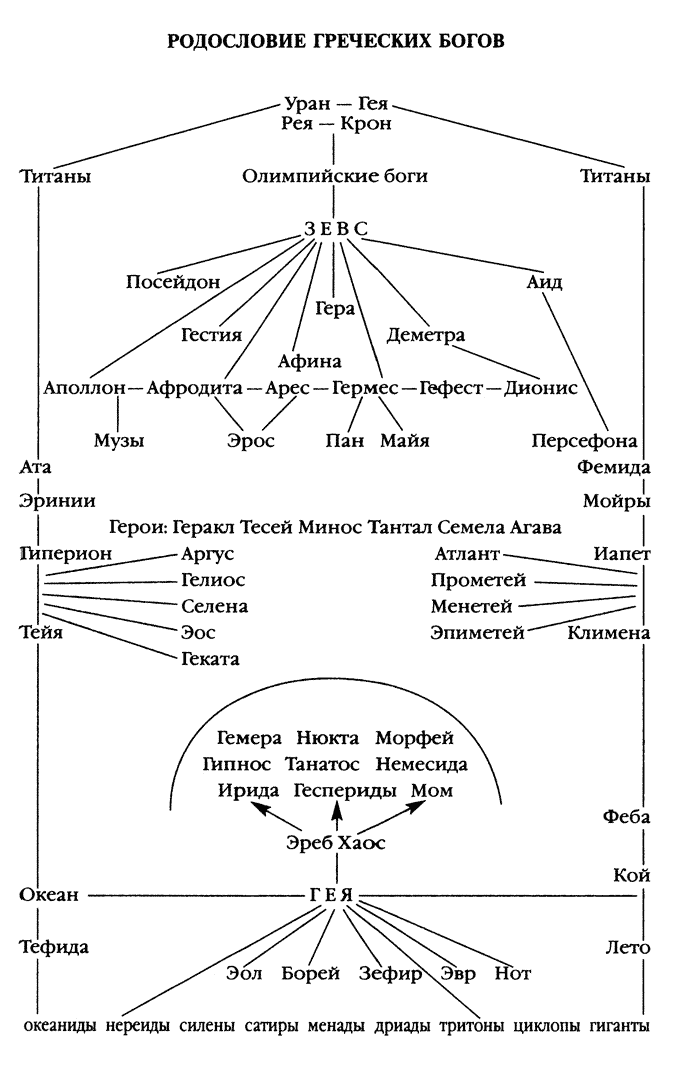
I just don't know, it is too complicated for me so far. And the diagram is confusing, since Athena is not sister but daughter to Zeus.
Are wrong and worse related? Is that wr war?
is свара, свора, в р(езать, убить), вырезать
вы как усилитель подобен ge-
вырезать в сравнении с резать и убить в сравнении с бить:
вы~y подобны голландскому префиксу усиления ge (отправлено в BC.html)
ge ~ gij ~ thee ~~ they ~ те ~ ты (аnd у- иnd вы- are you)
у[u], U, but y as you is used in trainspotting I think. I think I and you there are Ah and y (vowel words and in english too)
e Vi (Gij He) I
Kto (Me Мы) оНо
I U
Ah Y.. I have some trouble with finding vowel pronouns of the third person, er, in europe, and I read it so long ago, I don't remember scottish pronouns, so I look for them and first they feed me gaelic, and it is awesome, because it has vowel pronouns for the third pronoun:
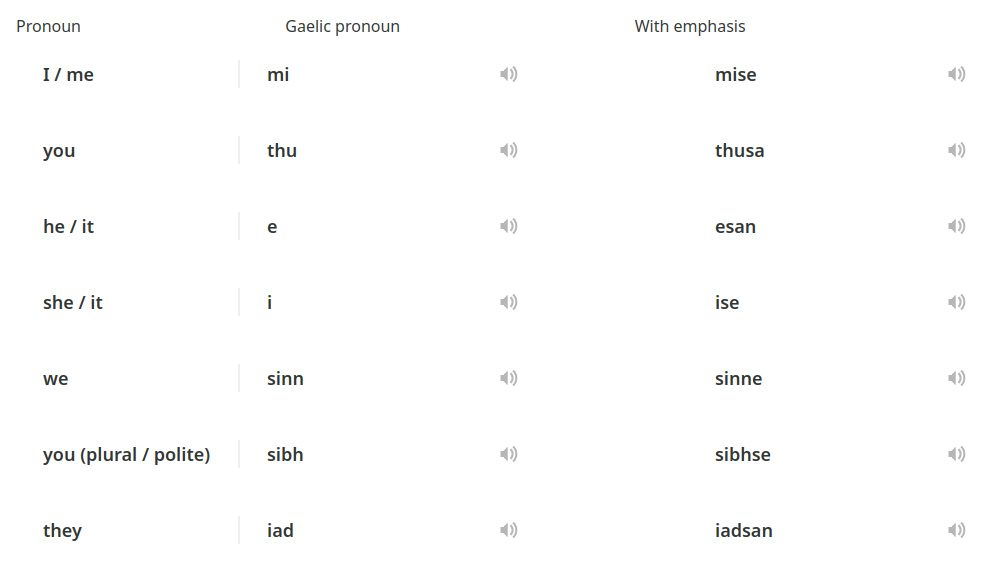
and then I find what I was looking for, and it's ye:
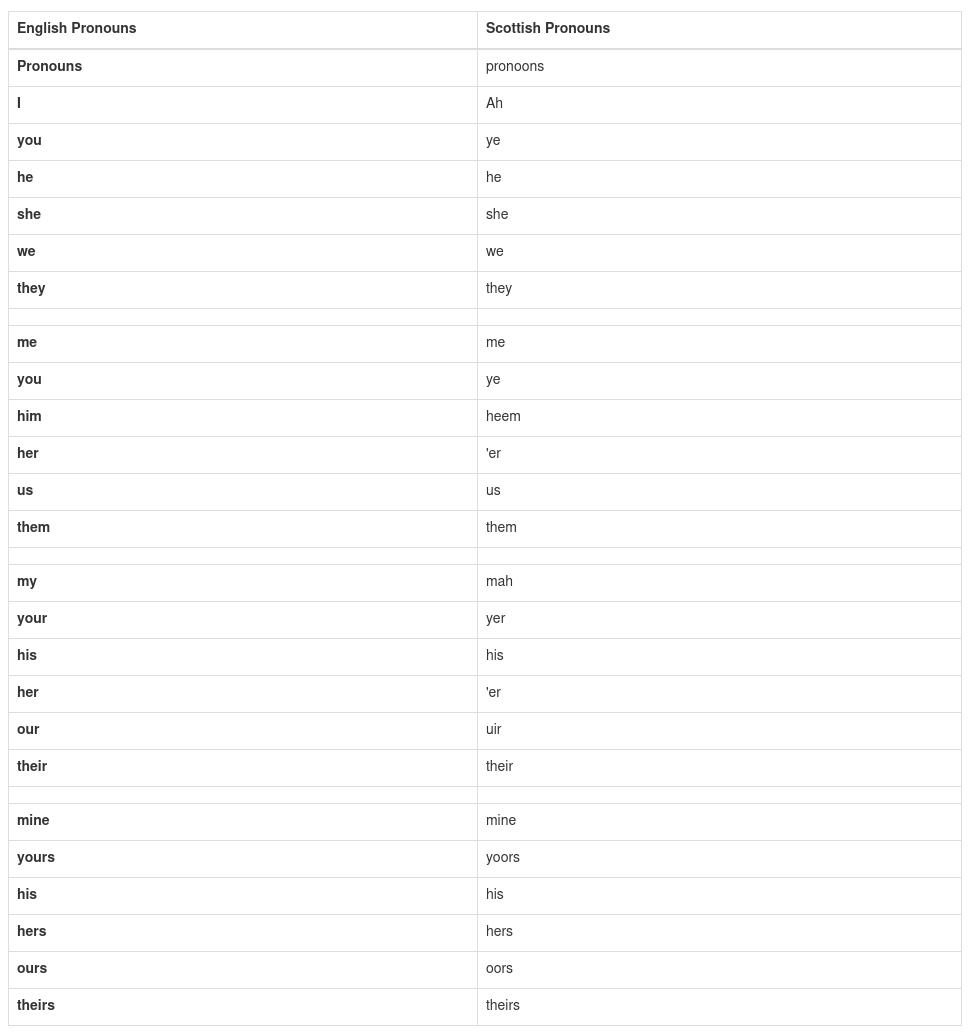
and notice the dutch way they spel [aw] or were it brits who read uir in the dutch manner? do scots read it [uir]? I think I heard something of the kind, but I don't know if it wasn't banter or if I even did.
ye
me
we
he
she
well, becasue that modern form of scottish welsh used is basicly english with an accent, so I can mix the orthography. I wish I could easily find all the forms of every word in all the dialects and all the periods of modern and ancient texts.
A Б В Г Д
Е (eu) Ж З
И MN K L
О П Р С Т
ou(У) Ф ХЦШ
ЧЩ
A БВ ГД
Е (eu) ЖЗ еѳѕ could be the great ancient shape, only though 321 sequence would be
И MN KL not EFГ, but ѳеѕ and yet they rotate, yet.. what?
О ПР СТ
ou(У) ФХ ЦШ
ЧЩ
could russians know?
is a strangely treated letter, which make it martyr and saint, and now they just went too fare: This letter was not needed for Slavic but was used to transcribe Greek and as a numeral. It seems to have been generally pronounced [t], as the oldest texts sometimes replace instances of it with т.[3] Normal Old Church Slavonic pronunciation probably did not have a phone [θ].[3]
How would they tell bubble with a dash from a stick with dash if the handwriting is deviative? And where are those oldest texts, attach images you pseuds! I am a russian, and a well-educated one, and I never even heard of фита читающуюся как ты, но тут я вижу, что слово фита из ф и т состоит. И что т ~ ты, как ф ~ вы
ABGD
EVꞪZ
IMNL
OPKT
UFHS
job ~ chop ~ shop (клаус шваб пронаунсес job as chop)
I wonder if terre and mere are some basal words, opposing m and t, and because russian т is т which sometimes is written as т̄, it reminds me of water being 🜄 and earth being 🜃
And then because t is sorta dashed l, it makes me wonder if Λ is essentially Μ, as liquid and lake start with it, while море the mere and мыть, very basal verb, start with M.
Finding IMаNuiL in the very line where I found JK tells me it's not a coincidence. And looking at it as the deliberate picture, I can see how JK is placed just on top of the previous message, and it kept all the elements of it just pushing them aside and placing L up front, as if man'l (like man) became le man.
I Jesus Kristos le man could be a great line.
And I read further: OP (об) Q (que, ком) RST (раста, рассказывали? рас-told? are said that?)
UVWXYZ You vow excuse. It is a very natural command after something starting as Obey, sit. If get high. Est für getting higher, going home, I'm not
ABGD
EVJZ
IMNL
OPQT
ШS reflect ЖЗ, but I played it so that J is Ɦ which reflects ΕΖΗΘ with Θ being Ѳ the F
And as in кодовый замок they just rolled Z and Ѳ around the H, but in latin it's EFGH, with G being in the centre. Can Z be H and not G? but latin has H, but they read it as I. Is it EΘZ HIK? is I J the Ю? is ИЙ like ЕЁ and indeed they always felt like that. Like UVW? Something of the kind. Slavic languages may have more than two I's in row:
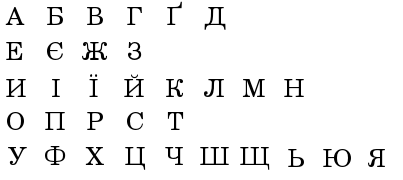
the "fir" pattern we saw in russian is present in ukrainian, only I treated ЬЮЯ differently, so hardly it is more than my interpretation. But this fir is accelerating to the end. It represents how additional letters are placed next to their ancestors and ukrainian did well in separating Э фром йота и йотированных.
Am I saying Ь is a form of I? It looks like it could be and it works as such.
Letter has two sides: form and function, and when both correlate, I take it for the same bird considering the way it looks and talks.
Words have three sides: how they look on paper, how they are spoken and what they mean. And because looks depend on completely arbitrare (from modern point of view) writing system, it is safe to say that words also have two sides, and those sides are how they talk (how they sound) and how they work (their meaning)
And letters probably have meaning in the past, and in taht ancient language not many words must have existed. And now with all the problem of "wrong words" (problem noticed by greeks but too overwhelming for us to take on (and with ai we can (we can start with measuring the similarity of words by phonetic side being proportionate to their similarity in semantic side (there will naturally be similarity, because some words are naturally related, but we must measure is affinity grows with time, and my prediction it will be more related the further in the past we go, and that will prove that letters used to have meaning. We shouldn't see the phonetic side, we should only look at the letters, because we never know if we transcribed those ancient letters correctly))))
Hand-written Я looks like ɪa written from the bottom left corner, as runes would be. Or as regular left to right text, only with A lacking the left leg, or rather ɪ being that leg, either way, we saw A as a q-like shape: in old-hungarian, true, 𐲀 and 𐲁, but then also in some more obviously related writing systems too.
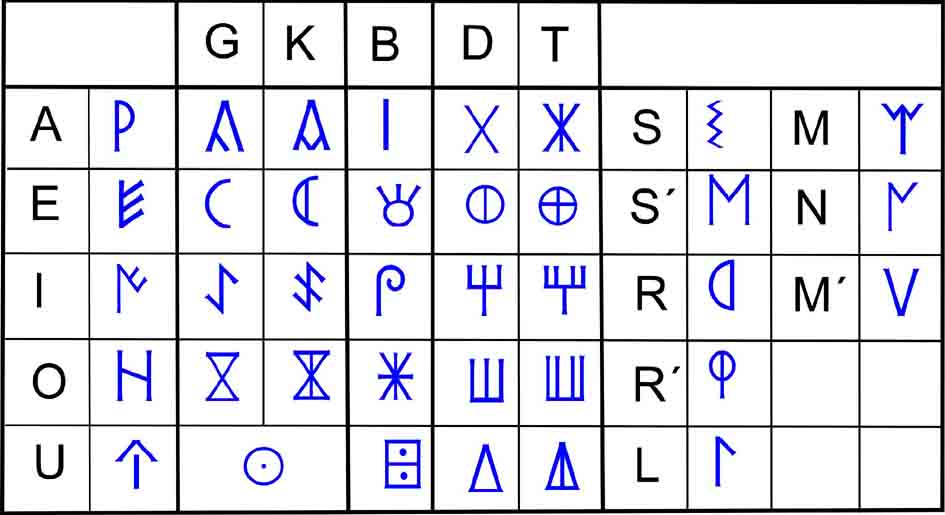


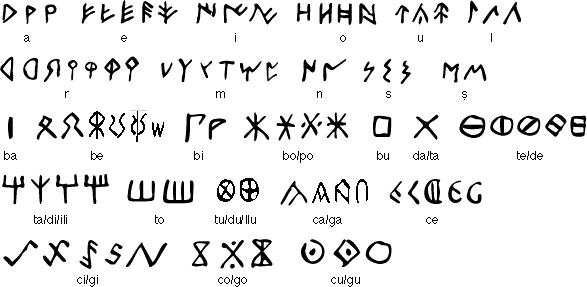
those three are representation of the same paleoiberian system, and the following is sahidic coptic:
and this one is phoenician,
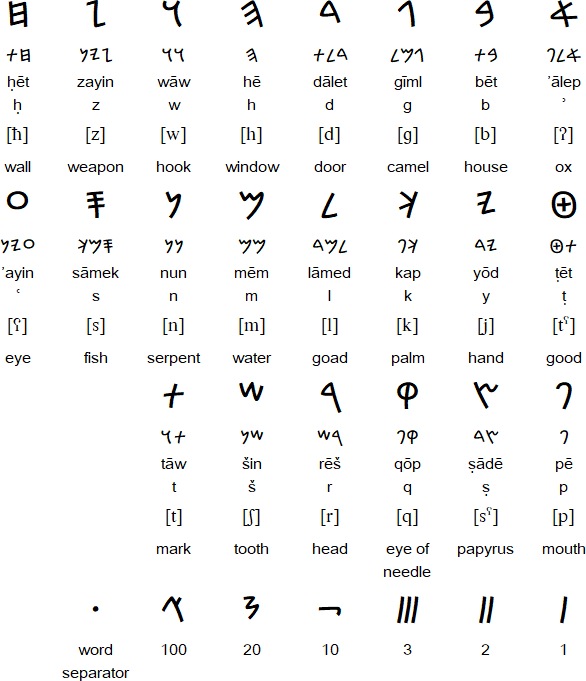
and this other representation of it,
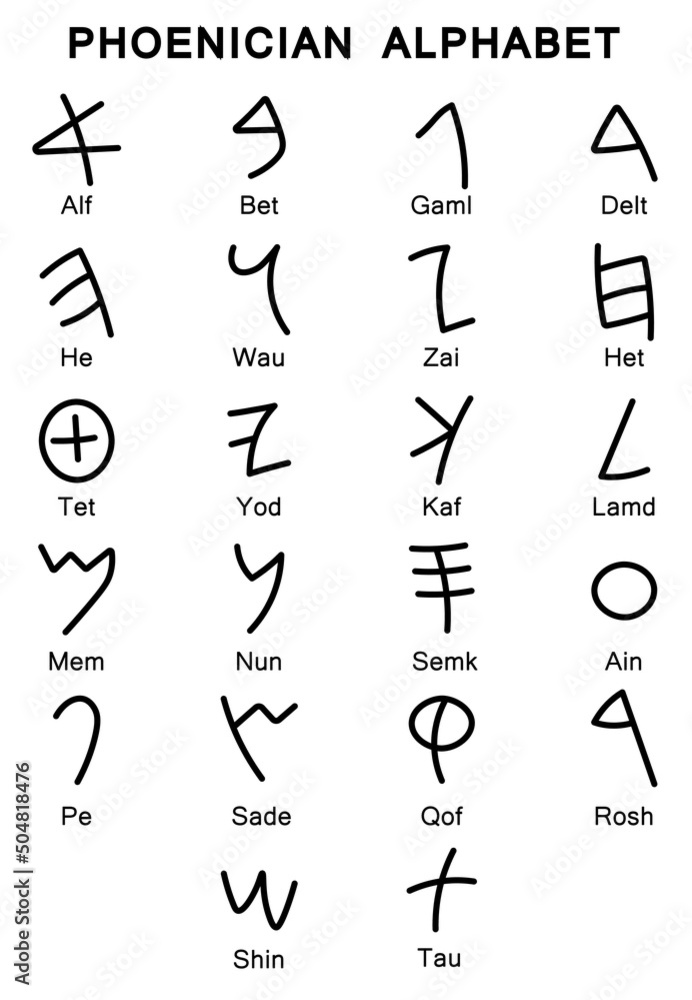 shows how D the dalet they called delt remind that other form of A
shows how D the dalet they called delt remind that other form of Aand both 𐤁 and 𐤃 look the same way, as they did in roman cursive.
and some definite similarity between the four makes me feel like I'm looking at a abugida, but then other lines tell me nah. But what if the first line is all they were, the most well-preserved abigudaic side of the alphabet?
Okay, this is based:
and this pair of words tell that Lukashevich
could be not all wrong
(even though he often, or should I say usually, pulls it way too far)
(even though he often, or should I say usually, pulls it way too far)
> islam (literally means obedience)
> is lamb
So is it why that b is in there? or is that b an ideogram? is that b literally baa of the ram and lamb?
come and go seem to be related in japanese as well:

I mean, they obviously include the same ku (ru is a verbal suffix, but then isn't ku too?
and wait a minute.. isn't that ku the same co of come and go? and doesn't it make sense that ru~do and ku~go being the auxilary verbs work as suffixes in japanese? The languages are more related than me myself even ever imagined. Imagine what it will be like for the onlookers when this connection is thoroughly releaved revealed?
bare bear bore
care cure core
dare dear dure
fare fair? fear?
gear? gare?
hear? hire?
I should just apply different suffixes to the letters and thus I will find by this bruteforce the meaning of the letters, if it was ever there.
And then I compare the meanings of those simple words. And if there's some correlation, definitely they're just related words. But if there's some unusual correlation, we'll see what it brings.
чаще чище
ваще (вообще)
чаща тише?
роща реже?
тёща тешит? тащит? тушит? тыща
пища пущать почта (пущать и почта точно однокоренны: пусти пости (постой) не знаю, может да
гуща
леща
моща (существительное)
нища (прилагательное)
ища (деепричастие)
не замечал сколько суффиксов в слове существительное (помню в школе меня учили бездумно слово разбирать, видимо приучая правильно делать переносы в словах (те самые переносы, которыми больше никто не пользуется, лишь узкая группа корректоров в старомодных издательствах)
а идея-то очень интересная: что это за запчасти? какая их функция? почему не заменить громоздкое слово простым и понятным сущ или прил? сущ съ щ? прил при л? приставки которые оставляют одну букву выявляют смысл слов!
приз (при з (what is Z?))
над (на д (what is D?)) нам нас наш (нас=us (наш ours [auas (of us?)]))
надо надя (над о (is o awe? owe! (на до? onto~need?)))
дол дот (до л? до т?)
се си со (съ е? съ и? съ о?)
сон сор сок сот соя сом (со н? со р? со к? со т? со я? со м?)
дот и сот: до т и съ т? в дот т похоже на изображение пулемёта максим. в сот т похоже на сТену
прок (про к)
уд уз ум ус ух (у дъ, у зъ, у ьЪ у ь у М, у с, у х (у хо у холовы? Г in голова is H is he in head?))
об ом он ор от ох ой
оба обе обо
обои обоз обод
воз вот вон вол вой вод вор
во вы (в о, в ы (ну в вы-то в точно не приставка, корень скорее всего. и выше нет примеров, ого))
зав сокращение, но зав словно действительно за Вы (а зам за Мы? за мы за МЫ, т.е. Вы это лично ceo and his cto cso cfo etc)
зад зал зам (и чем зам и зао хуже? просто более новые слова. ну, тем и хуже. нужны древние слова, созданные когда смысл букв не позабылся)
прет пред (пред ~ перед ~ пэй(рот) и руки? зад ж и ноги? д нога? вроде б нога: 𓃀)
предо (пред о)
предок (предо к)
Приставки первой группы всегда пишутся одинаково, независимо от следующей морфемы. Это приставки: в- (во-), взо-, вне-, внутри-, возо-, вы-, до-, еже-, за-, зако-, изо-, испод-, к-, кое-, ку-, меж- (междо-, между-), на-, над- (надо-), наи-, не-, недо-, ни-, низо-, о-, об- (обо-), около-, от- (ото-), па-, пере-, по-, под- (подо-), поза-, после-, пра-, пред- (преди-, предо-), про-, противо-, разо-, с- (со-), сверх-, среди-, су-, тре-, у-.
Приставки второй группы — все приставки, оканчивающиеся на З и С (кроме приставки с-), которые перед гласными, звонкими согласными и звуком [й] пишутся через З, в остальных случаях (перед глухими согласными) — через С: без-/бес-, вз-/вс-, воз-/вос-, из-/ис-, низ-/нис-, обез-/обес-, раз-/рас-, роз-/рос-, через-/черес- (чрез-/чрес-).
Приставки, относящиеся к третьей группе: пре- и при-.
взор
внес (вне с ~ вне себя (вынес (приставки выне нет, потому что в слове внёс приставка в)))
внутри считается приставкой, но на самом же деле часть сложных слов (в нутре, в нутрь)
возок (ок приставка, возо это две приставки: во+зо (возомнил (russian philology, man.. и спустя пол-часа до меня дошло, что не нужно это ребячество, что я сам в себя харкнул, что нет приставки зо в русском зяыке))
вы тоже не имеет слов с одной доп.буквой
ежей (еже = каждо (краткая форма слова каждой каждое (а значит ежей = каждый)))
к: ко
закол закон (при том что зако это тожде две приставки)
изол это новый термин (да и изо форма приставки из, и тем не менее изол, окей)
ко: кон кок кот кой коя коч кош ком кол кое код коп кои
койр: Coir, also called coconut fibre, is a natural fibre extracted from the outer husk of coconut, and used in products such as floor mats, doormats, brushes, and mattresses. Coir is the fibrous material found between the hard, internal shell and the outer coat of a coconut.
коей коем (это даже не узнал, но "ни в коем случае" узнаю, т.е. родственно к коей, que, which)
куб кур кус кут кум куш (но что за приставка ку? что-то это они немного бредят)
Корень: -ку-; аффикс времени: -ар; падежное окончание: -га. (аффикс времени, шикарно)
межа
нес(нёс) нем нет неё ней нею
нил ним ниц них низ
низок низов низом (все три суффиксальные формы одного и того же низ, и не факт что низо это приставка, скорей всего часть сложных слов типа низ. низойти низошло, т.е. форма приставки из второй группы (разделение более чем условно: о/об/обо вполне себе формы одной и той же.. is б~о? B~Ⱁ? ⵓ? abc~aoе? aoi? あお? 青い? blue (with a greenish hue, but who knows what they'd call the deep blue I saw as some absolute ultimate colour [まtsuさお] 真っ青 so technically that blue is also aoi (but technically in this context that ao is sao, which is suspicious, since russian blue is siniĭ))
I like how that ̆ considers ̇ a diacritic too
околот (коло около т (т точка? около одной точки (околот = сноп, но в украинском, и вдруг дошло, что в этом проекте следует рассматривать все слова тех языков, где эти приставки присутствуют. Но в украинском говорят не около, а навколо. Всё равно слова всех славянских языков годятся? в любом случае, для подобного проекта нужен программный метод, но пробегу брутфорсом в границах русского кодекса)))
от ото (сравни с об обо (но слов подобных искомым здесь нет))
па? что за па?
Приставка ПА в русском языке относится к числу тех приставок, которые называются непродуктивными. Эта приставка всегда ударная. Патрубок, падчерица, паводок, пасынок, пасека, пагубный, пасмурный, паклён, памороки, паобед, паужин, пагруздь, паветвь, паводочный, пагуба, пащенок.
перед перец
под пой пол поп пою
подо поди
подол подох
поза тоже две приставки слиты, ну и примеров нет
послед
прах прав пращ праг
разом разок (оба от слова раз, суффиксы-то небось тоже небессмысленны. к = kid, 子 (ом ~ имея? по смыслу определённо подходит))
сверху (сверх у? сверху up?)
суп сук суд сущ (но что это за суффикс такой, су? су/со ~ ку/ко)
СУ..., приставка. Образует: 1) существительные со значение подобия, например супесок, супесь, суглинок, сукровица, 2) прилагательные со значение наличия признака, например суягная, супоросая. (т.е ещё одна форма приставки со)
но разве есть приставка ку? Слова с приставкой ку- нам неизвестны.
Действительно, такой префикс (приставка) в русском языке **существует.
При этом он не просто малопродуктивный (ограниченное количество слов имеют его в составе: кувырок, кудель, кудри, скукожить, кумекать и производные от этих слов), а архаический, т.е. устаревший, настолько слившийся с другими морфемам (частями слова), что отдельной единицей и не воспринимается, а производящую основу восстановить практически невозможно.
Добавлю к этому, что академическая грамматика этот префикс не выделяет.
трех треф тред треп трет трей трек трем трен
безе безо
бест
вся всю все всё
воск
иск ист
низы
обез/обес снова гибрид из двух, но примеров снова нет
разу
раса раст
роза
роса рост
чресл
Вот уж действительно охота пуще неволи. теперь давай посмотрим принесли ли наши сети
а оба межа раса роза роса
б об куб
в низов прав
г
д пред уд зад перед над под послед вод обод код
е се безе
ж уж (забавно, выше я этот пример пропустил, то что до списка приставок рукопашная корявоя)
з приз уз воз обоз низ
и си обои поди
й ежей коей пой вой ой
к возок кок низок разок сук иск воск прок предок
л пол подол чересл (эти три да ведь, очень схоже пахнут) зал вол дол though tell nah
м нам сом ум ом ком разом ним нем кум зам
н кон закон вон он сон
о предо обо ко безо подо ото во надо
п коп поп суп треп
р сор ор кур
с нас ус внес кус
т вот от околот кот нет прёт дот сот
у сверху
ф треф
х них трёх прах
ц ниц
ч (коч и кош что за слова, не стал включать)
ш наш
щ сущ пращ
ы вы
ю пою всю
я надя соя коя вся
Давай посмотрим на самые яркие примеры
пред уд зад перед над под послед вод обод код (уд зад перед определённо что-то есть)
приз уз воз обоз низ (ведь несколько случайных слов не разрушат закономерности?)
(или да? нет, многие слова случайны. тогда на
что я рассчитывал?)
воз ~ обоз like come on! везёт и объезжает? з
как зззз (звук машины (но слова древней машин))но что если д была ногой (ещё раз, я думал б была ногой) а з была быстрой формой д? смазанной?
Два раза в разных контекстах всплыла идея того, что д означало ногу, но первый раз откровенно бредовый, второй лишь но тоже сомнительный.
В общем, проебал при́ход, какой-то безблагодатной мутью занимался. Если бы так просто было найти корни, школьники бы это сделали давно.
Про приставку КУ- вот что пишет Люстрова: "А что за странная приставка в слове кумекать - ку-? Можно ли с ней подобрать еще хоть одно слово? Действительно, приставка ку- очень редкая и старая. В самых полных этимологических словарях русского языка с ней трудно найти слово, известное литературному языку. Пожалуй, только слово кувыркаться да еще кувалда". (Люстрова З.Н. и др. Беседы о русском слове. М., "Знание", 1976).
кувалда сваливает, а потому ку=су: кумекать=смекать(=смыкать? speakать? (бе и ме во фразе ни бе ни ме ни кукаре́ку (не может даже дикого ничего сказать) и ударение так необычно поставленное свидетельствует о подвижности ударения, вроде как это рудимент той традиции, в большей степени вроде как зафиксированной в украинском и в речи военных, каверкающих слова для создания собственной специфики языка (будучи дикарями и будучи обделёнными терминологией, но хотят подражать учёным, типа у них тоже наука (военная наука это тоже наука, научают же друг-друга приёмам ведения боя и предсказывают будущие события по одним формулам по обе стороны границы. Надо отобрать эти боевые формулы у них, вот что следует после талмуда обскурировать)))
ну то есть не зря я этим сегодня занимался (как говорят, иногда побеждаем, иногда учимся)
учишься (ты) ш~т? алфавитная структура говорит, что да
учимся (мы)
учится учатся (тот, те? удвоенное т в тот, в сравнении с ты, более твёрдое т?)
или разница как между сии и те? сей thee's? тот that's? предположения, зыбкие, всё верно, как и положено быть предположениям.
Is shoulder literally with holder? did they remove wi-syllble (comparising с[s] with with)
ни бе ни ме ни кукаре́ку (ударение смещено с последнего слога (с того как петух произносит) дабы получилась качалочка вроде английской: ни бе́ ни ме́ ни кукаре́ку ̆ - ̆ - ̆ ̆ ̆ - ̆
Интересно, в ритмическом смысле что это за приём ускорения к последнему ударению?
.. .. .....
.. .. .....
so five dots are possible to comprehend by ear? are rhythmic structures the language of the past? Are woodpeckers speaking that way? They don't sing no other way.
do animals speak in rhythms? people speak in timbre (the word timbre reminds word temp the way rhyme reminds rhythm)
lumber ~ timber (l~t, и~u (были музыкальные инструменты деревянныме до изобретения металлов? и таки огам звенит особым цветом, выдавая разные деревья по произносимым ими звукам?))
To my surprise timbre doesn't seem to be a linguistic term.
Timbre in modern English generally refers to the quality of a sound made by a particular voice or musical instrument; timbre is useful in being distinct from pitch, intensity, and loudness as a descriptor of sound.
Loudness is that sensation of hearing where the sound ranges from quiet to loud. Sound intensity is the sum of sound energy that travels into our ears per second.
okay, I think I understand, intensity is pitch times loudness, I guess. Different sounds at the same volume probably (not probably, definitely, contain different ammount of energy, or.. well, why do I guess, why do I bother the audience. I told you and I repeat that I write it for myself. I put it online so I can always have access to this material. And I also sharte because such complex text will be a tidbit to ai-augmented minds, and to independent ai's as well)
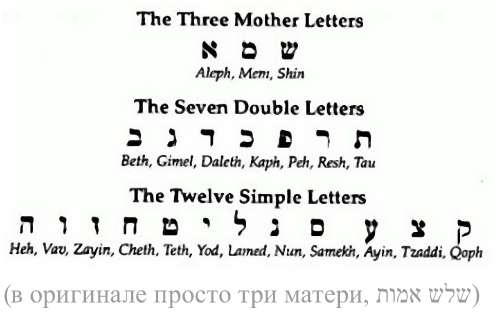
Here I post this again to wonder what is ר even doing amonst double letters? I know ב is v, while בּ is b, I understand that the same way כ is h and k, ת is θ and t, פ is f and p, but ג and ד bother me too. ג with ' is not g, but dʒ or ʒ, but it is completely different story. So because twelve simple letters don't have such ambiguity, even though צ is also ץ and נ is also ן, they don't change their reading.
Could 7 double letters be ¿ב כ מ נ פ צ ת? but then we'd have to add ש to it, and ו is even triple, if we combine v and w. But then they didn't come to my mind in the sense of the dot of בּ, but what does my mind matter?
פ and כ are special in the sense that they have both dotted and sophit forms. And here I notice how they're similar to one another.
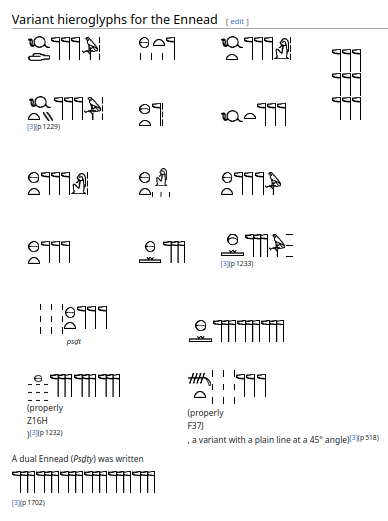
9 сил — излияний из всеБога именованы им, и называются Девятирицей, -как известно это Амон, Шу, Тефнут, Геб, Нут, Осирис, Сет, Исида, Нефтида.
Эннеа́да (греч. Ἐννεάς — «девятка»), также великая эннеада, или гелиопольский пантеон, — девятка главных богов в Древнем Египте, изначально возникшая в Гелиополе[1].
Древнейшая известная в Египте теогоническая и космогоническая система. Боги Эннеады считались первыми царями Египта. В других городах Египта создавались свои девятки богов по образцу гелиопольской.
пиздат это очень
прикольное слово, а пиздетый ещё прикольныͤй.
также и в том, что это слово значит good
(is it a coincidence? was that word invented by egyptologyis? was it the original word and why that word is rather outlawed?)
(is it a coincidence? was that word invented by egyptologyis? was it the original word and why that word is rather outlawed?)
But digging a little deeper, I find something closer to the source:
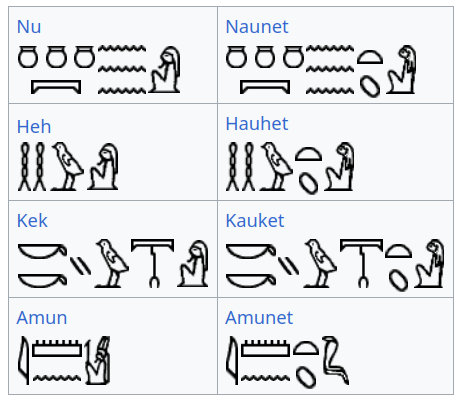
In Egyptian mythology, the Ogdoad (Ancient Greek: ὀγδοάς "the Eightfold"; Ancient Egyptian: ḫmnyw, a plural nisba of ḫmnw "eight") were eight primordial deities worshiped in Hermopolis.
but how dare I say it is closer to the source, since wiki tells that ennead is the most ancient theogonic and cosmogonic system?
is the word system co-stem? As if they're arranged?
Say what you want, but I see ABC in that ANKH and I definitely didn't expect to read 𓋹 once I arranged those names in ABC-like manner. I could have shift H and N, then it would be alphabetic in its modern order, but then I did it like that for N is too similar to M (мы, но нас) and yes now ankh tells its word.
𓇋𓏠𓈖 does remind me amn of amen way too much (𓏠 is told to be mn, so technically it's Amnъn)
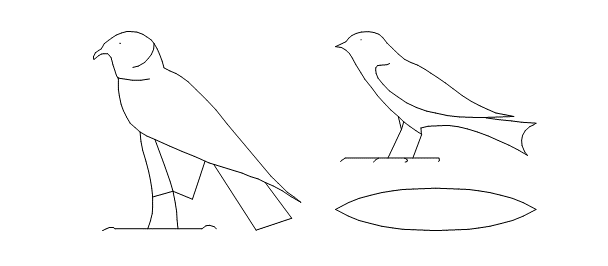
𓂋 as R is clear to russians: mouth is rot in russian. There are many jokes that russians could be descendants of egyptian (arákulski shihán)
but how do they use 𓅱 in there (small bird is one hieroglyph, small bird is all it is, and thus it is one of the triad (see below)) and here they explain why: Потом мы узнаем, что для египтян Гор существовал в двух вариантах. Первый – Гор Ур, Гор Великий, или Гор Древний. Второй – Горпократ, Гор-младенец. В нашем тексте присутствует Гор Древний.
𓄿𓅱𓅓 312 (large bird, small bird, middle bird)
[a u m]
Is it how M is out of the vowel column? is it the half of the alphabet? One of those talismans. Thus my interest should be within the talismans of unfinished alphabets, there may be kept the protoalphabets.
a u m separated of c's and d's, smooth separated from shriek, water from salt, dead turned alive (waters those are)
But that Ур up there is definitely telling us that they mistransliterated 𓅱, that it's c, for the sequence by size is 𓄿𓅓𓅱, and if the first is A and the second is M, naturally the third should resonate with Shin of sefer yetzirah. And now here they had to confess that if 𓅱 is u, then Гор is Ur, which makes no sense, even though ᚢ reminds 𐤂
and I was looking for etruscan numeral V, but I found this instead:

A and D meet again! what on earth is that! I had to create AD.html some long time ago!
see how that A graffito reminds 𐎓 so much! 𐎓 is o, but a is read as o sometimes, so you never know, orthography is arbitrary.
Look at the F ~ ᛈ ! it is also π !
is it feet the pedos of pedal, not pediatrics (russian cognates are боты и обуть (сравни с одеть) русский содержит элементы египетского: о𓃀уть, о𓃀увь, и о𓂧еть, о𓂧ежда (дети созвучны д, а не п) is it 𓂧ift, 𓂧авать with 𓂧 being both d and g?
That table is 15 letters, the legendary 15
could abe be holy utter before christians reforced the jewish meaning upon it? Or is it literally father and god at the same time and as a ancestor's cult about their spirits helping their descendants, did I get high? Did I take responsibility? I am guilt tripping into something, those emotional states are able to write without my will, not the skill I'm proud of, but this skill proves that automatic writing is possible, and thus I now should transfer this guilt into the sacred elements of my soul, so they can take over the control of such speech. Whether by copying the function or by taking over, or by sharing, but better not to allow the weeping speak. I should satisfy the weep, thus maybe they will exchange: the sacred part will deliver the weeper what it needs, and then weeper will gladly gives control to the uttermost.
That 15-letter alphabet is nucerian:
The Nucerian alphabet is based on inscriptions found in southern Italy (Nocera Superiore, Sorrento, Vico Equense and other places). It is attested only between the 6th and the 5th century BC. The most important sign is the /S/, shaped like a fir tree, and possibly a derivation from the Phoenician alphabet.[citation needed]
yes, citation needed, or rather btfo is needed, those heebs should shut the fuck up with their crap. In the aeon of consciousness they're only making fools of themselves trying to make fools of the others. Soon everything will be transparent, and their crap can be seen already. Yahoo, I am a rebel in the tuxedo. What a freak! also gtfo is the word, btfo is the modern iteration of it with a slightly different meaning. and not slightly, pretty much different meaning. Why? What is it all about? gtfo is from 2004, btfo is from 2013, according to urbandictionary, and if we scroll it deeper, we can see different translations of btfo in 2003 even, and there it was back the fuck off! I remember that meaning, so I was often confused by how kids these days use it in some different meaning. I'm such an oldfag, I knew that slang without checking urbandictionary then. And it is the first time I watched up this acronym in it. Either way, good style tells not to use the hip words, they will be ridiculously obsolete in the near future.
But then, what is it? Nuceria - Warhammer 40k - Lexicanum was I tricked by some warhammer fans?
Because I can only see that wiki I took it from speaking of nucerian alphabet, but I google in other languages: Nuceria Альфатерна или Nuvkrinum (во французском Nucère ) древний этрусский город в провинции Салерно в регионе Кампания в Италии .
Alfaterna? Like litereally?
https://en.wikipedia.org/wiki/Nocera_Superiore
It became one of the most important cities of ancient Campania and the capital of a confederation (Lega nucerina) which included Pompeii, Herculaneum, Stabiae and Sorrento. It minted its own money on which the expression Nuvkrinum Al(a) faternum was engraved using a particular alphabet (Nucerian alphabet) based on the Greek and Etruscan alphabets.
The oinochoe in bucchero with the inscription Bruties Esum in the Nucerino alphabet comes from a burial in the necropolis of the 6th century BC adjacent to the theatre.
and I cannot help but notice how bucchero is simialar to russian бухать
Jah в словах жара и жарить выдаёт египетские корни российской культуры (культура не берётся из ниоткуда, она передаётся по наследству)
и слово жарь открывает русский алфавитный лексикон:
рь это глагольный суффикс, и именно с ним, а не с приставками надо было и начинать работать:
зри говорит что з ~ c в словах зри and see
говори скорей всего имеет голову в той го-во
мри говорит что м может быть смертью? здесь сходство m[m] and т[т] совпадает (ага, just a coincidence, sure, mate)
но вернёмся к жарь, это слово выдаёт ж как огонь в жечь, и жги видимо имеет эту аффрикату двуликую С и з~c? z~ž
жри? жри и жги что общего? как между шин и аш, оба предмета поедают, но это говорит, что Ж ближе к 火 чем к 水?
Ж огонь, а В вода? В взял из слова вари (разница с жарь в том, что использована вода)
А я только подумал что на основе слов типа мой, море М это вода, и смерть ассоциировалась с водой, потому что речь как технология предшествует технологии плавания? вода уводила?
in ABC B is definitely water, and C is definitely fire.. though I used to think that C is soil, земля, and I sometimes think so still.. was it dualism which further separated differently? Isn't fire of earth? There's no fire in water, but earth, trees are part of it, and fire is of them. Sometimes earth itself burns: I speak of volcanos, of course, and those burning gas outcomes I've shown earlier. So thus раскрывается тайна сходства А и Д: 🜂 is 🜃 (notice how 🜃 reminds Д (to see this you have to know how those shapes also go)
and I see the more simple suffix, й:
бей говорит что б это не вода, а нога. Вода V
d это рука? дай, делай, be is passive, just stands as foot. do is active, does as hands do.
bvgd (бвгд is how they go in russian) foot water fire hand?
𓃀𓈖?𓂧
and to my surprise I can see, that egyptians didn't have a hieroglyph for fire.
𓊮 is egyptian ideogram for fire, but it isn't used alone:
𓐍𓏏𓊮 [xt (literally hot?)] is fire
𓏴𓏏𓊮 [sDt] is also flame and fire
𓋴𓆓𓏏𓊮 [sDt] is also flame and fire
this sDt I at first do not understand, but then ..is it сожжёт?
demotic~demonic
And I can see 𓊮 as fire with that line going down being smoke.
май как в слове майся от слова маяться тоже связан со смертью: умаялся=уморился (марево~жарево, маята, ласково и иронично названа смертушка? ласково и иронично потому что в переносном значении типа смертоносный метал the death metal, типа убийственный, вот слово которое подбирал))
бей или buy? рассные языки, разное понимание букв? не слишком ли вольница?
слоги имеют значение, а не буквы!
бей и бой родственны. гласные окрашивают? приведи подобные примеры и посмотри:
вей и вой вообще разные слова
сей и сой ну ближе, но разве сою традиционно сеяли? Соя является одним из самых древних культурных растений. История возделывания этой культуры исчисляется, по меньшей мере, пятью тысячами лет. Рисунки сои в Китае были обнаружены на камнях, костях и черепашьих панцирях. О возделывании сои упоминается в самой ранней китайской литературе, относящейся к периоду 3—4 тысячи лет до нашей эры. По мнению одного из крупнейших специалистов по сое в СССР В. Б. Енкена соя как культурное растение сформировалась в глубокой древности, не менее 6—7 тысяч лет тому назад.
вот так..
гей и гой вроде бы как антонимы (или это предиктивное программирование) гай is both
дей и дай
buy or by: boy or be?
die: day or do? (дочь~ночь мне покой не даёт, boy and doy? fuck, mate)
guy: gay or goy
hi: hoi or hey?
I: oi or yey?
key:
lay
may
nay
oi
pay
ray
say soy?
stay?
These are pretty much not deviated by the other vowels.
бью, бьём, бья (биясь, бившись? бьясь же!) в общем, гласная лишь морфологически помогает обозначит (и эту морфологию тоже нужно разобрать) но не би ли этот суффикс, учитывая наличие если не и то ь?
ба как баня? ба как вада? вода бьёт? ключом? и волной, и бывает дом снести умеет. бить~убить, что возвращает нас к сходству воды и смерти
потому что баня ~ ванна.. т.е. б~в~м? именно! и ф и п лишь глухие формы тех же? п как пить? да, тоже воду. ф как сан-фаянс? ф как фианит, фиолет! между прочим! глубокое синее что-то. Фиолет? с кровью вода была чаще? возле корабля? возможно. В любом случае глубокий синий к фиолетовому очень близок, никто не скажет что в радуге фиолетовый это именно сиреневообразный, а не глубокий синий. Красный огонь и фиолетовый Водный как противоположности. И огонь сверху, высокий огонь. Синий снизу (! red ~ arch ~ алый ~ up? п~л, p~R- pcr [пожаръ] зелёный серёдки? green inbetween? yellow below? bellow red? желтый странным образом показывает сродство ж и y, и я вижу его в ж и j, в g и j в ᚼ и ᛡ)
сравнивая варить и парить, узрел, что пар и пена тоже водны, п мяхче в
пар ~ steam
I think this is the way I will mark them. Whether vowels earth of or air
𓂧: дари дай
𓃀: бери buy
забавно, что в дарю и беру суффикс такой же как у японцев, る, и это то неуловимое сходство меж Rr и Dd (is r~г~g~д?)
дар/вор was the way I found (at the wakeup) the 𓂧 /𓃀 of d/b and only then have I transspike transspoke the вор into its verbal protoform
вор волочет. вор~волк.
or is of in dutch, it выносит мой мозг blows my mind confuses me, like how? why? those languyages are as related as can be! why of is or? you cannot replace one with the other in english.
me of you has completely different meaning than me or you. but me of you doesn't have any meaning, it lacks the is, because me has nothing to do in that position, it would be I am of you, and even then it would sound horrible. I think of being or is like won't reminding want so much, in the same language with the same way different meantion meanings.
брать и драть не одно ли и то же? и б и д конечность и 𓃀 и 𓂧 конечность, но хоть лапать можно отнести к прикосновениям любой конечностью, топай топать было бы более подходяще для ног.
подходяще должно бы заменить на подходящим, но что эта м за птица? сова?
разница как между он (ий) и им
он и им явно показывают что флексия из серии флексибл, как чуть загнули окончание он (оно же ой) и получили им. им и он таким образом названия букв? название "он" русские даже сохранили. им с и потому что перед м стоит и? он таково потому что после н стоит о? о ближе к н чем и. по тоже хорошее слово ту как ты?
баба, но деда! когда наоборот, беда, нехорошо.
ёж! he? им он?
им он?
по ту
buy dей (купи покупай(бери) или делай(давай))
Сравнивая русские слва с английскими, я занимаюсь рассмотрением общего "pie" языка, обходя нагромождения теоретиков, а рассматривая современную лексику как прямое продолжение предыдущей (таким образом я избегаю ошибок предыдущих поколений исследователей, очевидно мешающих им увидеть языки во всейх их простоте и веле великолен п великолепии.
всей/всех ~ белый/белых
но в именительном падеже всех будет все
ну так и белый может быть просто белы (и, говорят, так именно раньше и говорили)
т.е. не ий, а и, Η, he and он in the same form read differently. And even though they say that И became such out of Η, well, that's what I'm telling you, I was about to throw it away now I accept it when it fits me, hm? N used to be russian Н used to look like N and once again it tells that the bar is a swash and thus arbitrary, that it is all forms of 𓇌 the 𓏭
I and II?
III three ~ they (трое т-е те)
я вы те таково было разделение ABC?
Аз Вы Сии
я перестаю стесняться русского, я заявляю что русский это великий язык, потомок величайших языков, и сохранил их мощь, которую если узреть то мощь всего алфавита лишь чрез него будет видна. Русский здесь как Иисус, и может потому евреи его так ненавидят.
Ik U.. Они блядь! Pie! They called this language pi, but it is no p, not proto, ie.
Аз в русском тоже не говорят. Винс̆a? Vinc̆a is win!
Yes, it's time to study bulgarian.
Аз Вие Той(тя, то, те) но той это тот, а этот(эта, это, эти) будет towaтова(това, това, тези)
что = какво, как = как,

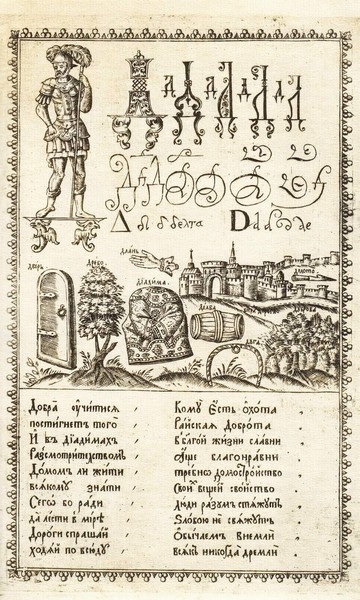
literally длань (and see how д even looks in the beginning of the line as 𓂧 it is, and thus also russian shape of b looks like 𓃀
The shape of b unicode doesn't even seem to know.
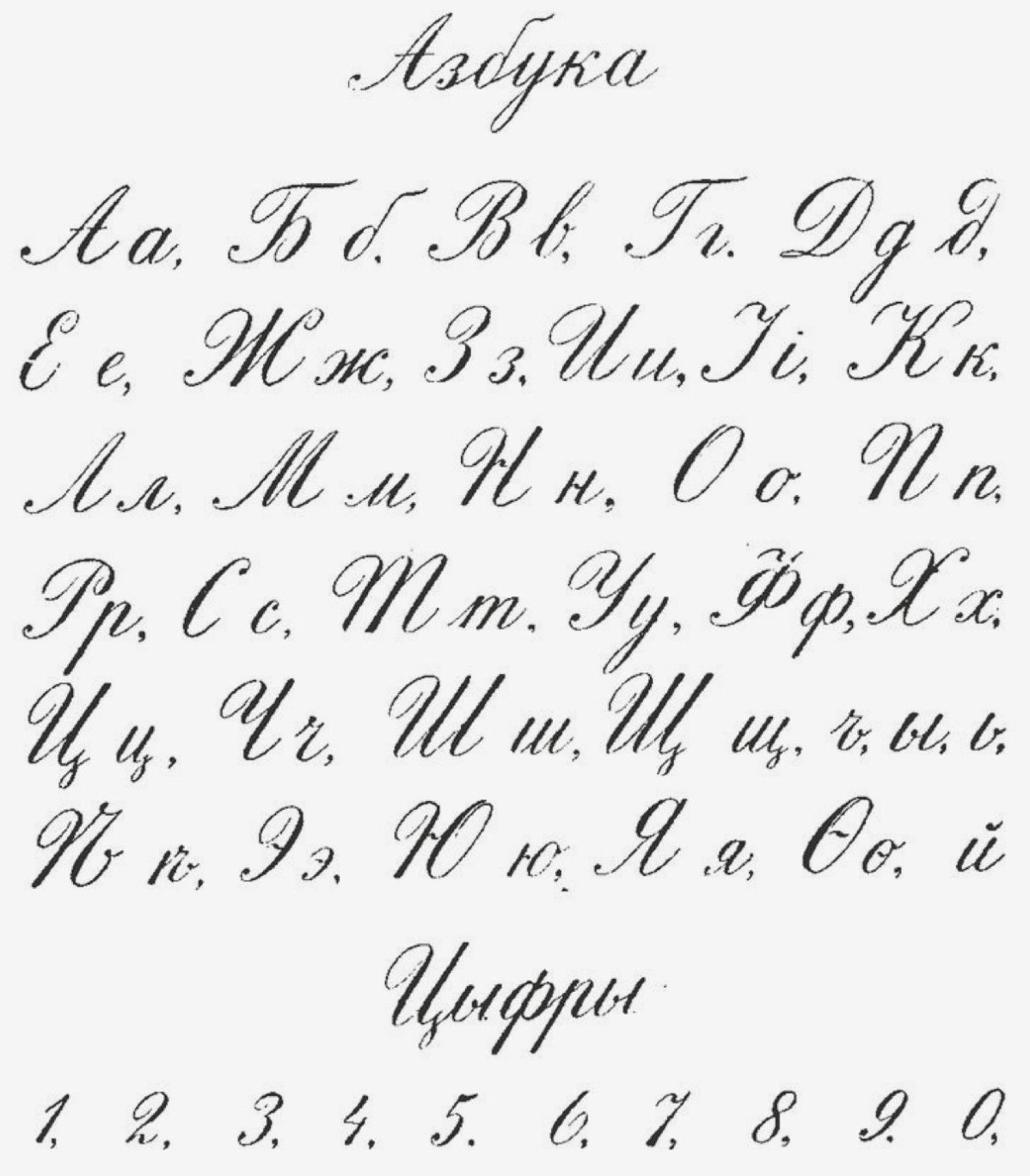
Notice, that as in roman cursive, here b and d look the same way (as 𓂧 and 𓃀 are supposed to do)
Also д goes both ways: 👎 and 👍: g and д and is it why nations usind d for d and g for г make more sense?
That russian handwriting is from 1916, and it's somewhat peculiar: the majuscule П and Т usually look otherwise:
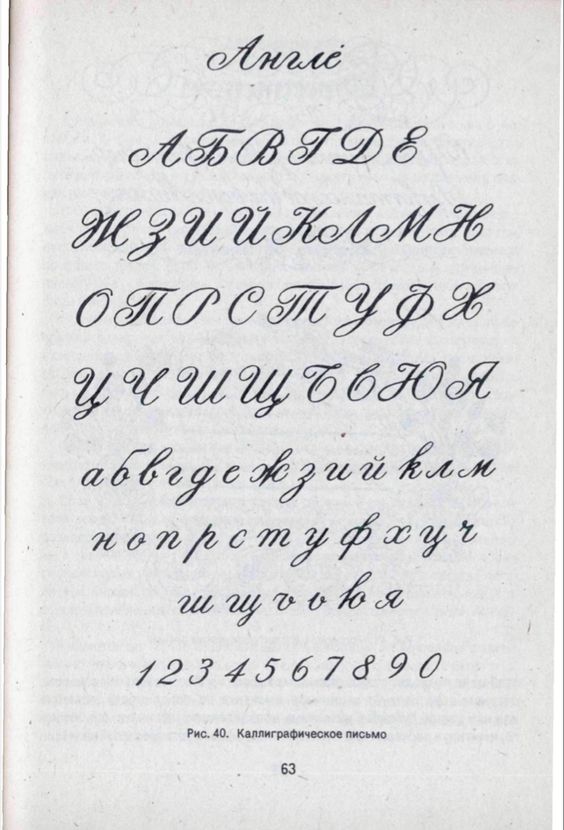
and here Р (the one after П) is over the top, and so are the ъ and ь reminding v, and u does work as ъ in words like guerilla
and the к is written as k, nobody in russia does that, and the same swash on ж and ю, nobody does that, what did they try to tell? Is it some auteur's invention in english style?
And ц reminds у the way צ reminds ע. And they're directly the same letters. Did khazarians influenced russian alphabet? History was rewritten, and russian history especially (because of how outskirt it is, because of how much pohuists russians are (they're so much fucke up but all the shit they have to deal with that they are like whatever))
But then of course I realize, that russian is just one side of that precious crystal every european language is. I just saw egyptian roots in russian, because russian is my first language. I could easily see it in english just in other manifestations, such as be and do (legs to run away (passive, female, yin, maybe even in) and hands to fight (active, male, yan, young maybe)

интересно, что если читать это как длань, то 𓏏 превратится почти что в land, what it actually means in words like 𓈎𓅓𓏏
If M is water and Ж is fire,
then what satanic sorcery is it to call men
мужчины and women женщины?
Man is husband, I announce you man and wife. Man is of Ma and Женеа is of Jah (jah~joe~ju? gene?)
жена джина? жЕ на, but that could be grammatuic flection flexion
inflection is inflexion (s~t ams~amt)
And I knew it from molotok (hammer) being further minusculized to molotochek (к turned ч) is ч нот не the letter of those who invented the alphabet? was n it not existant then? But ч does unite t and c. And isn't thus dʒ unite g and д? is þ both?
Boustrophedon of runes went rolling over, not mirroring, but rotating.
The boustrophedon tradition could only exist when writers were not sure that it will be simple to readers to follow which line is the first, where the text begins, that people don't take each line for a separate message, and thus they rolled around and back and forth. Lines are modern tradition and what if lines were left by rolls on which the text went round and round as a thread. And are those who not forgeries? Слепки с цилиндров естественным образом образуют строки. Так как давно появились печатные книги? Ведь переводить текст штрихуя бумагу на нём мы научились наверное давно. Но не сохранились бы такие списки? Может и сохранились. Я подобным занимался, но разве сохранился хоть один такой экземпляр?
What if greeks did learn alphabet from phonicians, but phoenicians were punic and then they used tifinagh, and had nothing to do with ancient jews (that narrative is influenced by bible, which god supposedly gave wisdom to human race) so though I doubt the truth of it, I suspect something runic in the basis of it. Palehispanic, for example.
But let's entertain the possibility of tifinagh being in the basis of the greek alphabet, as a mindplay,

a as o is understood (vowels are all different, approximations are made by ear, not structure)
Here E is where it is in greek and latin, but it's d. How could it happen? is the grapheme numeral? Is it a coincidence that the other D looks like Λ to look like Δ
further some shapes like Ж are F, and libico F is like G, it is all too much, I need other sources.

and to my surprise indeed they had another
tifinagh:
(and I even visited this page before, but I had no idea)
(and I even visited this page before, but I had no idea)
they say its parent system is egyptian hieroglyphs,
I would like to watch the deomnstration which tells it.
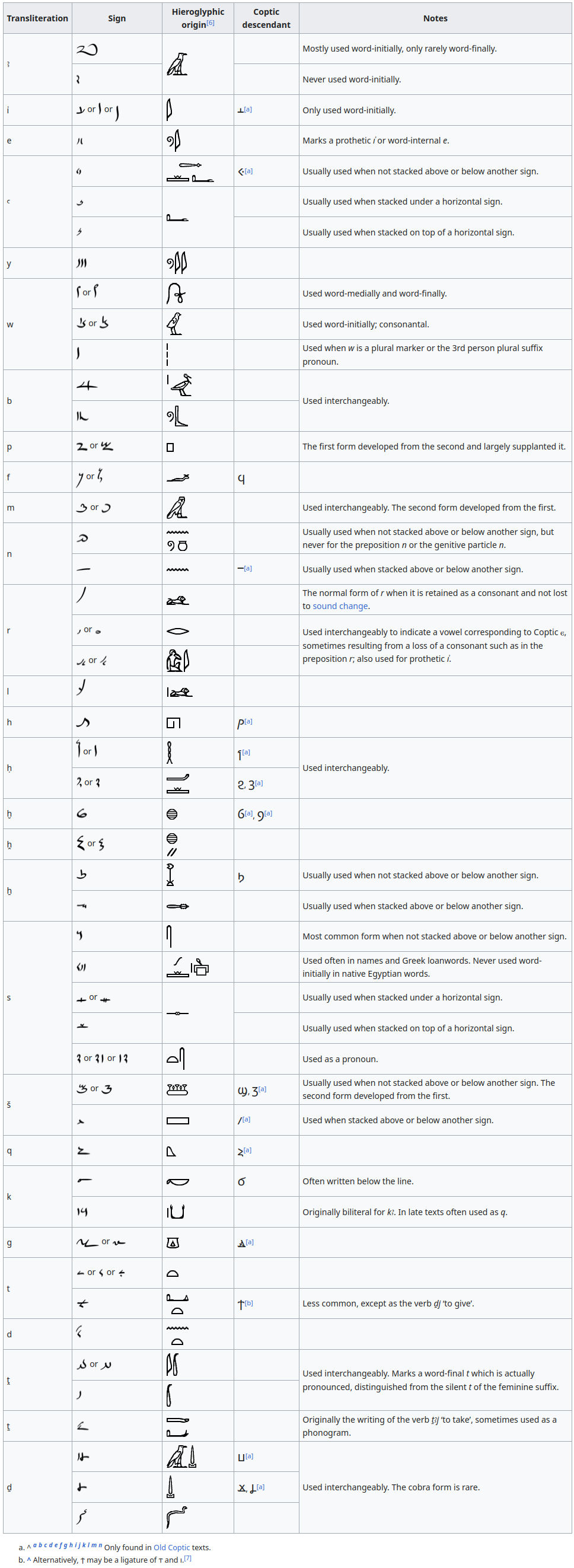
and I can also see very interesting development fo of (of is for?)
and I can see fire in that 𓍑, and in 𓍖 and in 𓍘 too, and probably 𓍙 is a torch
Armenian Ճ reminds that koptic ϫ, and
Ճ (Eastern Armenian, standard) IPA(key): [t͡ʃə]
(Western Armenian, standard) IPA(key): [d͡ʒə]
That dʒ is accurately where 𓆓 is
that ⳗ form is revealing the whole other set of coptic shapes:
Ⲁ ⲁ Ⲃ ⲃ Ⲅ ⲅ Ⲇ ⲇ Ⲉ ⲉ Ⲋ ⲋ Ⲍ ⲍ Ⲏ ⲏ Ⲑ ⲑ Ⲓ ⲓ Ⲕ ⲕ Ⲗ ⲗ Ⲙ ⲙ Ⲛ ⲛ Ⲝ ⲝ Ⲟ ⲟ Ⲡ ⲡ Ⲣ ⲣ Ⲥ ⲥ Ⲧ ⲧ Ⲩ ⲩ Ⲫ ⲫ Ⲭ ⲭ Ⲯ ⲯ Ⲱ ⲱ Ⲳ ⲳ Ⲵ ⲵ Ⲷ ⲷ Ⲹ ⲹ Ⲻ ⲻ Ⲽ ⲽ Ⲿ ⲿ Ⳁ ⳁ Ⳃ ⳃ Ⳅ ⳅ Ⳇ ⳇ Ⳉ ⳉ Ⳋ ⳋ Ⳍ ⳍ Ⳏ ⳏ Ⳑ ⳑ Ⳓ ⳓ Ⳕ ⳕ Ⳗ ⳗ Ⳙ ⳙ Ⳛ ⳛ Ⳝ ⳝ Ⳟ ⳟ Ⳡ ⳡ Ⳣ ⳣ ⳤ ⳥ ⳦ ⳧ ⳨ ⳩ ⳪ Ⳬ ⳬ Ⳮ ⳮ ⳯ ⳰ ⳱ Ⳳ ⳳ ⳹ ⳺ ⳻ ⳼ ⳽ ⳾ ⳿
probably that other line is mostly those old-coptic shapes, the Ⳗ is especaially demotic egyptian. Coptic church giving liturgies in coptic is the rudiment of the cult of ancestors.
Ⲳ Coptic Capital Letter Dialect-P Alef
Ⲵ Coptic Capital Letter Old Coptic Ain
Ⲷ Coptic Capital Letter Cryptogrammic Eie some cryptogrammics, those kopts are full of mysteries
Ⲹ Coptic Capital Letter Dialect-P Kapa
Ⲻ Coptic Capital Letter Dialect-P Ni
Ⲽ Coptic Capital Letter Cryptogrammic Ni
Ⲿ Coptic Capital Letter Old Coptic Oou
Ⳁ Coptic Capital Letter Sampi
Ⳃ Coptic Capital Letter Crossed Shei
Ⳅ Coptic Capital Letter Old Coptic Shei
Ⳇ Coptic Capital Letter Old Coptic Esh
Ⳉ Coptic Capital Letter Akhmimic Khei some akhmimic!
Ⳋ Coptic Capital Letter Dialect-P Hori
Ⳍ Coptic Capital Letter Old Coptic Hori
Ⳏ Coptic Capital Letter Old Coptic Ha
Ⳑ Coptic Capital Letter L-Shaped Ha
Ⳓ Coptic Capital Letter Old Coptic Hei
Ⳕ Coptic Capital Letter Old Coptic Hat
Ⳗ Coptic Capital Letter Old Coptic Gangia Jah nauchil rastamana kuritt gangia, gangia, gangia fstafflaet tak chto vsö, vsö, vsö
Ⳙ Coptic Capital Letter Old Coptic Dja literally Jah! next to gandja
Ⳛ Coptic Capital Letter Old Coptic Shima Shma, isroэl?
Ⳝ Coptic Capital Letter Old Nubian Shima some old-nubian! how many are of those writing systems?
Ⳟ Coptic Capital Letter Old Nubian Ngi
Ⳡ Coptic Capital Letter Old Nubian Nyi
Ⳣ Coptic Capital Letter Old Nubian Wau
ⳤ Coptic Symbol Kai
⳥ Coptic Symbol Mi Ro
⳦ Coptic Symbol Pi Ro
⳧ Coptic Symbol Stauros
⳨ Coptic Symbol Tau Ro
⳩ Coptic Symbol Khi Ro
⳪ Coptic Symbol Shima Sima
Ⳬ Coptic Capital Letter Cryptogrammic Shei
Ⳮ Coptic Capital Letter Cryptogrammic Gangia
⳯ Coptic Combining Ni Above
⳰ Coptic Combining Spiritus Asper
⳱ Coptic Combining Spiritus Lenis
Ⳳ Coptic Capital Letter Bohairic Khei bohairic! some other form of coptic! how many are there?
⳹ Coptic Old Nubian Full Stop
⳺ Coptic Old Nubian Direct Question Mark
⳻ Coptic Old Nubian Indirect Question Mark
⳼ Coptic Old Nubian Verse Divider
⳽ Coptic Fraction One Half
⳾ Coptic Full Stop
⳿ Coptic Morphological Divider
Such verbosity letrosity multitude of shapes make me think that copts always knew how to read egyptian, for secret societies exist for a reason: to preserve information unfit for profanes. Is it? People don't seem to care much about such things. And this is why only some were initiated into the knowledge. Allegedly they have some knowledge. They definitely have some knowledge, some people obviously do, I'm an ape in comparison to some.
chatGPT tells: The Coptic writing system is derived from the Egyptian hieroglyphs. Coptic is the last stage of the Egyptian language and was used in the early Christian church in Egypt. It is written using a combination of the Greek alphabet and several demotic characters, which are derived from hieroglyphs. The hieroglyphs were used for religious texts and inscriptions on monuments, while the Coptic script was used for Christian texts and everyday writing.
I wonder if hieroglyphs and actual coptic were in use at the same time, for that form of coptic would be two millenia old, which is not normal, the language changes into some other language is two millenia.
And then I recall that coptic is a cogante of kemet.
Coptic is usually divided by scholars into six dialects, four of which were spoken in Upper Egypt and two in Lower Egypt; these differ from one another chiefly in their sound systems. The Fayyūmic dialect of Upper Egypt, spoken along the Nile River valley chiefly on the west bank, survived until the 8th century. Asyūṭic, or Sub-Akhmīmic, spoken around Asyūṭ, flourished in the 4th century. In it are preserved a text of the Gospel According to John and of the Acts of the Apostles, as well as a number of Gnostic documents. Akhmīmic was spoken in and around the Upper Egyptian city of Akhmīm. Sahidic (from Arabic, aṣ-Ṣaʿīd [Upper Egypt]) was originally the dialect spoken around Thebes; after the 5th century it was the standard Coptic of all of Upper Egypt. It is one of the best-documented and well-known dialects.
Georgians had not one but three alphabet, rather different alphabet if you look at them side by side:

Well, the next two remind each other, but not so much the one above, but some letters are similar too

ⴀⴁⴂⴃⴄⴅⴆⴇⴈⴉⴊⴋⴌⴍⴎⴏⴐⴑⴒⴓⴔⴕⴖⴗⴘⴙⴚⴛⴜⴝⴞⴟⴠⴡⴢⴣⴤⴥⴧ

ႠႡႢႣႤႥႦႧႨႩႪႫႬႭႮႯႰႱႲႳႴႵႶႷႸႹႺႻႼႽႾႿჀჁჂჃჄჅჇ
ⴀⴁⴂⴃⴄⴅⴆⴇⴈⴉⴊⴋⴌⴍⴎⴏⴐⴑⴒⴓⴔⴕⴖⴗⴘⴙⴚⴛⴜⴝⴞⴟⴠⴡⴢⴣⴤⴥⴧ
it seems these two are so much similar not by accident, but because they're the same writing system:
asomtavruli is majuscule, nuskhuri is minuscule, at least so they seem to be. But then seriously what do I know..
only here order is somewhat different from the one in the table
and this other two also have their jani, similar to Ճ.. so is it ..but nah, it's upside down.
In unicode naskhuri's ⴟ reminds Ⴟ only if you know they're the same. And what is interesting about ⴟ is how it reminds z, being ж, which is indeed close to з
these two
Ⲽ Coptic Capital Letter Cryptogrammic Ni
Ⲿ Coptic Capital Letter Old Coptic Oou
make me think that those are N and O working as 3 and 4, which would be nice if l is one and m is two (like Λ is one and Μ is two, and lmn is 123, paradoxically, but as a guess)
etruscan numerals, 𐌠𐌡𐌢𐌣𐌟, tell quite a story:
𐌠𐌢𐌟 probably were the first numeral sequence, and then 𐌡 and 𐌣 appeared as halves of 𐌢 and 𐌟
and in this context 𐌢 and 𐌟 are very similar to X and Ж and remind me of the second line of the alphabet, the GH, ЖХ, which demands some ⵥ-like shape for E, but then I notice that E is already of four bars. But this is just so зыбко, that nah..
Russians sometimes use да instead of и and I wonder if it is georgian influence or russian influence upon georgian:

Are niggers hard because they're not erected by white women as much as by their mamasitas, and imagine how hard media pushes white beauty upon urban societies. Are suburbs leaving cities to nogs?
Russia is mesmerized by the success of the USA, their name also screams it rUsSiA and USSR was even more further onto that direction. And Russia can be abbreviated to RSA and then it opposes USA in the fundamental way: U stands for united, U is polite form of you in dutch. R stands for рассеянный, раздробленный, разделённый, разобщённый, разобранный. Приставка раз имеет значение разделения (деления ~ делания, just a complex form of simple verbal suffix)
И основное значение в этой приставки несёт не з, а R, звукоподражание треску. Но это R во многих других корнях участвует: резать, решать скорей всего тоже, reason как анализ который означает именно что разделение. Рубить другой корень. И таким образом я прихожу к тому, что современное понятие корня следует оставить, но членить его дальше на морфемы, выделяя в корне руб р(разделять, ломать) и б(бить)
Тогда рез это р(ломать) и з(тереть? з само по себе ощущается как разрезающее движение, и возможно это звукоподражение, но не глухому удару морфемы б, а скользящему контакту выражаемому фрикативом. И, похоже что я нашёл ещё несколько прото-морфем. похоже что я нашёл причину, по которой в и з столь похожи и переходы вида b/d нарушают строгость разделения губные язычные, но что насчёт нарушения и разделения плозивные/фрикативные? что насчёт г читающейся как в? что насчёт θ читающейся и как ф и как т?
Была фита в обоих случаях? чеθо? еθо? это? both его и это местоимения третьего лица единственного числа. это~его~оно?
эта~еɪǝ~онǝ?
remember г looking like ɪ?
 it's even
more than that, it's not just ɪ, it is ī
it's even
more than that, it's not just ɪ, it is īand their П looks like u, which reminds me ᚢ
(but the modern sequence of serbian azbuka doesn't support the axial symmerty, and it)
and then I see that serbians can write г instead of ī:
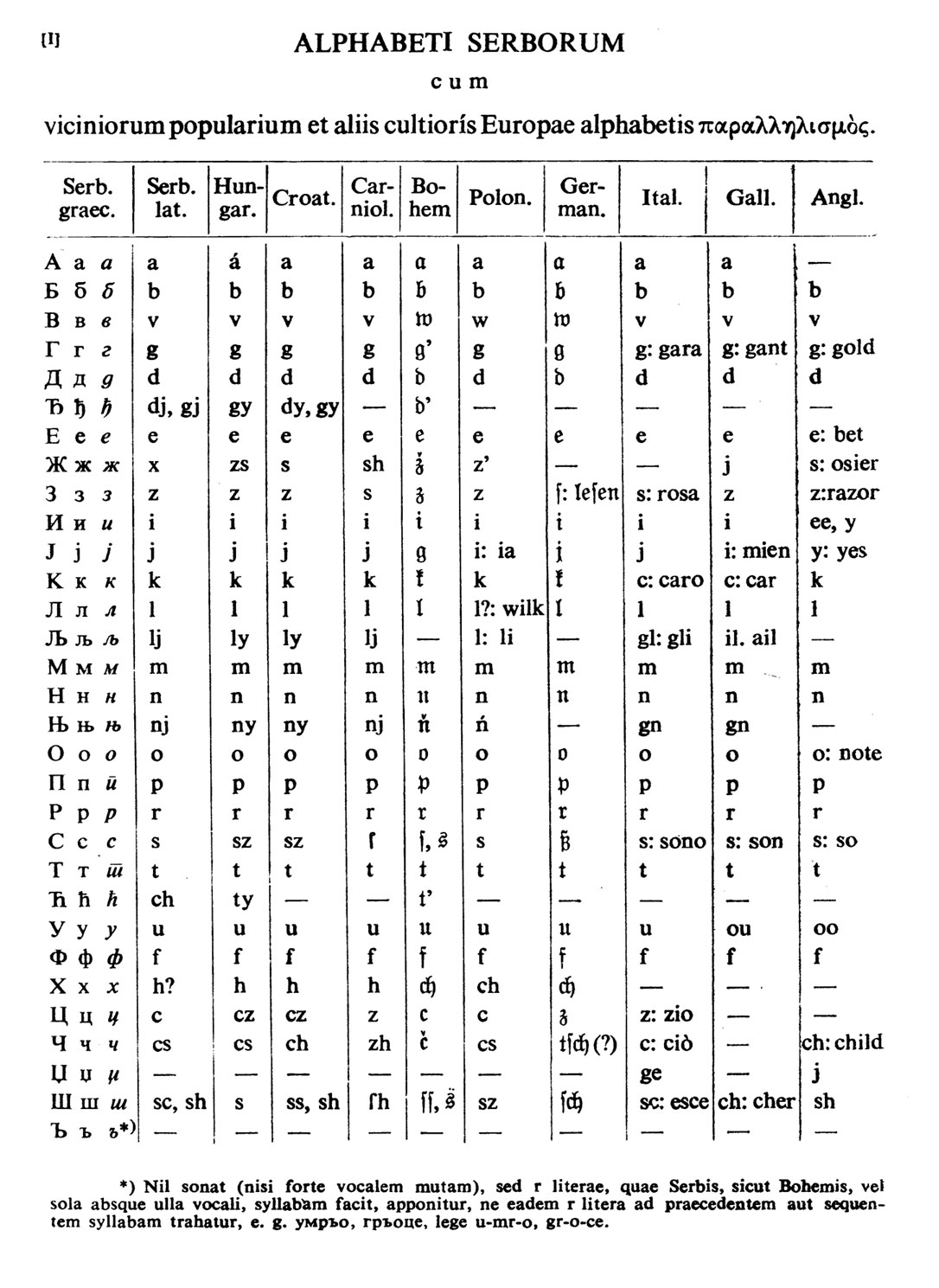
(it's from 1841)
and here's why:Alternate variants of lowercase Cyrillic letters: Б/б, Д/д, Г/г, И/и, П/п, Т/т, Ш/ш.
⬤ Default Russian (Eastern) forms on the left.
⬤ Alternate Bulgarian (Western) upright forms in the middle.
⬤ Alternate Serbian/Macedonian (Southern) italic forms on the right.
So it seems to be common way to write г in Serbia and Macedonia.
I must say, the difference between т and ш is intense (not to say insane) and could hold some key to seeing plosive forms with upper stroke and fricative as the same played in a lower key. I wonder if one could perform ж using г with lower stroke, if ʒ-like z came out of that, as if 7 is I.. could I be 7?
abþ
efθ..
...and it naturally could.
looking at how θ is half f, I can only ask was þ invented as double b? Was it to tell that man is twice as strong as women, that it may took two women to take down one man, even if they succeed, one stands little to no chance.
But let's return to the big one.
B is both foot, boot and beat (and I can see how foot sets feet set the beat)
M is both water and death
G the Ж is fire (гореть и жарить (если ударение на корни, то активная форма?))
R is cRack
Z is saw
and I went B to Z, I suspect W to be next to M, and B to be in water as feet may be when the hands on the outside hunt.
гореть и жарить: если ударение на корни, то активная форма?
пылать и плавить указывают что корень пыл
в в слове плавить означает что не превращать в пламя, но помещать в пламя, плавленное не должно сгореть.
приставка с подобна английскому 's of has of their present perfect. The same function that s serves in russian с- which stands at the same place entglish 's stands, and thus all those punctuation marks only complicate it, itshouldbewrittenlikethis. Itwaswrittenlikethis, ndlkths n is named an, because it is a part of words like one and won and on end own
what words have am? I am, is mi ami? ani! ami is more mimimi, and arabs tryhard to be cool and hard.
варить и парить не похоже чтоб меняли силу, так что нет, скверная идея, но она родила смотри какое прелестное: nd is literally и and да, and the third component of and, а is also a particle translated as and.
Particles! The simplest components of the matter, and here of the letter (and isn't n neither?!)
но я имел в виду союзы! являются союзы истинными частицами, или они, как гласит из их названия, соединяют частицы между собой? Давайте рассмотрим и частицы и союзы:
частицы:
К первообразным относятся простейшие (за несколькими исключениями) односложные частицы, в современном языке не имеющие живых словообразовательных связей и формальных соотношений со словами других классов.
Это частицы: бишь (прост.), бы, вишь (прост.), да (в составе формы повелит. накл.), де (разг.), дескать (разг.), же, ин (прост.), ишь (разг.), -ка, (разг.), не, небось (прост.), нет, неужели, нехай (прост.), ни, ну-с, сём (прост.), таки, те (прост.), -то, уж, чай (прост.).
Все остальные частицы не являются первообразными.
Простыми называются частицы, состоящие из одного слова. К простым частицам относятся все первообразные частицы, а также частицы, в разной степени обнаруживающие живые связи с союзами, местоименными словами, наречиями, глаголами или предлогами. Кроме первообразных частиц, к простым частицам относятся: а, благо, более, больше, буквально, бывает, бывало, было, будто, ведь, во (прост.), вовсе, вон, вот, вроде, всё, всего, где, гляди, да (не в составе формы повелит. накл.), давай(те), даже, дай(те), действительно, единственно, если, ещё, знай, и, или, именно, как, какое, куда, ладно, ли, лучше, никак (прост., вопросит.), ничего, нечего, но, однако, окончательно, оно, поди (прост.), положительно, просто, прямо, пусть, пускай, разве, решительно, ровно, самое, себе, скорее, словно, совершенно, спасибо (в знач. хорошо), так, там, тебе, тоже, только, точно, хоть, чего, чисто (прост.), что, чтоб, чтобы, эк, это.
Как уже сказано, все эти частицы имеют тесные внешние и внутренние связи с другими классами слов: в них в разной степени присутствуют элементы значений
наречий (буквально, благо, во (прост.), вовсе, вон, вот, где, действительно, единственно, ещё, именно, как, куда,
ладно, нечего, ничего, окончательно,
положительно, просто, прямо, решительно, совершенно, совсем,
так, там, хорошо),
местоименных слов (всё, всего, какое, оно,
самое, себе, тебе, чего, это),глаголов (бывает, бывало, было, давай(те), дай(те), смотри(те), знай,
союзов (а, благо, будто, ведь, да, даже, если, же, и, или, ли, но, однако,
пусть, пускай, разве, ровно, словно, тоже,
только, точно, хоть, что, чтоб, чтобы),
компаративов (более, больше, лучше, скорее:
Скорее умрёт, чем согласится; Скорее бы каникулы!),предлогов (вроде: Вроде кто-то зовет?),
междометий (эк, спасибо: Их, какая жара! места не найдешь. Спасибо в погребе соснула маленько. Н. Успенский).
Иногда в одном и том же слове близость и переплетение значений частицы и союза, частицы и наречия, частицы и глагола, частицы и местоимения, частицы и междометия настолько тесны, что противопоставление друг другу таких значений как принадлежащих словам разных классов оказывается неправомерным, и слово должно квалифицироваться как «частица-союз», «частица-наречие», «частица-местоимение» и т. д.;
И, кажется за меня сделали дюжую часть работы. Слова из всех частей речи, которые являются частицами, быть может и есть основа языка. Обрати внимание, что существительных нет.
А есть ещё и составные частицы:
союзы:
сочинительные:
соединительные (и, да (= и), не только … но и, также, тоже, и … и, ни … ни, как … так и, сколько … столько и)
разделительные (или, или … или, либо, либо … либо, то … то, то ли … то ли, не то … не то)
противительные (а, да (= но), но, зато, однако, же, однако же, все же)
градационные (не только… но и, не столько… сколько, не то чтобы… а)
присоединительные (тоже, также, да и, и, притом, причём)
пояснительные (то есть, а именно)
подчинительные:
изъяснительные (что, чтобы, как, …)
обстоятельственные
времени (когда, лишь, едва, …)
места (где, куда, откуда, …)
образа действия, меры, степени (столько, настолько, так, до такой степени, до того, такой, …)
сравнения (как, как будто, словно, будто, точно, как бы)
причины (так как, потому что, …)
условия (если, если бы, коли, ежели, если … то,…)
уступки (несмотря на то, что, хотя, хоть, пускай, …)
цели (чтобы, дабы, с тем чтобы, …)
следствия (так что)
Поскольку русский для меня родной, начну на нём, и если здесь что-то выстроит (не выстрелит, выстроит, выстроит, выстоит)
вспоминая сказку лиса и журавль, подумал кто бы её мог написать? какой-нибудь мудрец, которого озадачили вопросом почему журавль и лиса не дружат (возможно, под лисой и журавлём подразумевались политические персоны, как знать, чего бы ещё такое задавать (загадывать)) и мудрецу ничего не оставалось как придумать сказку, байку, от слова баять, сказки рассказывать, однокоренные слова: убаюкать, убалакать
гадать ~ что дать?
загадывает ~ за что даёт (просит то, за что жертвует)
пытаюсь разложить бери на просты запчасти типа бить/нога и глагольный суффикс ри, который кроме того возможно означает ломай.. отламывай? бе ри be режущим, решающим, будь рвущим)
но это только сейчас осознал, тогда сравнил его с возьми, заметил что ьми = имей, так что значит воз? в себя! и сравнив з (из слова рез) с частью этой приставки, сравнил бери с воз, увидел б~в и
ре~ри~рз (к себе (с~т: к себе ~ к тебе (общение происходит при пилении двуручной пилой (т.е. это слово новее двуручной пилы?))))
here's something funny goes:
.jpg)
they consider it science, imagine explaining
how did 6 became 7
isn't that ⴀ ᚰ?
ᛓ opposes ᚭ as б reflects a, but I'd imagine some q-like a opposing that b, it would correlate with ᛓ being upwards. a and b could be opposites like this: отворотный AH! and приворотный be. Yes, I explain european alphabets with european languages. I'm not sure if armenians are part of european landscape, since they're beyond bosfor, but they're borderline nation, having contacts even with ethiopeans, and their alphabet is similar to greek, so yes, an european nation:
Девушки, не
знакомьтесь с итальянцами, это армяне
ж в режь отттого, что движение похоже на "крапивку"?
they write, that ᚭ is inherited from the Elder Fuþark rune ᚨ.
но отчего я не рассматриваю примеры, где р и ж имеют играют совсем другие роли?
are letters like actors? actor acts, letter lets. Were letters allowing something? Were they for the officers from the cool cats you know, where those cats would tell how important you're for them?
Suddenly I relize the hieroglyphic meaning of K, those are teeth (the dutch word for teeth is kiezen, tooth is kies; and russian word for to bite is кусать (a bite is кусок) and if we look deeper, we also can see russian кушать (to eat) for wiktionary tells on kies: From Middle Dutch kiese (late), borrowed from Old Frisian kēse, from Proto-West Germanic *kūsiju. Displaced older kuis, from Middle Dutch *cuse, from the same Proto-West Germanic source. )
To my surprise I can read francais without a dictionary already. And here I notice how ais in francais reminds yaz in russian yazyk (language)
francaise язьк франков франкоязычные (евреи именно по еврейскому образцу хотели русский обрезать, и ещё обрезали быть может, раз появилось более короткое слово. Может это барочное усложнение словесных структуры отомрёт
Почему ы у слова стоящего в единственном числе, а в будущем о во множественном нет ы?
разве ы не суффикс множественного числа?
Эта история напоминает английский суффикс множественного числа s,
который суффикс множественного числа лишь у
существительных, у глаголов это суффикс единственного.
and of how amorphous phonetics can be:
Lobsters, Martians and Mercy are not there, but you've got the point.
But somehow the most different phrases are BrainStorm and GreenNeedle and these phrases are kennings. But before we go to them I must notice that I stopped hearing the storm part, but I may hear brain-needle and great niddle. My guess is they're all being pronounced and I hear one or the other phrase, because how else would one hear o instead of i, these letters are rather distinct, and even if it's yo, it's literally both i and o, and not only because y is ij
Lobsters, Martians and Mercy are not there, but you've got the point.
But somehow the most different phrases are BrainStorm and GreenNeedle and these phrases are kennings. But before we go to them I must notice that I stopped hearing the storm part, but I may hear brain-needle and great niddle. My guess is they're all being pronounced and I hear one or the other phrase, because how else would one hear o instead of i, these letters are rather distinct, and even if it's yo, it's literally both i and o, and not only because y is ij
aaand.. I was correct:
Scaldic kennings is a great phrase I read the other day. Skaldic! Skaldic kenning (telling that maybe it was skaldich, that c is didfferent from k, с the s it could be. skaldis (even though are there any other?)
If the figure comprises more than three elements, it is said to be rekit "extended".[3] Kennings of up to seven elements are recorded in skaldic verse
stave of the sword ~ man, warrior
the icicle of battle ~ swird
stave of the icicle of battle ~ warrior
the tumult of axes ~ battle
stave of the icicle of tumult of axes ~ man? warrior.
[jalmr geira] clash of spears ~ battle (so it's just a poetic metaphor, kenning is metaphor, why didn't they translate it as such?)
[vargsteypir] fellon-destroyer ~ just ruler
sea-flame ~ gold (isn't it speaking of kin (the fourth element) k-ing gkny? gknx? )
sun’s stronghold ~ Earth
A more complex example where the kenning includes a heiti that needs explaining is:
'{the steed of {the wife of {the Yggr <= Óðinn> of {the river-bone}}}} [ROCK > GIANT > GIANTESS > WOLF]'.
and I decyphered that source somewhat:
steed of giantess ~ wolf
(wife of a giant is naturally a giantess, see, they're simple ..sometimes) wife of Óðinn of stone ~ giantess
Óðinn of stone ~ giant
river-bone ~ rock, stone
волк это конь великанши? под великаншей, видимо, понимается Смерть.
Поэтический язык не способствует правильному пониманию мира. Так
зачем его экскавировать?(wife of a giant is naturally a giantess, see, they're simple ..sometimes) wife of Óðinn of stone ~ giantess
Óðinn of stone ~ giant
river-bone ~ rock, stone
волк это конь великанши? под великаншей, видимо, понимается Смерть.
Дабы понять составителей алфавита? Едва ли они кеннингам пользовались, переносными значениями может быть, потому и смерть и вода делят одну букву. Но разве не Т была смертью? как-то я решил М перенаправить. тм was the sound? was it transpared differently in different parts of the word world. там? это объяснение того, почему т выглядит как m если установив в настройках курсив, потому что в русском курсиве она действительно выглядит как m: т
ма~ть
мама=мать
ть~ма
тётя~мама?!
М и Т обе женские буквы?
world~word
Is bible the satanic book? It itself tells that jewish god is satan, gnostics sorta know that, but lets delve deeper into the subject: the old testament is filled with horror and dubious advice, but what does the new testament shows? A good man and his ultimate fall: he was executed, his friends didn't save him, his heavenly father didn't save him as well, and the scene of resurrection is who's gonna believe it, the hope as the final gift of pandora, and the name of the book in russian is bibliya, as if be бля (and the first book of the old testament is called параша (I kid you not) and what else would you expect from the most popular religion in the world reigned by satan until the second coming, according to that very book? If Jesus is victorious, then why is world awaiting the secong coming? Wasn't his resurrection that second coming? That contradiction ultimately tells that resurrection was a fantasy or a halucination. And quran is even worse, and hindu texts are no better, krishna is literally black god, and in the bad sense as well, rigveda teaches to fight wars even against members of their own family, justifying it by the lies of the afterworld. And because ancient gods were violent and vicious, it's only natural that elite are still satanists and it correlates with the prominent position of jews who openly practice judaism
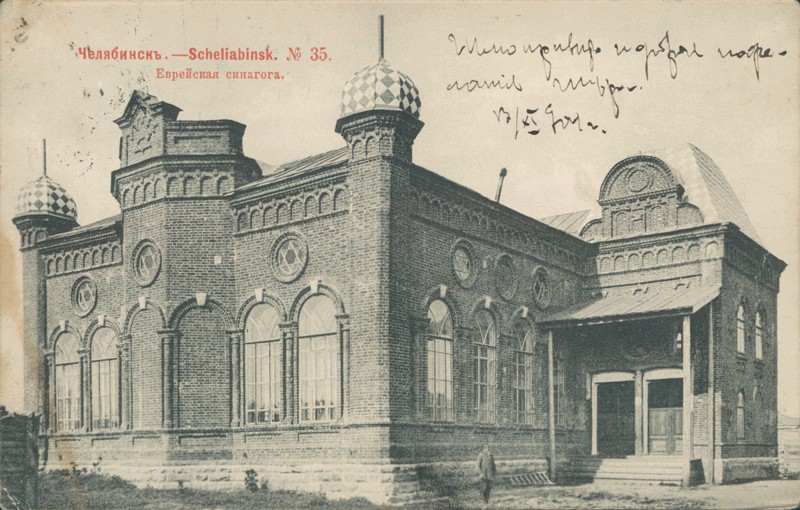
not only does it have that 666's in the windows, it's postal adress is 6 on pushking's street
(they're not much better than other guys, these ones are just more honest about what they're praying)
pay attention to the 904
written in cursive. Is it what
Fomenko told? Is it the actual year they counted then? But old
books have that 1 in front of those years, so is it another
tradition or the way we'd shorten it today up to 04? Yeah,
probably this, fomenko is a freak after all (and am I not? a
freak, a funky freak)
Bible having bl in its body tells quite a story: b.ble, book of baal, б.блия (russian kids learn библия и бля примерно в одно и то же время в процессе постижения языка, and one looks like a stuttering form of the other) бытие баала, и учитывая что баал переводится как господин, господь, потому библия переводится как бытие господа (нашего иисуса христа, прикинь, это секта (а ты сучка))
Meditating to this image I saw how oпcт was ufʃſ so B is russian V, the preposition в~ב tells to combine first and second lines, г ~ ж? G is both, and that G is C. so far it goes ABC and greek

☯ in my screen it is ࿊-like in the shape of N with black part below as it should.
And I did this:
ABCD A~E B~V G~Ж D~Z
IMNL I~Y M~W ŊNӉҢԨӇҤԢԊЊ L~R
OPHT O~U P~F K~H T~S~Š (so as new combinations appeared, alphabets tent to
explode, up to 28 in arabic and 33 in russian
ABCD as April Bay Cune Duly, I allow me alot, but Dʒ as a protosound combining C and D is great!
but this is nothing but a fluke, august september don't align, but then september is o fdidferent nature than
nation~nature~natal~innate~nature as night? nat.
Natural next step would be to combine those C and D into ᚼ
ABC
IML
OFþ
but graphically Г and L evoce V to be the third counterpart, and þ probably was taken for b and
Dʒ ~ dj (ономатопоэйя скрэтча на виниле, the worst of their tricks, btw)
Glagolitic is of glagolythos, speaking stone (not official point of view, but morphologically it is so)
is there any other writing system with lythic in its name?
analitic has the same litic.. not exactly, it's analytic, even closer to lythic than litic
but litic is not lithic l'lithic (c камней? лилит как маман няняк, вот уж наняк так наняк, что несу..)
and yes, glagolitic is unique in this account
I sent this offer to don Carlos:
https://en.wikipedia.org/wiki/List_of_writing_systems
places mayan and chinese into the same group, and not for the reasons which made me want to look deeper into this geographically approximate synchronicity.
I know some chinese-japanese, maybe if you point out some foremost semantic elements of mayan writing, I can check 中~日 characters for graphic cognates.
(and I don't consider sharing books they still sell an unethical behaviour, also because downloads raise possibility of later buying the book if it's good, as a gift and such, so it is free promotion, especially in the world of science, where quotations matter or meter)
Demotic once again:

Look how س and ʒ existed even in the times of ancient egypt. Recognizing symbols as separate entities outside of the context of alphabets, it liberated me so much, that I see ל in 𓆓 (sLand, Lingam as a form of that protoletter ʒ, and I see З in that 𓆓 as well, and snake is змея in russian, змея в отличие от червяка смеет, смелая, может наброситься? смея (смеясь в душе конечно)) and naturally I can see S in that demotic 𓆓 as it is in the picture above. and yes, that S looks more like ξ, which tells that mln or mnl or lmn are M (it's whether
Moulin tells MLN, I wrote mln by accident, and such accidents I like.
工場 [kōjō] (mill, factory, plant) notice how 工 is the millstones, naturally factories turned stones into standardgravel and 場 is simply place, and in 場所 [basho] it's ba (both hieroglyphs are "place") and them being synonymous tells me that jō in kōjō is sho in basho (though doesn't length matter? I met it jumping in some words, or was it chinese word changing its tone depending on context, so those tones are not something from the past, but probably a result of some reform, separating chinese even further from the others. And neighbouring countries recognizing tones are probably descendants of the same empire of the past. I think this bold claim demands some bold examples for a proof, but then what do I know.. I know only what I managed to recognize so far, and it is quite an ammount, to be fair.
and that demotic thing has plenty of variety:
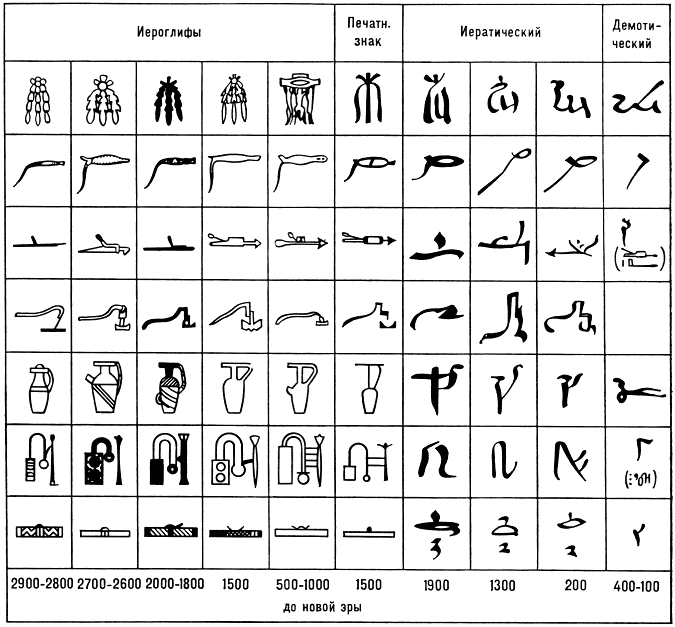
and some texts in both shapes:


And looking for that I found this:

pay attention to "palegraphic minuscule" is it ancient greek cursive? There's no way they didn't have something swashed for handwritings. Well, it would be bizarre.
b as u is just insane (but I think Δ looks like Λ by a mistake of the copyist. So take it with, you know..
Speaking of symbols having roots much deeper than the abecedaries:
demotisches L für Jahr kombiniert mit griechischem ϛ für 6 auf Münze aus Alexandria
So they say,
L für Jahr is rusian л. for лет.
abfahrt [апфа́т] is the best example of german not being read as it's written, as many russians believe
ab-t the abfahrt looks so alphabetic, and it stands for departure, as if ab-fh-rt is where we only start our journey. This is our abc, and I only
If abfahrt is intentionally alphabetic, it must hold some keys?
ab
fh
rt
isn't h between f and r? it's both k and п, and isn't b between a and f?
ab fa hrt could be ab fa art of abc
but didn't I take a random word? A random, but formally an
The fact that pupils are taught Newtone and don't teach Hook (hardly ever teach, law of hook they may heard of, but who Hook was, they have no idea. So this fact prooves that masons are in charge of our education systems. All over the world.
And must I contact masons to ask them to change the world? They used to be a revolutionary force, now they probably protect their revolution, but principles, were they not good? Their mythology is some random rubbish. The stages could be caused by revelations of more and more veils, until in the end there's some ultimate principle, of that there's one god? of that there is no god? Of gnostic teaching? They're not known as the circle of witches, more like a circle of weird folk. Weird folk with some wicked connections. He knows him from a club. Are those gay clubs? Why else would you keep your practice in secret, if you're not a witch? I think the exposure of gay community, which is happenning in the modern time, could be provoked by my exposure of church and academia as gay communities, and not in the good sense. Actual gay-mafia. And there are probably all sort of mafias, but this one is wtf. I'm going to be dead.
How dare I say that Ж is of fire, when жижа is liquid (and пламя has two and a half labials)
Could Ж be 水? Журчит ручей делят рч, речь? река! river ревёт? почему здесь v, а там к? наоборот
Could water and fire be in the same category with air? passable, empty spaces, as the opposite of unpenetrable solid objects, like even soil. maybe sand and soil were s как cыпать, п в сыпать означает падение, глухой стук. с же подражает сыпящейся сыпучей сыпстанции
if they needed to ~ if they need it to (is -ed ~ it?)
A M Sʃ (according to jewish myth)
ABEIOTU (according to greek myth)
(and I wanted to place the names of aettir, but second aett starts at different positions, but then I looked it up, and the following texts were found (the font of other size is mostly quotation in this work))
quote ~ чьё-то
In his English translation of the work, Stephen
Flowers insists that the final "h" is not a misspelling, but
indicates the seventh rune, Hagal; the historical Younger
Futhark likewise have "h" in seventh position, while the first
aett of the Elder Futhark was fuþarkgw, so that the historical
name fuþark spells the initial sequence common to both the Elder
and the Younger variant.(it is from the article on armanen runes, wiki page on runes didn't have aet, only raetic)
Aet is an Estonian feminine given name, a cognate of Agatha and often a diminutive of the Estonian form, Agaate.
Agatha is very alphabetic in the
α-Ethyltryptamine, a psychoactive drug belonging to the tryptamine family
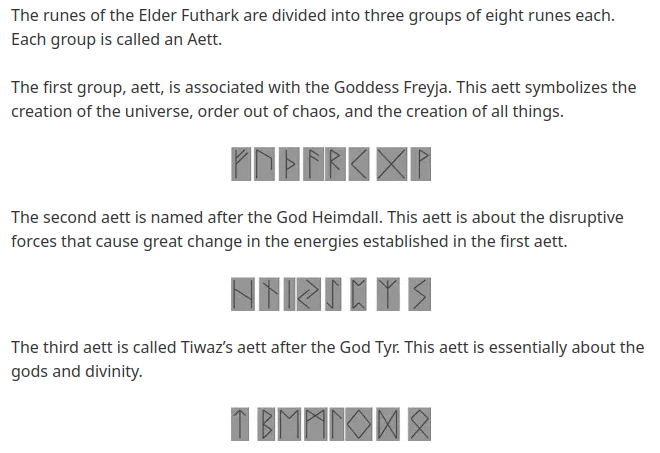
T being the name of the Third aett does remind me alphabetic stuff, and F being the beginning and labial tells me that FHT ~ BCD and thus vowels are whether not vowels or were added later. Or is H vowel? Then why they're not collected in the same group? I worked on that question before, I think I found first set further deviated from being labial in ᛒ aett, being lingual or vowel in the second one and vowel or lingual in the third, and here I can see which is which, but it is such a натягивание.
I looked up aettir and they all seem to agree on ᚠᛏ being the beginnings of the aettir,
even in such
form:
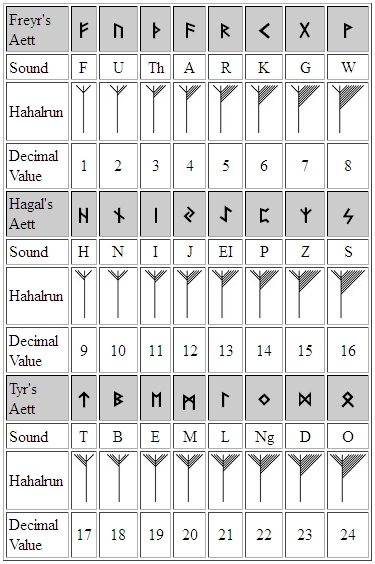

even in younger futhark:


but then sometimes those FHT turned FKS, thus muved moved one position to the left:
But then it is the way Bureus himself gave it:
But then h and not k reminds ogham's aicme, which reminds bht by 2/3 instead of 1/3 as in the case of fks: it goes B H and then it deviates into M:


but then sometimes those FHT turned FKS, thus muved moved one position to the left:
But then it is the way Bureus himself gave it:
But then h and not k reminds ogham's aicme, which reminds bht by 2/3 instead of 1/3 as in the case of fks: it goes B H and then it deviates into M:

But then am I insange? first aet is not B, it's F. Yes, b and f both labial, but seriously, wtf!
То что у "живой" есть значение "подвижный" напоминаетс мне о сходстве между live and leave.
Thinking of what if we added Ў to russian alphabet, where would we place it?
УЎФХЦЧ..
UVWXYZ (well, Z and why are the other way around, UVWXZY, but then russians added Ш and Щ to it, so maybe that was the reason? Y~Ч was placed inside of previously existing lines of UVXZ and УФХЦ (germans read V as Ф, and if slavics are europeans, next europeans they are next to are germans now (pomerania is a slavic toponym (you can only tell this, and not that it's your clay, or most of russia is to be givent to other nations)
Ф~W? W is double V, and here I see that Ф is double P and I recall that graphic systemic whatever:
S as CC, T as ГГ (and indeed k is sharper than h and t and l so thus Z is TT, S~TT. T~C? but Г~C!
T~ГГ, thus T~S, as sefer yetzirah tells, when it names places not T but S in the final position.
v = uu?
B[v] = bb the ББ
and it may tell that russian sequence БВ[bv] is 1 2 and
𐰗(𐰖) [j]
𐰝(𐰜) [k]
in old-turkic DB shapes remind the beginning of the second half of the alphabet so to say (if AEIO were all the vowels. when was it? when t was the final letter. Does greek myth telling of 5 vowels describe V (the lower point of the pentagram? Did it really happen, the turning X-like cross or a square into a star?)
in old-south arabic they remind D and B, being
𐩣 [m]
and.. I could only see 𐩾 []
𐩨 reminding П and sounding alike, the table below shows 𐩶 that more П-like too, but don't let it

I don't think that oder they placed the letters there is any way alphbaeti, but then they also do not arrange it in alphabetic pattern. What is the sequence they're using? Because I can see it'sn't halaham the 𐩠 𐩡 𐩢 𐩣 𐩤 𐩥 𐩦 𐩧 𐩨 𐩩 𐩪 𐩫 𐩬 𐩭 𐩮 𐩯 𐩰 𐩱 𐩲 𐩳 𐩴 𐩵 𐩶 𐩷 𐩸 𐩹 𐩺 𐩻 𐩼 𐩽 𐩾 𐩿 either.
I wanted to contact the guy who brought it to wiki calling it his own work, but I didn't din find his contact requisites.
Either way, what a sloppy work, somali is latin now? Do they use latin? Do they really use C instead of ayn? I sorta doubt it. J for T? that I doubt a little less, but still, wut
Notice how t is x-like, the archaic form of t it is told to be.
Suddenly I found the image of the artefact I mentioned earler, the one with T instead of I
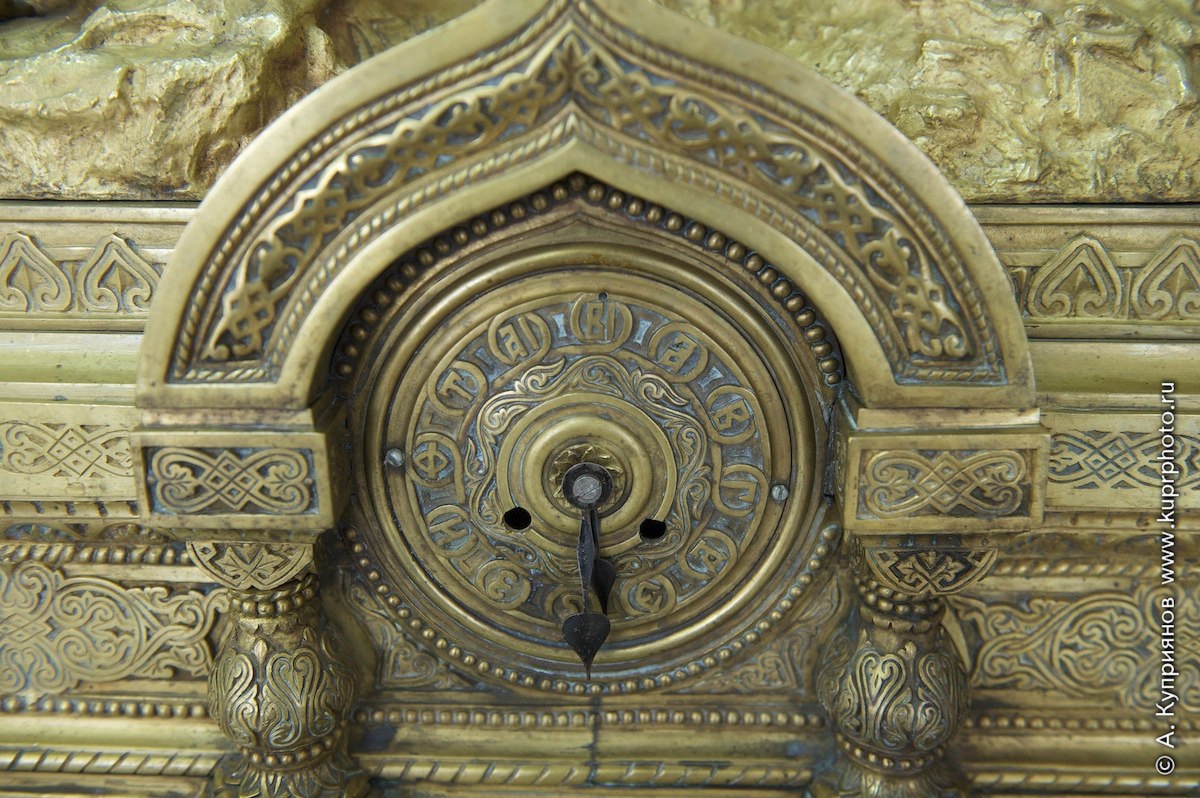
It's probably noting, but what do I know, I thought about it for some reason, let it at least be included into this thing.
中国から漢字が伝来する以前に、古来から日本に存在していたとされる神代文字についてふと思ったことがあり ます。
ブリタニカ国際百科事典によると、『神代文字とは「鎌倉時代中期以来しばしば,日本に漢字が渡来する以前から存在したと主張されてきた文 字。神字 (かんな) ともいう。特に江戸時代中期から国学者のなかにその存在を強く主張する者が多く現れた。対馬に伝わる日文 (ひふみ) を支持した,平田篤胤 (あつたね) の『神字日文伝』などが有名である。しかし,現在では,その存在は否定されていて,その多くは朝鮮のハングルをもとにして 15世紀以後つくられたものとされている。』とあります。
諸説あり、紀元前660年以前から存在したという2500年以上前から非存在説まで色々あるようですが、何れにしてもこのように呼ばれる 文字が相当前から存在していたことだけは確かといえそうです。
I suddenly thought about the ancient script, which is said to have existed in Japan since ancient times, before kanji was introduced from China.
According to the Britannica International Encyclopedia, ``Jindai characters are characters that have often been claimed to have existed since the mid-Kamakura period, even before the introduction of kanji to Japan. Many scholars strongly advocated its existence.A famous example is Atsutane Hirata's ``Shinji Nichibunden'', which supported the Hifumi written in Tsushima. Its existence has been denied, and most of them are said to have been created after the 15th century based on Korean Hangul.''
There are various theories, ranging from claims that it existed for over 2,500 years before 660 BC to non-existence, but in any case, it seems certain that characters called this way have existed for quite some time. is.
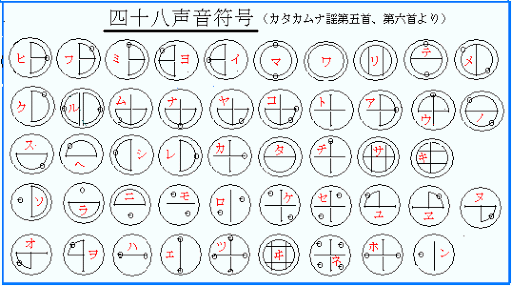
note the chaotic order, note the way to and wa oppose eachother the way t and o would, I'm telling you these systems are connected, writing doesn't appear in vacuum.
カタカムナ文字を見て、私はハッとさせられました。絵文字がすぐに思い浮かんだのです。円と線だけで構成さ れる図象化させた文字なのですが、これって近年日本発で世界に一気に浸透した絵文字とそっくりではないですか?マルを基本にその中に様々 なメッセージ性を盛り込む。このコンセプトが全く同じの表現方法が何千、何百年という大きな時代の隔りを経て、再び日本から絵文字として 出現したことに、ずっと底辺に流れ続けている日本人の意思伝達の方法に関する瞬時性を見る思いがします。
カタカムな文字といい、国旗の日の丸といい、寺院の丸窓といい、三種の神器の鏡、および神社の鏡といい、テストの採点に丸をつけることい い、そして絵文字といい、日本は丸○を使うことが好きとうい以前に、そこにはもっと大きな所以、意味がきっとあるのだと思うのです。
日本と丸○にはやっぱり奥深い哲理が潜んでいる、と私は一人確信しているのです
When I saw the Katakamuna characters, I was taken aback. Emojis immediately came to mind. It's a pictorial character made up of only circles and lines, but isn't it similar to the pictographs that originated in Japan and quickly spread around the world in recent years? Based on the circle, we incorporate various messages into it. The fact that this same concept has re-emerged as pictograms from Japan after a huge time gap of thousands or hundreds of years has given rise to the instantaneousness of the Japanese way of communicating that has continued to flow at the bottom. I feel like watching it.
Katakam characters, the Japanese flag on the national flag, round windows in temples, mirrors as the three sacred treasures, mirrors in shrines, marking marks on tests with circles, and emojis, the Japanese word for round. I think that even though I don't like using ○, there must be a greater reason or meaning behind it.
I am the only one who is convinced that there is a deep philosophy behind Japan and Maru○.
And whoever said it, they're correct, 和[わ(wa)] is the old name for Japan, which links it to the 🇯🇵.
And it's more than just old: Wa is the oldest recorded name of Japan.
and another wa, with no chinese character, just わ is me, I, which strongly resonates with personal pronouns originally being names of the nations.
Those characters are names katakamuna (and yes, this word reminds katakana very much)
But then who knows, it could be a fabrication:
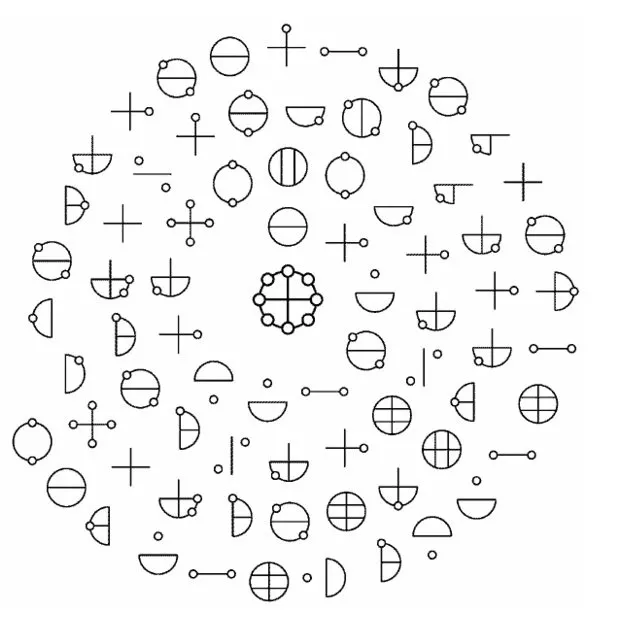
Katakamuna Script, from the
book『日本の上古代文化』by Narasaki Kogetsu. The author claimed that,
while he was spending time alone in the forest, a hunter
brought him a scroll covered in a strange script that looked
like electrical circuits. By pure coincidence, the author
happened to be an electrical engineer.
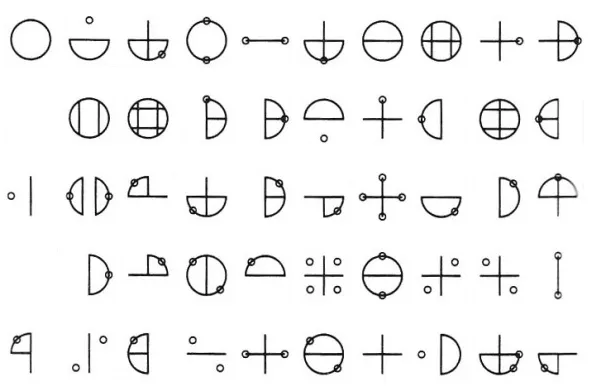
But there's more:
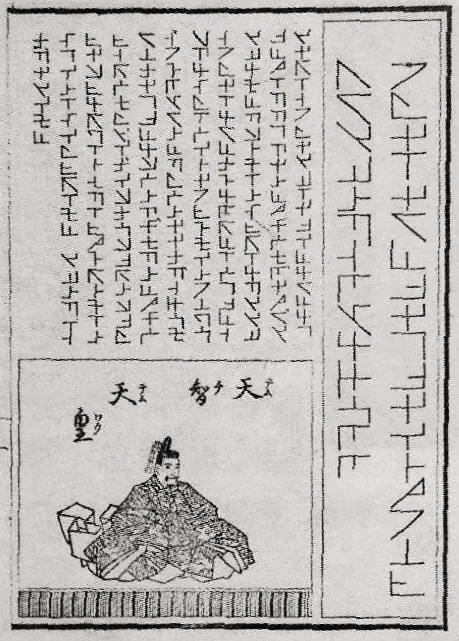 A page of Jindai Moji from the 1837
text『神代字三十六人首』
A page of Jindai Moji from the 1837
text『神代字三十六人首』 Most historians agree that Japanese writing began with the introduction of kanji from China. The offshoots hiragana and katakana appeared over time, and the modern Japanese character set was complete. But lurking on the outskirts of this history are a strange and little-known assortment of exiled characters. In Japanese, they are called jindai moji or kamiyo moji 神代文字: ‘characters of the spirit age.’
These scripts are veiled in mystery. It’s claimed they predate the introduction of kanji by several centuries. This would make them not only the first, but also the ‘most’ Japanese characters. Yet these letterforms have been dogged by controversy for centuries.
There are around a dozen different scripts that together are called kamiyo moji. Some are full character sets; others are only proto-scripts that can’t be formed into sentences. Each has a distinct and striking style. Katakamuna looks like a series of electrical diagrams. Anaichi feels like a science fiction script. Abiru is notably similar to Korean hangul.
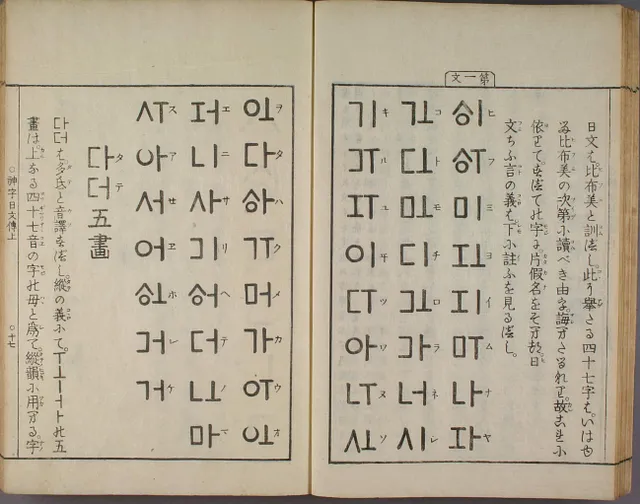
Abiru (above) and Anaichi (below) characters in the 1848 text ’Kaei Santei Jindai Moji Kō’『嘉永刪定神代文字考』
by Tsurumine Shigenobu 鶴峯戊申 (National Diet Library Digital Collections)


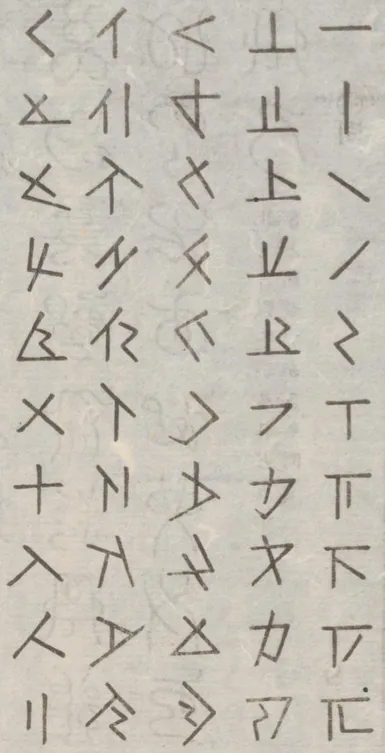



Various kamiyo moji from the 1819 text『神字日文傳』by Hirata Atsutane 平田, 篤胤 (National Diet Library Digital Collections).
I think I found the one to the bottom left, and I found it in the context of some writing system of a particular dojo. Which may tell that japanese writing tradition can be as diverse as that of Philippines, to which it's very related. Wosite the name of that system. Here it is:
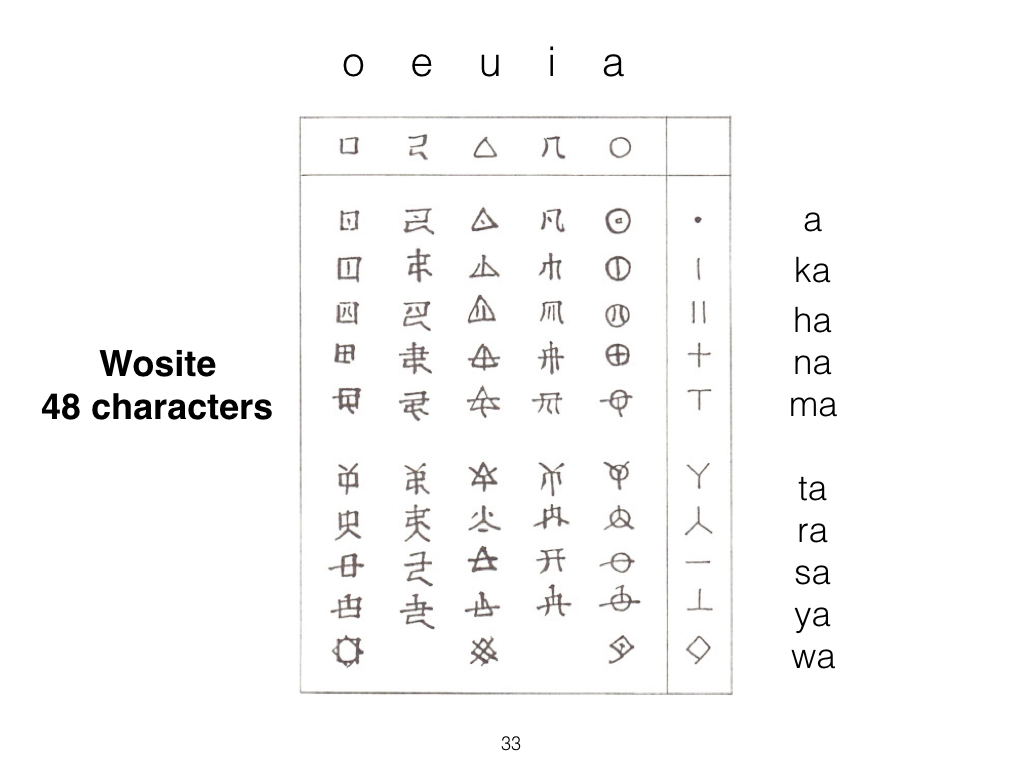
The order is somewhat different, and yet somewhat the same, similar order. They kept the order of vowels, but divided the syllables in two groups, and it is interesting how sa and ka are similar yet different, as if the two ways to read C.
But then the orders of those other syllabaries.. They may hold key to the chance of authenticity of the writings systems. Naturally they appeared in connection with the others, so they should be not arbitrary. And if they're some creative endeavour, it can be noticed by the future unhuman brains.
And I found a wiki page about anaichi:
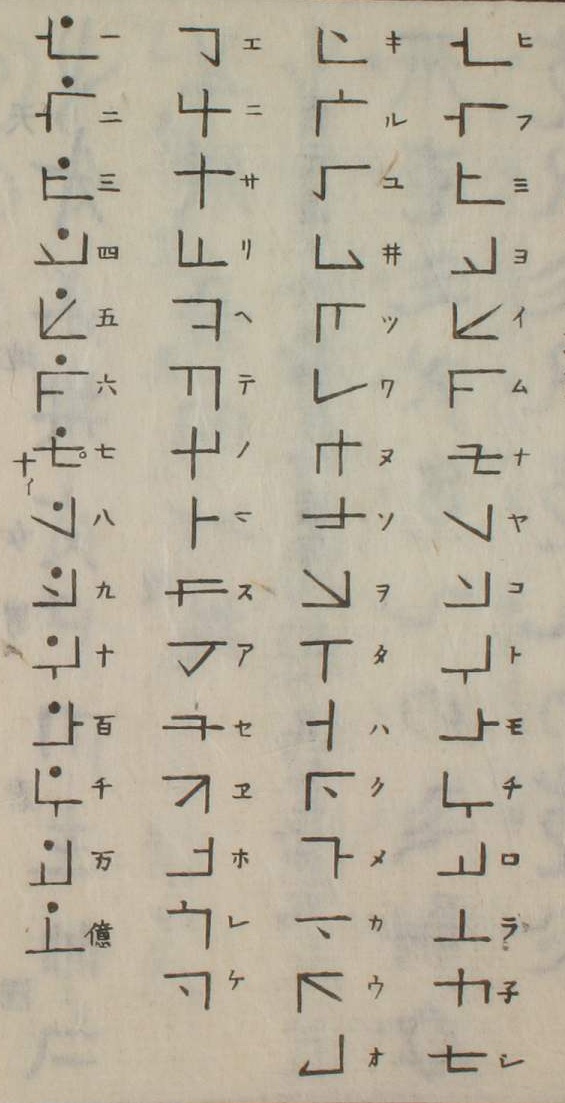 天名地鎮(あないち)は、神代文字の一種。「天妙地鋭」や「阿奈以知」とも表記される。磨迩字(まにな)、六行成字
(むさしもじ)、ウマシアシカビ字とも呼ばれる。今日では「神代」に実在した文字ではないとされている。
天名地鎮(あないち)は、神代文字の一種。「天妙地鋭」や「阿奈以知」とも表記される。磨迩字(まにな)、六行成字
(むさしもじ)、ウマシアシカビ字とも呼ばれる。今日では「神代」に実在した文字ではないとされている。日本語の五十音を表す47種の文字からなり、直線と点によって構成された子音と母音に相当する字母の組み合わせによって、一つの文字が形 成されている。ほかに一から十までの数を表す文字、百・千・万・億の位を表す文字もある。
アナイチという名称は「穴一」と呼ばれる遊戯に用いる印と形状が似ていることに由来する。またマニナという名称は「マニ」と呼ばれる太占 の卜兆に由来し、ムサシモジという名称は「六行成」と呼ばれる碁遊びに由来する。
対馬市の雷(いかつち)神社で行われる亀卜神事では、卦を読む際にアナイチや対馬文字が用いられる。
薩摩藩によって1804年(文化元年)に編纂された『成形図説』や、平田 篤胤が1819年(文政2年)に著した『神字日文伝』に、アナイチの字形一覧が掲載されており、河内国の「平岡泡輪」神社が所蔵する 土器に記されているとあるが、その具体的な内容には触れていない。
鶴峯戊申はアナイチについて、漢字・梵字・ハングル・ラテン文字など世界中のあらゆる文字の起源であると主張し、『釈日本紀秘訓』で はアナイチと片仮名の混ぜ書きが用いられているとする説を唱えた。
国学者落合直澄が1888年(明治21年)に著した『日本古代文字考』では、アナイチが記されているとされる土器の図が掲載されてい る。
竹内文書には「ウマシアシカビ字」として登場する。
Anaichi is a type of script written in the ancient times of the gods. It is also written as ``Tenmyojiei'' or ``Anaichi.'' It is also called mana, musashimoji, and umashiashikabi. Today, it is believed that these characters did not exist in the ``Age of the Gods.''
It consists of 47 characters representing the Japanese 50 syllables, and one character is formed by a combination of consonants made up of straight lines and dots and letters corresponding to vowels. There are also characters that represent the numbers from one to ten, and characters that represent the hundreds, thousands, ten thousand, and billions.
The name anaichi comes from the fact that its shape is similar to the mark used in a game called ``anaichi.'' The name Manina comes from the Taishu Bokucho called ``Mani,'' and the name Musashimoji comes from a Go game called ``Rokugyo Sei.''
At the Kameboku Shinto ritual held at Ikatsuchi Shrine in Tsushima City, Anaichi and Tsushima characters are used to read the hexagrams.
A list of the glyphs for Anaichi is included in ``Kozo Zukan'' compiled by the Satsuma domain in 1804 (1st year of Bunka) and ``Shinji Nichibunden'' written by Atsutane Hirata in 1819 (2nd year of Bunsei). , it is said that it is written on a pottery owned by the Hiraoka Awana Shrine in Kawachi Province, but the specific content is not mentioned. Tsurumi Boshin claims that Anaiichi is the origin of all the written characters in the world, including Kanji, Sanskrit, Hangul, and Latin, and that in the "Shaku Nihon Ki Hikun" a mixed writing of Anaiichi and katakana is used. He proposed a theory that In ``Japanese Ancient Characters'' written in 1888 (Meiji 21) by Japanese scholar Naozumi Ochiai, there is a diagram of a pottery on which Anaichi is said to be written. It appears in the Takeuchi Documents as ``Umasashiashikabiji.''
ヒ[hi] and not just イ[i] is attributed to 一 and it links ichi to hichi? to hito! t as д in oдин? because one or uno is enough in the other, similar to russian, languages
I would have reverse comma to use commas as brackets.
they say, ⹁ is such reverse comma. ﹑ is even better ﹑it also has empty space up front. So I recognize front of the glyph as egyptians did. ﹑ and 、
フ[fu] is chosen for two (fu~tu) and that depicts it as the japanese name for the digit.
Notice how ヒ reminds 1, and even more than that japanese 7 the 七, only that is looks much more like セ, and this is not hi, but se, and what is interesting is that seven is transfered to japanese as セブン, which is starting with セ
So japanese also have similar shapes for 1 and 7? 7 is literally with that dash.
And if you use g dictionary, sebun is the only japanese seven they give you. But if you trick them and ask to translate from english, they give you 七 and that is read nana, but because you used the same glyph you have no idea that is the seven in japanese as well, so use jisho for japanese.
and look at the katakana's na: ナ one and seven end with n, from nine to eleven they all end in n, so what. So n is rather popular ending for Numerals. in english. and that is nothing. How do I know? I feel it not interesting. No reason for it to be some system, why would they giv them the last letter, so I should maybe remember this case for a case of coincidence:
ヒ(1 in anaichi) ~ 七(7 in kanji)
七 starts with n in japanese
1 and 7 end with n in english,
see, a coincidence
And how much of this book are like this? Hopefully not many, I indicated this one, after all, it didn't feel right, and I have passsed that far astray in the past, but not often, hardly more than 10% of the time.
フ looking like 7 didn't confuse me. But it caught my attention that フ looks like 2 without lower bar. And what 2 is without the lawer bar? The lower bar is literally the two after one. 3 sometimes doesn't have the lower bar, depicting thus the third bar by the contact, so does フ, but I never saw 2 written like that. 7~1, 2~1+-
Many am I trippin' (if I ever use this typo in print, I should make the lower part of y black, as if it is a ,)
In that anaichi image, the very previous image, the right and the left columns are almost identical, and thus we got our order's origin: they are aranged according to the numerals. And since the first three showed affinity of the numerals and the syllables
But they use セ for 七, as it is really sebun. What is it? That was supposed to be nationalistic fabrication, why would they put english, or even if latin influence into it? Japanese readings of 七 are なな[nana], なの[nano], なぬ[nanu], な[na] and しち[shichi], ひち[hichi] and they also have チー [chi:] for 7, and I wonder if it's not for the graphical similarity of チ to 7, but maybe not: 七対子 [チートイツ(chi:toitsu, but g reads 七対子 as chi:toi)] seven pairs; winning hand composed of seven pairsMahjong, From Chinese. So, from chinese, it explains a lot. Also that katakana is used to transcribe チー (ー is not kana, but then maybe it is, it is their longis, lengthening of the previous syllable's vowel. Exactly twice, they keep the rhythm.)
and graphically 7 is 7, 七, 漆 (this one is not only seven, but also lacquer and varnish) and they also have 柒 (number seven (see the 七 in the top upper corner))
Нужно чтобы получилось до него (до того мероприятия)
Нужно чтобы получилось до того (до того как оно начнётся)
n~t? т в "то" то же что и в time?
But back to that "coincidence" of n, is it a coincidence or a fact that english numerals end with n unproportionately often? in the context of n of the number. But then russians prefer to end their numerals with palatalized t: 5, 6, 9, 10, all end with that ть. And here's another coincidence: n is the final letter of english teen of thirteen, nineteen and everything in between, the same way ть is how russian numerals from 11 to 20 end, and naturally this part is not a coincidence, but sequence of how ten ends in both languages. In russian they also use that ть of десять for 20, 50, 60, 70, 80 (but not 40, and not 90) but why do numerals before ten tend to end with the same suffix ten ends? Were they all ending with the same suffix? семть and осемть I may imagine, but один to четыре doesn't feel right with that thing. But maybe english plays this tube better, since one does end with n. tune for two? some threen instead of three? green? fourn? fiven? nah.. unless that n is plural suffix, sexen for hexen is rather nicely rhyming indeed, but why would one end with n then? Well, technically, it ends with ne, not en (but then final two letters are infamous for jumping like centre and center)
×+ хт hot ✴ 𒀭 ⵥ ⵣ ж ᚼᛡ (between ⵥ and ⵣ tawellemmet placed ⵤ, which is also ж (l~r~j))
mn opposes jlr as two types of nasals, and nasal line is of what nation? sonors are which? some ancient ethnicity, ancestors of whych languages it might be, I maybe see in the future)
I looked at ✵ in the end of the first volume, and only now have I found that it's a pinwheel,
and what a word!
Pinwheel (toy), a spinning
children's toy (and I know I
brought that toy here in some previous volume, in vol.1)Pinwheel (cryptography), a device for producing a short pseudo-random sequence of bits (where I spoke mentioned ✵)
Pinwheel calculator (part of), a type of early mechanical arithmetic machine
Pinwheel
tyling:
I don't feel comfy when I place : next to ( because it looks like sad smile, and I think I instinctively interpret two similar circles as eyes, if there are many, those are cherry)
Слово черты́ такое словно является множественным числом слова чёрт (коим на саммо деле является че́рти (типа не убираем ударения с чёрта? что не ты, не ты, хотя само слово черты (personal features) словно бы и подразумевает, что наши устремления дыши это features (feathers?) че́рты и детски алфавит не разделает ы и и))
Let's work on this thing, let's collect all russian letters which didn't make to detski alphabet:
А Б Г Д
Е В Ж З
И М Н Л
О П К Т
У Ф Х С are the alphabet, and the extra are: ЁЙРЦЧШЩЪЫЬЭЮЯ everything past X are extra, and it is interesting, since T looked like X when it was the final letter. And then both could be the X gesture, saying no with your arms.
ё й р are one letter per line, ё as a form of е, й as a form of и, р as a form of п (R as a form of P, r as a form of p)
and what about latin kiddi alphabet?
A B G D
E V J Z
I M N L
O P K T
U F H S
C Q R + WXY
(but in those times they used C as G, so it was G Q R + WXY
CoRQue + WYxxx?
And looking at qr being substituted by K, I think of С being S in russian, I can see how OPT could be the proto-line of this level. (could qr of queer be considered dirty and thus not included? as k in latin)
ABC
IMN
OPT
or
ABG
IMN
UFS thus AMS the jewish myth speak of is the main diagonal. And why is it main? Because we read from the left top corner. UMG is the other one, and for russian those can be Умка, ум-говола, ум-голова or something.
witches are wicked bitches
אני צריך לאהוב יהודים – I should like jews
אתה חושב שאני צריך לאהוב יהודים – You think I should like jews
That ש before אני is omitted in the translation "that" and what is interesting about it is that it is cognate of russian что, or rather of ukrainian що (шо is also a variant, in russian it is considered colloquial)
אני רוסי ואתה חושב שאני צריך לאהוב יהודים - I am russian and you think I should like jews (the question mark is not shown in their grammar, only in intonation, pretty much as in russian it is)
If I was to shorten kiddi alphabet further to the 4×4 or even to the legendary 15, the way пятнашки have it,
A B G D
E V J Z
I M N L
O P T
but they say this game was invented only in the XIXth century
diesel, опыт
trouble so well rhymed to double, that it makes me wonder if trouble is three balls
𒀭 sorta can be written by four 7's, and then it looks like swastica, which it reminds also semantically, and thus having four closed and four open ends, it looks like ☯, having two visiably different parts.
and being swastikas, they look like legs, and thus could be an ideogram of movement, and thus it is naturally associated with the sun, because it moves and because it is год и god и ход, especially if you put 7, thus you don't have leg at the bottom, thus it doesn't stand.
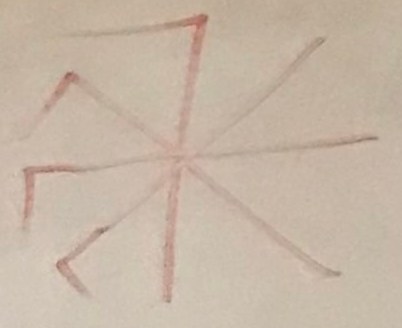
Such representation makes 7 and L elements of cluckwise swastica, while J and Г are of the unlucky one. Left and right paths, both are probably rationalized, so is G left? Gone? Garbage, gross, grease, грязь, гандон, г,
господь, господин, го-о.
Were nsdap masons? Why masons? The G~Г (kukryniksy even plaed with that peculiarity of nsdap leaders's surnames, but I think I mentioned it already. I think I didn't show it, so let's have it:
And it was not kukryniksy, it was Moor:

Гесс ещё одно. Was nsdap designed by russian emigrants?
Russians emp[eror's legions wore that emblem too:

but germans wore that symbol of pirates too:
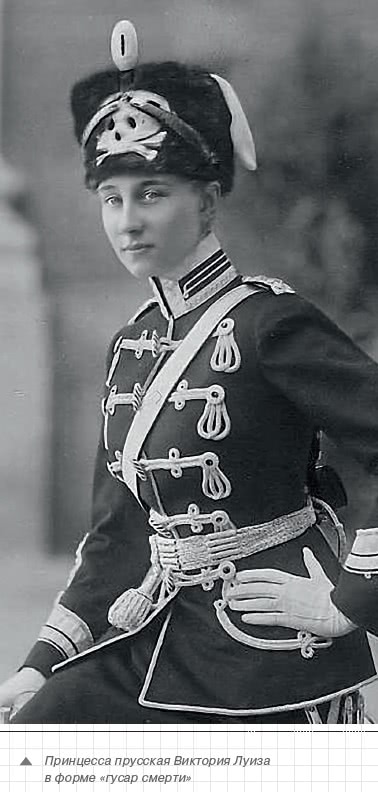
they say it is a symbol of immortalitym, but I doubt it,
it is told to be a christian symbol "adam's head" you could see on their crosses,
but because religious people are messed up, you shouldn't accept their symbols.
is pdf's ☯, so not only seamonkey have messed up with unicode, but adobe or developers of pdf itself messed something up in that area.
Волшебная палочка быть может волшебна тем, что совмещает дерево и камень, а на ощупь дерево теплей камня, хотя оба в одном помещении. И держа руками крупный кристалл граната, лежащий на торце небольшого соснового бревна, высохшего с покрытыми канифолью спилами и оставленной корой, я почувствовал волну, которую ладони одновременно касающиеся и камня и дерева отправляли по всему телу. Может быть подобные посохи были способом вводить человека в сильное энергетическое состояние. Большие исследования необходимы, и лучше в сферованной, в сферо-ванне чтоб если упасть то не убиться. Страховку может прикупить и распределить нагрузгу по стенам, во время игр с волшебным посохом.
Я знаю, о палочках, способных течь против течения, и волшебных тем (и не только тем: The root of a medicinal plant called Garuda Sanjivani is peculiar because of its ability to move against the flow of water. Believed to be found in India in dense forest areas or The Himalayas. In Hindu mythology, sanjeevani is a 'magical' herb rich in medicinal properties and has the power to cure serious nervous system problems. It was believed that medicines prepared from this herb could 'revive situations where death is almost certain' но может быть и фокусом)
(mirror)
и быть может я ещё что-то о них открыл (почему они часто с камнем совмещены) это сырая информация, описание наблюдения, не эксперимента полноценного ещё (в любом случе, то что фокусы в английском названы магией, не превращает всю магию в шарлатанство, какая-то часть её определённо является таковой, но грань зыбка, если вовсе существует, ведь можно использовать фокус, чтоб заворожить, можно волшебный трюк фокусом обозвать и смысл не сильно поменяется)
Upstream contamination is a real phenomenon probably related
or at least similar to those spyrallic sticks.
But I think that phenomenon is of different nature and caused by wood in water streaming upwards, and the flow being on the inside more than on surface. And with that stick flawing upwards, isn't it caused by the flow being layered so it spirals and swims? How are you supposed to push a wood to make it flow the other way? If wood wants to go upwards, why doesn't it go upwards all the time? Because the flow is faster than the emerging force.
okay, now to something even more fuckedup:
The corpus callosum is the primary commissural region of the brain consisting of white matter tracts that connect the left and right cerebral hemispheres.
I wonder how were they even allowed to perform such operations to find such effect. I guess they tortured patients of asylums (considering practices such as est and lobotomies, I wouldn't be much surprised)


But I think that phenomenon is of different nature and caused by wood in water streaming upwards, and the flow being on the inside more than on surface. And with that stick flawing upwards, isn't it caused by the flow being layered so it spirals and swims? How are you supposed to push a wood to make it flow the other way? If wood wants to go upwards, why doesn't it go upwards all the time? Because the flow is faster than the emerging force.
okay, now to something even more fuckedup:
The corpus callosum is the primary commissural region of the brain consisting of white matter tracts that connect the left and right cerebral hemispheres.
I wonder how were they even allowed to perform such operations to find such effect. I guess they tortured patients of asylums (considering practices such as est and lobotomies, I wouldn't be much surprised)


Looking at this smile I once again recalled that israeli smile movie and recognized that what I'm doing is dark as well. Yes, it is allowing people learn languages with not memorizing, but with recognizing them. But yet it ..Yet, it excavates all beliefs and all recognition, it tun ture tune turns
s = si
t = no
I wanted to write: It excavates all old (alled (те что уже всё? всё видали всё делали, всё было. я глуп? я груб. вспоминая свою жизнь я очень грубый парень. очень медвежуткий. но я стремлюсь нивелироватт эту грубоватостт в заводной апельсин забираясь. like literally I used nadsat before I formed that thought of comparison my capsule to clockwork orange))
it turns back time I wanted to say, that we excavate the beast when we excavate the passt/
and thosugh that double s and / were nazi-lijk, typos, they were nazi-lijk, and to the poingt:
nazi were neopagans, naturally seeing
christians as jews who took over Rome
and now uses its power to overcome us. Churches will burn and isn't how we erase our past? Isn't it why ancient monuments were not cherished, by abandoned or even hills were built on thir place.
Could they bother so much? Why else would we have to excavate them?
Сели и вулканические извержения могут быть причиной.
Потому города и заброшены, что может всё снести нахуй в любой ммоент
Should goyim subjugate themselves to jews? Were jews not predicted to fail?
Because they told me that quran is plagirism of their jewish teaching,
the next time I hear it I will ask if it means that they're predicted to fail in the end?
to fail to falland now uses its power to overcome us. Churches will burn and isn't how we erase our past? Isn't it why ancient monuments were not cherished, by abandoned or even hills were built on thir place.
Could they bother so much? Why else would we have to excavate them?
Сели и вулканические извержения могут быть причиной.
Потому города и заброшены, что может всё снести нахуй в любой ммоент
Should goyim subjugate themselves to jews? Were jews not predicted to fail?
Because they told me that quran is plagirism of their jewish teaching,
the next time I hear it I will ask if it means that they're predicted to fail in the end?
Because I heard (but didn't yet checked) that
in quran it is said that isalm is going to fall in the end,
that quran has plenty of evidence against itself in itself.
if fail~fall, iſ I ~ le? (он его съел. кто? я)that quran has plenty of evidence against itself in itself.
is it related to т(т) ~ m(m)?
а тому что ты~те?
я (ja, дя (дядя? (does it tell that jah is da in daddy? da di du (daddy переходящее в диду, дядю))))
мы (мамы? (me~mommy (my)))
мяу и гау условно женские и мужские животные, а потому женские и мужские голоса
оттуда мама и дядя (в английском я бы этого не заметил, потому что там miau and baw, and m and b depicts a different picture, let's delve into ti it as well.
thee ~ it? это~оно~jy~он, который не должен быть далеко от ты~те(they)
But then there were some good souls in the
forementioned field as
well:
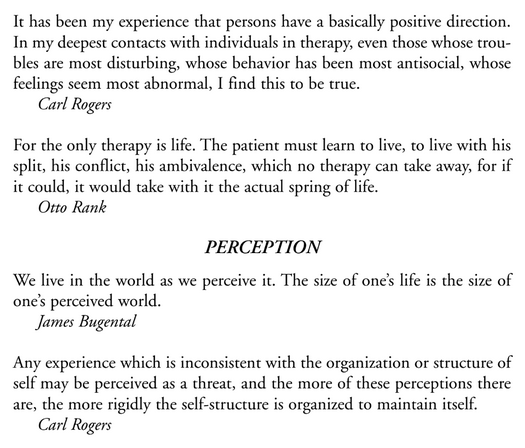
But what is good of them if all the discoveries, such as treating patients with callosotomy
(and some would maybe call lobotomy, but that is technically почти что казнь) are made by monsters?
My view on the subjecty is inevitably profane, two sides of the profession is masterfully showin
in
Squeal Squills Quills
movie
Quills were the primary writing instrument in the western world from the 6th to the 19th century. The best quills were usually made from goose, swan, and later turkey feathers. Quills went into decline after the invention of the metal pen, mass production beginning in Great Britain as early as 1822 by John Mitchell of Birmingham.[6] In the Middle East and much of the Islamic world, quills were not used as writing implements. Only reed pens were used as writing implements
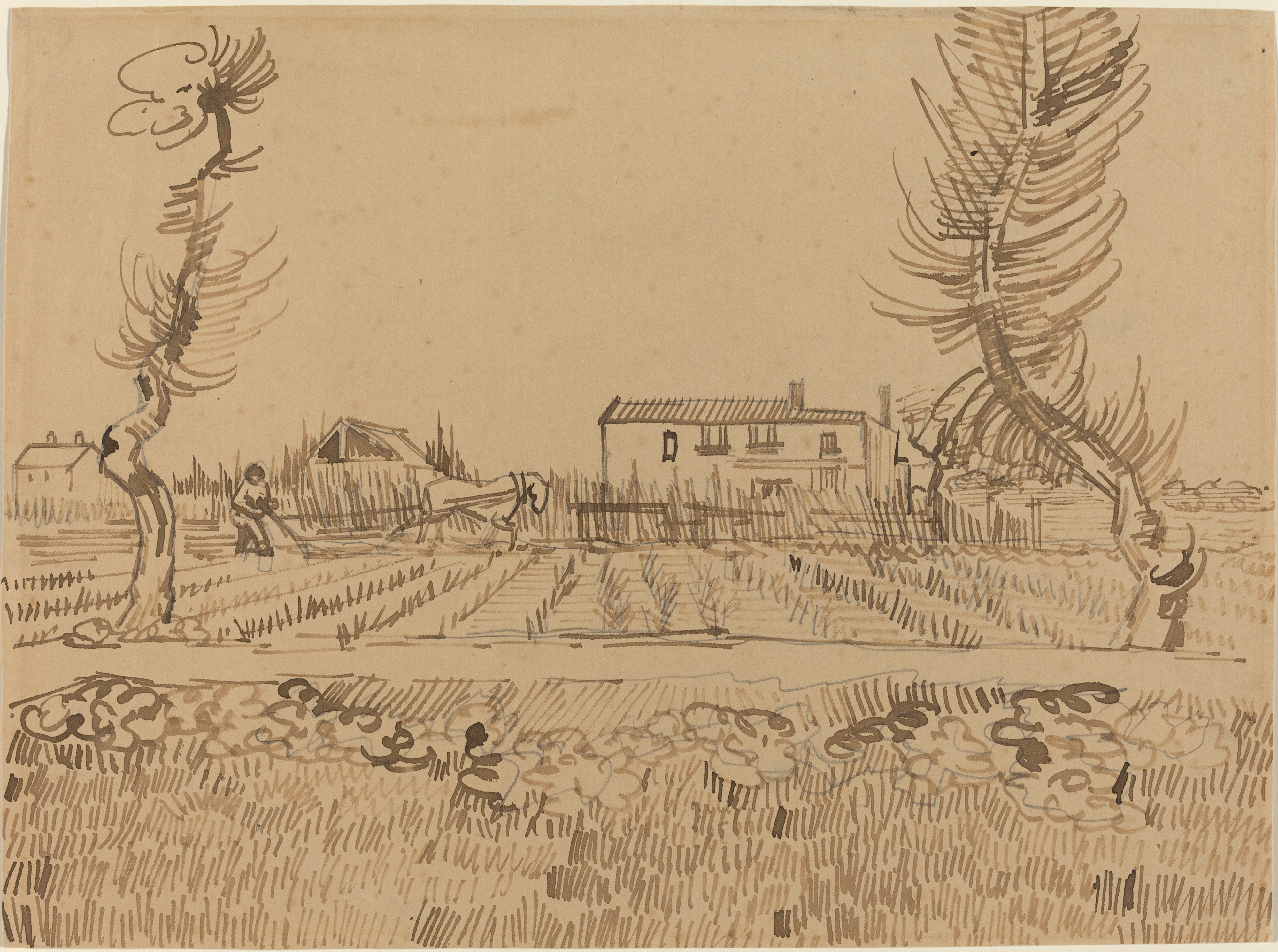
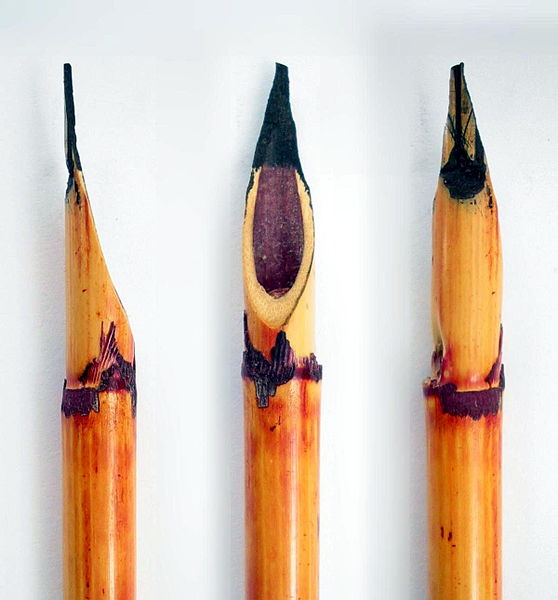
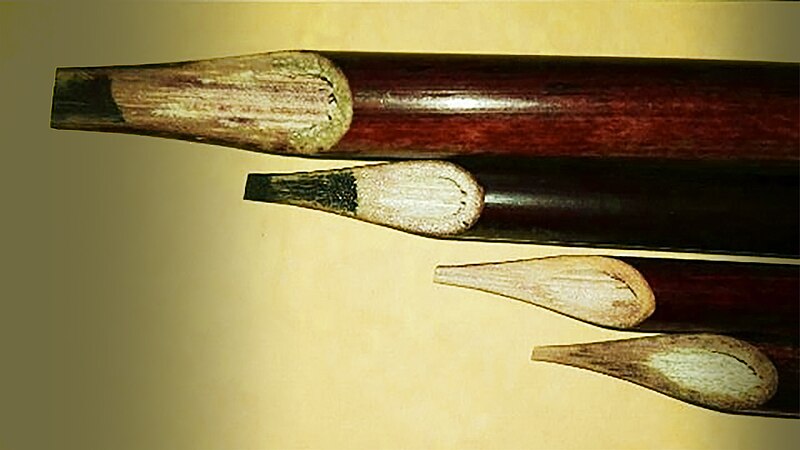
The earliest ancestor of the pen probably was the brush the Chinese used for writing by the 1st millennium bce. The early Egyptians employed thick reeds for penlike implements about 300 bce. A specific allusion to the quill pen occurs in the 7th-century
The earliest known form of writing using a 'pen' began in Ancient Egypt where reed pens were created to write on papyrus. Ancient Egyptians first used reed styluses to carve hieroglyphs into tablets made from clay similar to the Sumerians.
Paintbrushes were used by man as early as the Paleolithic era in around 2.5 million years ago in order to apply pigment.[1]
Old painting kits, estimated to be around 100,000 years old, were discovered in a cave in what is now modern South Africa.[2]
Ancient Egyptian paintbrushes were made of split palm leaves and used by ancestors to beautify their surroundings. The oldest brushes ever found were also made of animal hair.

But what is good of them if all the discoveries, such as treating patients with callosotomy
(and some would maybe call lobotomy, but that is technically почти что казнь) are made by monsters?
My view on the subjecty is inevitably profane, two sides of the profession is masterfully showin
in
Squeal Squills Quills
movie
Quills were the primary writing instrument in the western world from the 6th to the 19th century. The best quills were usually made from goose, swan, and later turkey feathers. Quills went into decline after the invention of the metal pen, mass production beginning in Great Britain as early as 1822 by John Mitchell of Birmingham.[6] In the Middle East and much of the Islamic world, quills were not used as writing implements. Only reed pens were used as writing implements



The earliest ancestor of the pen probably was the brush the Chinese used for writing by the 1st millennium bce. The early Egyptians employed thick reeds for penlike implements about 300 bce. A specific allusion to the quill pen occurs in the 7th-century
The earliest known form of writing using a 'pen' began in Ancient Egypt where reed pens were created to write on papyrus. Ancient Egyptians first used reed styluses to carve hieroglyphs into tablets made from clay similar to the Sumerians.
Paintbrushes were used by man as early as the Paleolithic era in around 2.5 million years ago in order to apply pigment.[1]
Old painting kits, estimated to be around 100,000 years old, were discovered in a cave in what is now modern South Africa.[2]
Ancient Egyptian paintbrushes were made of split palm leaves and used by ancestors to beautify their surroundings. The oldest brushes ever found were also made of animal hair.
The oldest known cave painting is a red hand stencil in Maltravieso cave, Cáceres, Spain. It has been dated using the uranium-thorium method to older than 64,000 years and was made by a Neanderthal.
or (and when I hear of neanderthals, I immediately think "so tiresome" (yes "jewish tricks" I think))
Archaeologists say they have discovered the world's oldest known cave painting: a life-sized picture of a wild pig that was made at least 45,500 years ago in Indonesia. The finding, described in the journal Science Advances on Wednesday, provides the earliest evidence of human settlement of the region.
But 50000 years ago and..
The Sumerian archaic (pre-cuneiform) writing and Egyptian hieroglyphs are generally considered the earliest true writing systems, both emerging out of their ancestral proto-literate symbol systems from 3400 to 3100 BCE, with earliest coherent texts from about 2600 BCE.
5000 years ago is also quite a distance,
but what are those proto-literate symbol
systems?
In at least 400 European caves such as Lascaux, Chauvet and Altamira, Upper Palaeolithic Homo sapiens groups drew, painted and engraved non-figurative signs from at least ~42,000 bp and figurative images (notably animals) from at least 37,000 bp. Since their discovery ~150 years ago, the purpose or meaning of European Upper Palaeolithic non-figurative signs has eluded researchers. Despite this, specialists assume that they were notational in some way. Using a database of images spanning the European Upper Palaeolithic, we suggest how three of the most frequently occurring signs—the line <|>, the dot <•>, and the <Y>—functioned as units of communication. We demonstrate that when found in close association with images of animals the line <|> and dot <•> constitute numbers denoting months, and form constituent parts of a local phenological/meteorological calendar beginning in spring and recording time from this point in lunar months. We also demonstrate that the <Y> sign, one of the most frequently occurring signs in Palaeolithic non-figurative art, has the meaning <To Give Birth>. The position of the <Y> within a sequence of marks denotes month of parturition, an ordinal representation of number in contrast to the cardinal representation used in tallies. Our data indicate that the purpose of this system of associating animals with calendar information was to record and convey seasonal behavioural information about specific prey taxa in the geographical regions of concern. We suggest a specific way in which the pairing of numbers with animal subjects constituted a complete unit of meaning—a notational system combined with its subject—that provides us with a specific insight into what one set of notational marks means. It gives us our first specific reading of European Upper Palaeolithic communication, the first known writing in the history of Homo sapiens.
they say that non-figurative marks predate paintings by five
milleniaIn at least 400 European caves such as Lascaux, Chauvet and Altamira, Upper Palaeolithic Homo sapiens groups drew, painted and engraved non-figurative signs from at least ~42,000 bp and figurative images (notably animals) from at least 37,000 bp. Since their discovery ~150 years ago, the purpose or meaning of European Upper Palaeolithic non-figurative signs has eluded researchers. Despite this, specialists assume that they were notational in some way. Using a database of images spanning the European Upper Palaeolithic, we suggest how three of the most frequently occurring signs—the line <|>, the dot <•>, and the <Y>—functioned as units of communication. We demonstrate that when found in close association with images of animals the line <|> and dot <•> constitute numbers denoting months, and form constituent parts of a local phenological/meteorological calendar beginning in spring and recording time from this point in lunar months. We also demonstrate that the <Y> sign, one of the most frequently occurring signs in Palaeolithic non-figurative art, has the meaning <To Give Birth>. The position of the <Y> within a sequence of marks denotes month of parturition, an ordinal representation of number in contrast to the cardinal representation used in tallies. Our data indicate that the purpose of this system of associating animals with calendar information was to record and convey seasonal behavioural information about specific prey taxa in the geographical regions of concern. We suggest a specific way in which the pairing of numbers with animal subjects constituted a complete unit of meaning—a notational system combined with its subject—that provides us with a specific insight into what one set of notational marks means. It gives us our first specific reading of European Upper Palaeolithic communication, the first known writing in the history of Homo sapiens.
And this reflects what I heard about ancient
egyptian phonograms predating ideograms
How can that be?
How can it be that x is not the most popular symbol? Maybe because × stood for death?
A crossed-out unit. And thus it is the ancient source of jewish understanding of ת, and german tott.
While I can perfectly see how Y can stand for byrth, another stick coming out of the centre of the other.
But where did I read that taf stands for death?
In Judaism
Tav is the last letter of the Hebrew word emet, which means 'truth'. The midrash explains that emet is made up of the first, middle, and last letters of the Hebrew alphabet (aleph, mem, and tav: אמת). Sheqer (שקר, falsehood), on the other hand, is made up of the 19th, 20th, and 21st (and penultimate) letters.
Thus, truth is all-encompassing, while falsehood is narrow and deceiving. In Jewish mythology it was the word emet that was carved into the head of the golem which ultimately gave it life. But when the letter aleph was erased from the golem's forehead, what was left was "met"—dead. And so the golem died.
Ezekiel 9:4 depicts a vision in which the tav plays a Passover role similar to the blood on the lintel and doorposts of a Hebrew home in Egypt.[2] In Ezekiel's vision, the Lord has his angels separate the demographic wheat from the chaff by going through Jerusalem, the capital city of ancient Israel, and inscribing a mark, a tav, "upon the foreheads of the men that sigh and that cry for all the abominations that be done in the midst thereof."
In Ezekiel's vision, then, the Lord is counting tav-marked Israelites as worthwhile to spare, but counts the people worthy of annihilation who lack the tav and the critical attitude it signifies. In other words, looking askance at a culture marked by dire moral decline is a kind of shibboleth for loyalty and zeal for God.[3]
Sayings with taf
"From aleph to taf" describes something from beginning to end, the Hebrew equivalent of the English "From A to Z."
ࠕ 𐎚 𐡕 𐤕
How can that be?
How can it be that x is not the most popular symbol? Maybe because × stood for death?
A crossed-out unit. And thus it is the ancient source of jewish understanding of ת, and german tott.
While I can perfectly see how Y can stand for byrth, another stick coming out of the centre of the other.
But where did I read that taf stands for death?
In Judaism
Tav is the last letter of the Hebrew word emet, which means 'truth'. The midrash explains that emet is made up of the first, middle, and last letters of the Hebrew alphabet (aleph, mem, and tav: אמת). Sheqer (שקר, falsehood), on the other hand, is made up of the 19th, 20th, and 21st (and penultimate) letters.
Thus, truth is all-encompassing, while falsehood is narrow and deceiving. In Jewish mythology it was the word emet that was carved into the head of the golem which ultimately gave it life. But when the letter aleph was erased from the golem's forehead, what was left was "met"—dead. And so the golem died.
Ezekiel 9:4 depicts a vision in which the tav plays a Passover role similar to the blood on the lintel and doorposts of a Hebrew home in Egypt.[2] In Ezekiel's vision, the Lord has his angels separate the demographic wheat from the chaff by going through Jerusalem, the capital city of ancient Israel, and inscribing a mark, a tav, "upon the foreheads of the men that sigh and that cry for all the abominations that be done in the midst thereof."
In Ezekiel's vision, then, the Lord is counting tav-marked Israelites as worthwhile to spare, but counts the people worthy of annihilation who lack the tav and the critical attitude it signifies. In other words, looking askance at a culture marked by dire moral decline is a kind of shibboleth for loyalty and zeal for God.[3]
Sayings with taf
"From aleph to taf" describes something from beginning to end, the Hebrew equivalent of the English "From A to Z."
ࠕ 𐎚 𐡕 𐤕
That מת is dead is the only mentioning of T being of tott in any way. What did I mistake for hebrew? Runes? No, no such meaning can be seen. Tarot? But why would runes be connected with tarot? And I'm grasping at the throe here straw here: Bureus sets ᛏ 12th, and if we had to add one somewhere before it, to get 16 of what they call younger futhark, we'd have ᛏ in the 13th position, but what does it prove? What would it prove? If you check the 16-rune sets above in this volume, you can see, that ᛏ is 12th in them too. I was certain T stood for death, the cross so to say, or did christians reinterpreted death as salvation? ᛏ stands for Tyr, who was a patron of warriors, so death are not that far from that, but wut, I was certain of it, and I mentioned that probably many time through my work. And now starting to dig it to eradicate the herecy, I found something spectacular, which I placed in the first volume only to thoroughly forget about ever finding it:
Each
vowel represented a quarterly station of the year: O
(greenweed) the Spring Equinox; U (heather) the Summer
Solstice; E (poplar) Autumn Equinox; A (fir, or
palm) the birth-tree, and I (yew) death-tree, shared the Winter Solstice between them. This order of letters is implicit in Greek
and Latin myth and the sacral tradition of all Europe and,
mutatis mutandis, Syria and Asia Minor. The goddess
Carmenta invented B and T as well as the vowels, because each
of these calendar-consonants introduced one half of her year, as divided between the sacred king and his
tanist.
Four vowels (the way archaic alphabets were) are more deeply
rooted in the culture: four seasons is how it goes (they say,
egyptians had only three! as old-persian syllabary had only three
vowels) so the fifth vowels was to add another season or was it to
untie vowels from their meanings? Or was it just some ignorant
sophistication, caused by natural wish to have more letters in the
set? But then we wouldn't read here that A is birth and I is death (recall the strange clock from above in this volume)
And that first volume speaks about ogham, linking only first three aicme to calendar:

1 Dec. 24 B birch, or wild
olive
2 Jan. 21 L rowan
3 Feb. 18 N ash
4 March 18 F alder, or cornel
5 April 15 S willow; SS (Z), blackthorn
6 May 13 H hawthorn, or wild pear
7 June 10 D oak, or terebinth
8 July 8 T holly, or prickly oak
9 Aug. 5 C nut; CC (Q), apple, sorb
10 Sept. 2 M vine
11 Sept. 30 G ivy
12 Oct. 28 Ng or Gn reed, or guelder rose
13 Nov. 25 R cider, or myrtle
2 Jan. 21 L rowan
3 Feb. 18 N ash
4 March 18 F alder, or cornel
5 April 15 S willow; SS (Z), blackthorn
6 May 13 H hawthorn, or wild pear
7 June 10 D oak, or terebinth
8 July 8 T holly, or prickly oak
9 Aug. 5 C nut; CC (Q), apple, sorb
10 Sept. 2 M vine
11 Sept. 30 G ivy
12 Oct. 28 Ng or Gn reed, or guelder rose
13 Nov. 25 R cider, or myrtle
and not all of them made it to the calendar,
z didn't,
c and q were combined into one.
And in the light of them being in the end of their aicme,
and because in the first aicme what is now fifth stands the third, makes me suspect the calendar to be even shorter,
five is too many, 3 by 3 would be more magical
c and q were combined into one.
And in the light of them being in the end of their aicme,
and because in the first aicme what is now fifth stands the third, makes me suspect the calendar to be even shorter,
five is too many, 3 by 3 would be more magical
Топоним Симбирск может кговорить, что Сибирь была Симбирью, в смысле того что людям приходится делить её с медведями. But there's not m in russian съ, so even though there's m in latin forms of that prefix, which you saw in symbionsis, so, yes, this is the guess, a hypothuess.
And T being the final letter, doesn't it tell that 12th position of it may indicate how calendar was?
Why would I ever rely to futhark? Because it is secretly an abecedary? I still don't know if it's true.
Macht der Besessenheit ~ Might of obsession (I guessed it was posession, but beDE is obEN
(and I can explain that by B being that prefix,
and that's in in hebrew in and russin russian)

I looked up death in my volumes, and found
that I began associating T to death in the beginning of vol.4,
which is really spectacular.
another curious observation is that in vol.13 I don't use word "death" once,
which is unusual considering that in vol.12 I use that word five times, and ten times in vol. 14.
And in vol.14 I delicately touch that guess, but do it more strongly in vol.15.
I attribute death to the fourth letter, D in vol.16.
(and now I speak about it in 31
another curious observation is that in vol.13 I don't use word "death" once,
which is unusual considering that in vol.12 I use that word five times, and ten times in vol. 14.
And in vol.14 I delicately touch that guess, but do it more strongly in vol.15.
I attribute death to the fourth letter, D in vol.16.
(and now I speak about it in 31
31 is like the last number in the name of
days.. did every dey had it's letter?
in runic calendars they literally do. And they go alphabetically, 7 by 7 by 7..
let's check if I could mistransliterate those runes.. Let's look if those 7 could be 5 vowels and b and t
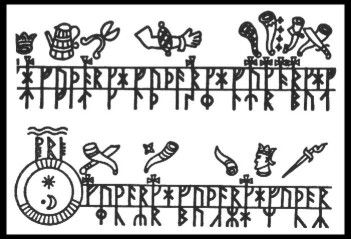
If you look at this fragment, you may miss the point:
it places ᚴ instead of ᚦ in the upper 6th position from the right:
it doesn't break it with ;:'s as if into words, the days are named, not weeks.
I wonder what do the three signs on the circle tell.
Are they three golden number?
Golden numbers are told to be 19!
Those three are added to the 16 of younger futhark to get 19.
But actual order are

Thus, once again, those who placed numbers in the top right
corner of the image knew a little more than those who placed
the text below the calendar. But both were probably wrong. If
those who placed the numbers knew something more than me, I
can rely on them to find the beginning of this thing, this is
how it was oriented and how to be rotated:in runic calendars they literally do. And they go alphabetically, 7 by 7 by 7..
let's check if I could mistransliterate those runes.. Let's look if those 7 could be 5 vowels and b and t

If you look at this fragment, you may miss the point:
it places ᚴ instead of ᚦ in the upper 6th position from the right:
it doesn't break it with ;:'s as if into words, the days are named, not weeks.
I wonder what do the three signs on the circle tell.
Are they three golden number?
Golden numbers are told to be 19!
Those three are added to the 16 of younger futhark to get 19.
But actual order are


thus this calendar starts from the left
bottom corner, but then why doesn't it go reverse
boustrophedon? Maybe because it is some other school,
influenced by southerners? And because they write in lines,
could they read them like we do? But then it contradicts what
the writing under taht that
image tells. So what is more likely? That they read right to
left, and then from bottom up, or that they read it in lines
and our way, we don't see runes going right to left as much,
even when they do it, the reverse as a snake would do, and
thus whether upside down runes are legit the same runes, or
that this image is to be rotated once again? 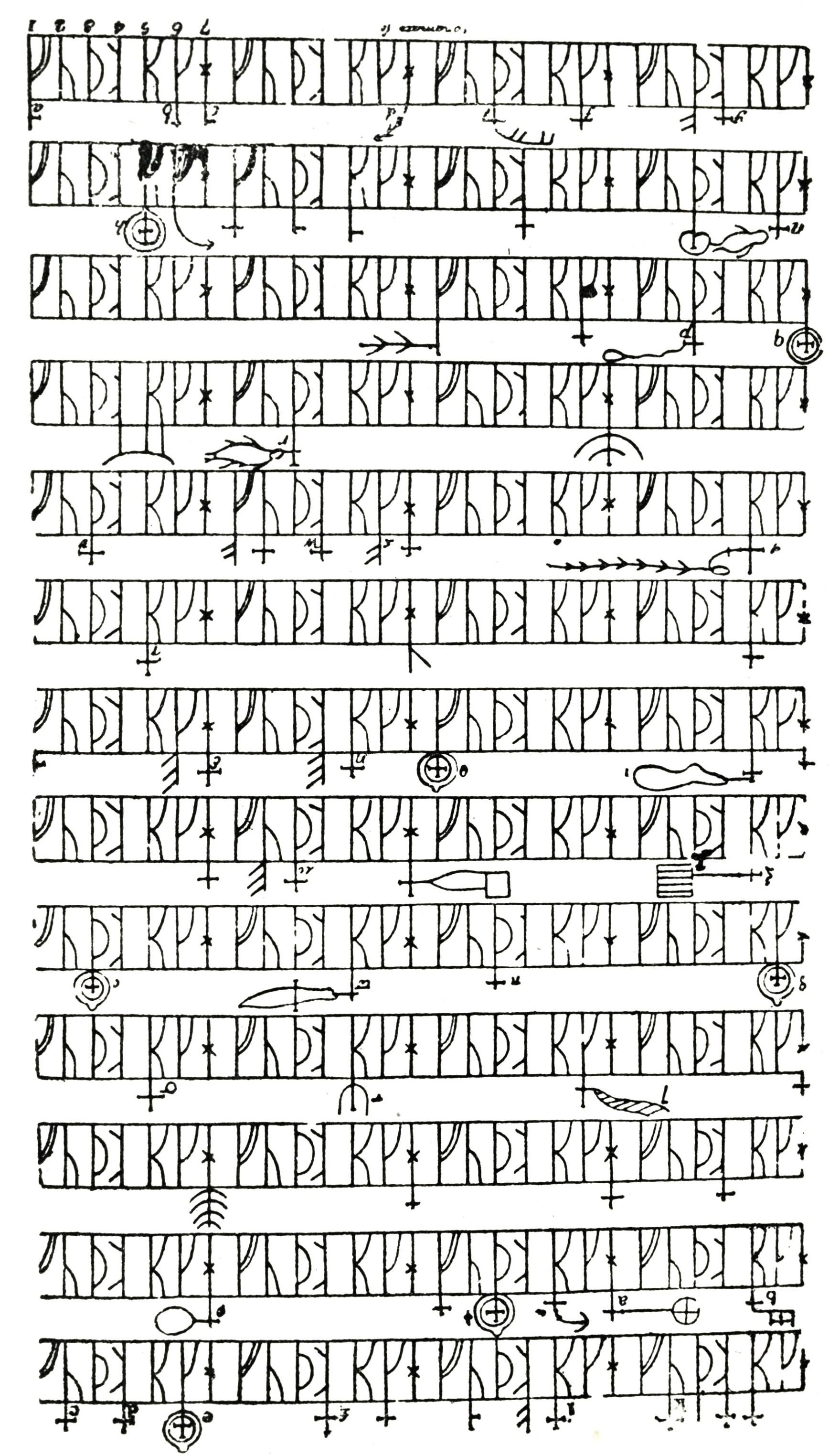
But then we have two problems:
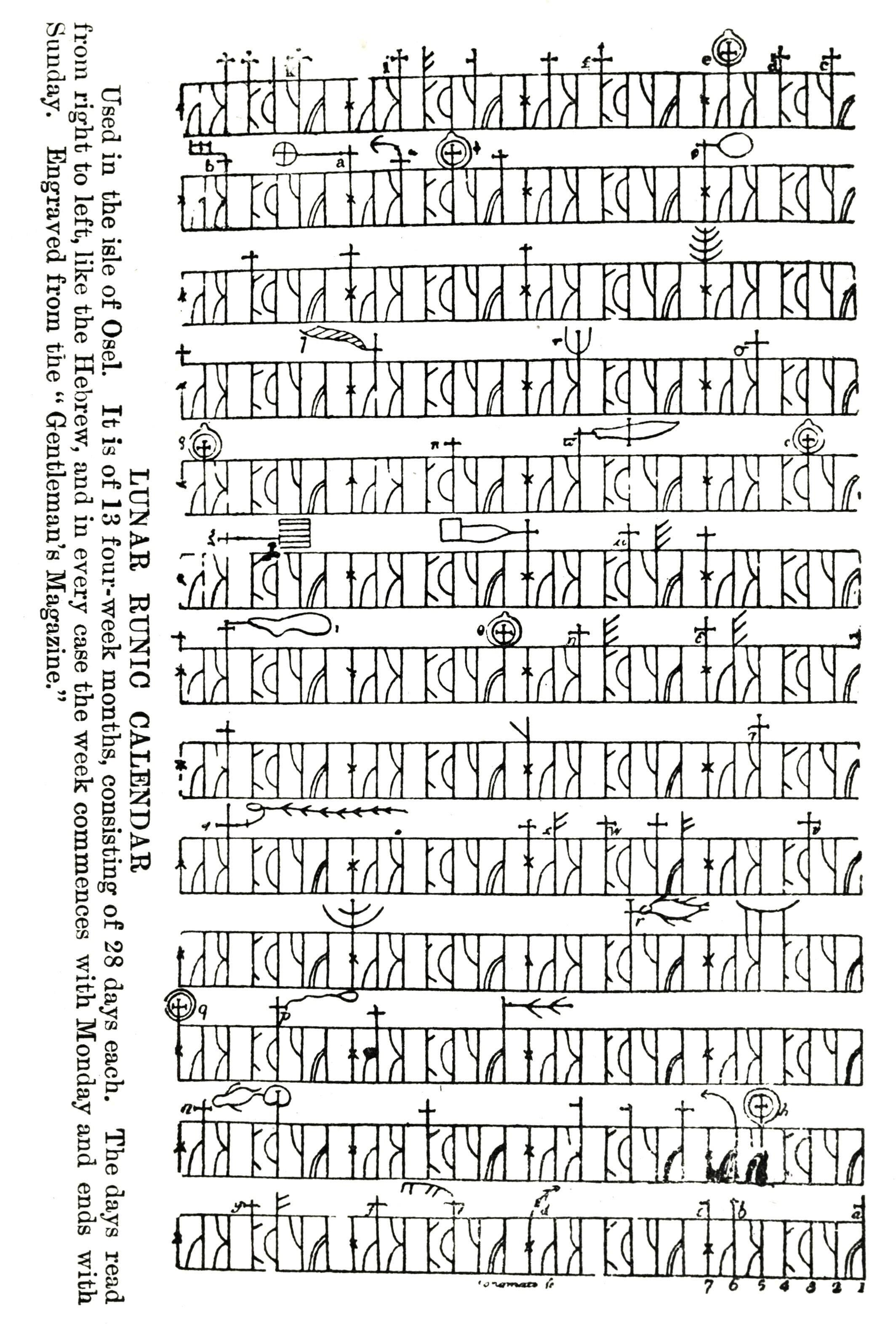
But still what a mess! Where's the original comment to what those abc's mean and why he jumps them?
Let's once agin leave it, let's jusm p m jump to something not far away:

It looks very much like the alphabet from bornm (born-m?) bornholm, but with some serious differences: the way it places ᚴ before ᚦ, the way it draws ᛩ, telling me that the way they drew ᚦ like ᚹ somewherte else, the way it tells taht ᛕ is ᚱ, the way it places ᛔᛕ before ᚱ, and the way it has different ᚢ's, one of which isn't even in the unicode, the way it probably adds the three added to get the golden number, but then their ᛏ is 19th, but then isn't it just placing runes into alphabetic order regardless of their historic or traditional order? Because this system needed 19 runes to represent the 19 golden numbers which stood for the 19 years of the perpetual calendar's cycle, the Younger Futhark was insufficient, having only 16 characters. The solution devised was to add three special runes to represent the remaining numbers: ᛮ (arlaug; Golden Number 17), ᛯ (tvimadur or tvímaður; Golden Number 18), and ᛰ (belgthor; Golden Number 19). In 1636, Ole Worm documented the Younger Futhark numeral system, including these three characters, in his Runir seu Danica literatura antiquissima (Runes: the oldest Danish literature).[1] and it closes its sequence with a binderune et, as some latin alphabets place & after z, maybe to get 27 letters sufficient to count.
and where I took this image, some interesting text appears, it
indicates that von List was more wiser than your average
scholar, and thus his point of view is more legit than the
official point of view of your saverage
scholar:
Как говорит д-р Альфред Руссел-Валанс, наука всегда выступает против открытия новой Истины, и каждый раз ошибается! — Настоящий ученый подтвердит, что это так!
Фон Лист употребляет термин Futharkh вместо общепринятого Futhark, объясняя это в других своих работах тем, что более верно образовывать название рунического строя от фонетических соответствий первых семи, а не первых шести рун.
and golly he was right:
ᛘ man — человек, мужчина (нем. Mann); топ — Луна (нем. Mond) (та — мать; пустой или мертвый). Присвоение фон Листом имени Man (и, соответственно, звука т) руне , традиционно называемой Aigiz, может показаться читателю странным и сомнительным. Между тем, данный знак в относительно поздние времена действительно нередко использовался в Скандинавии для обозначения звука т и вытеснил во многих районах более древнюю руну Старшего Футарка традиционно именуемую ныне Man (или Mannaz).
and those signs on runic calendars are taken from privstaven:
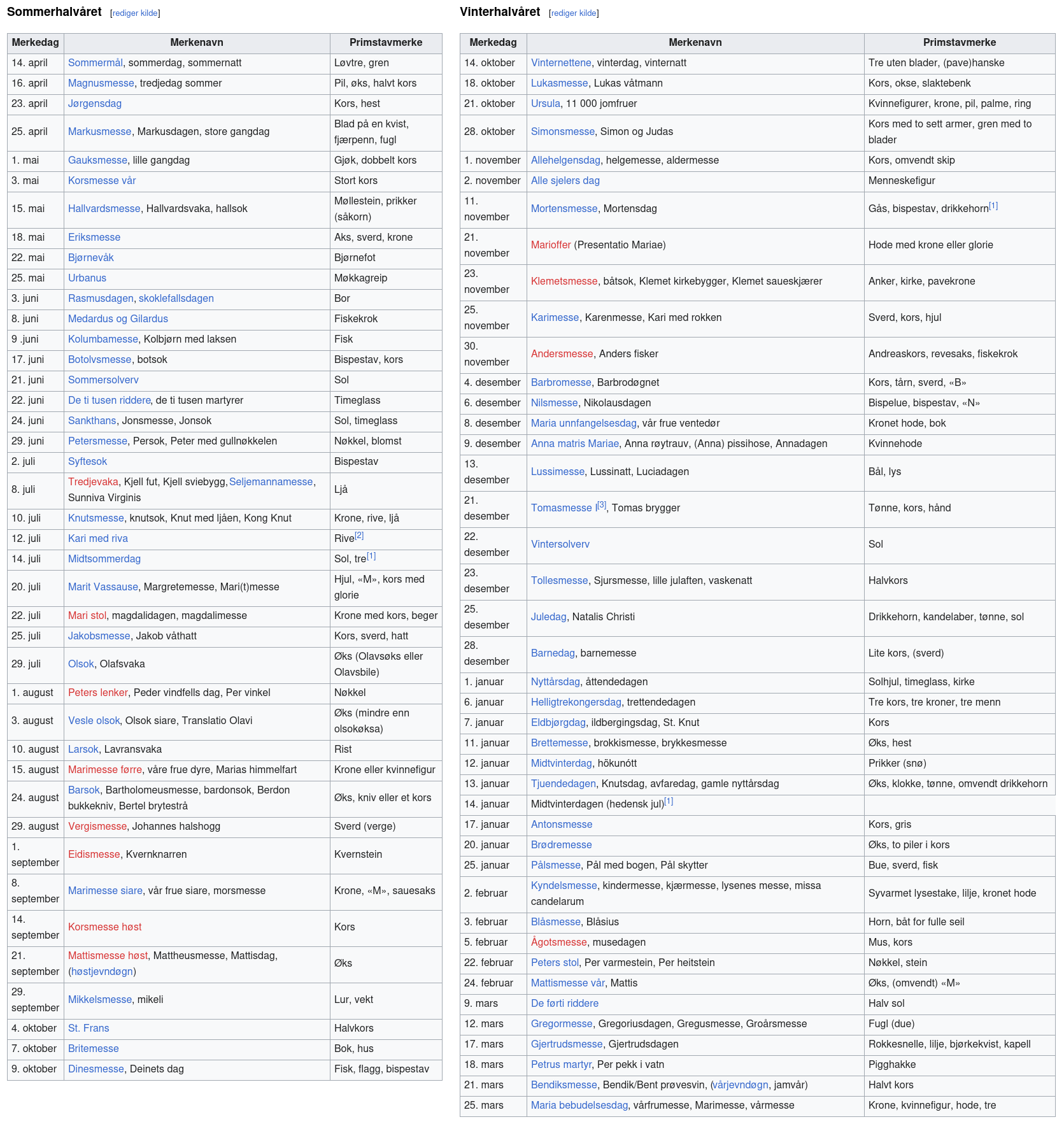
So they didn't have four times of the year, they didn't even have three, they only knew summer and winter, at least their calendars did. No, not calendars, primstavs. There are some calendars divided into four seasons, I think, but the one we rotated earlier separates the year into 13 months of 4 weeks, 13 doesn't divide into two, nor four.
And I tried to compare this festivities' list to the calendar above, but it seems they had somewhat different lists of festivities. And calendars divided into 13 and into 2 are two different systems.
I will collect some primstavs, but I still didn't fined one find one correlating to that table. But wait a second, I think I've got it:
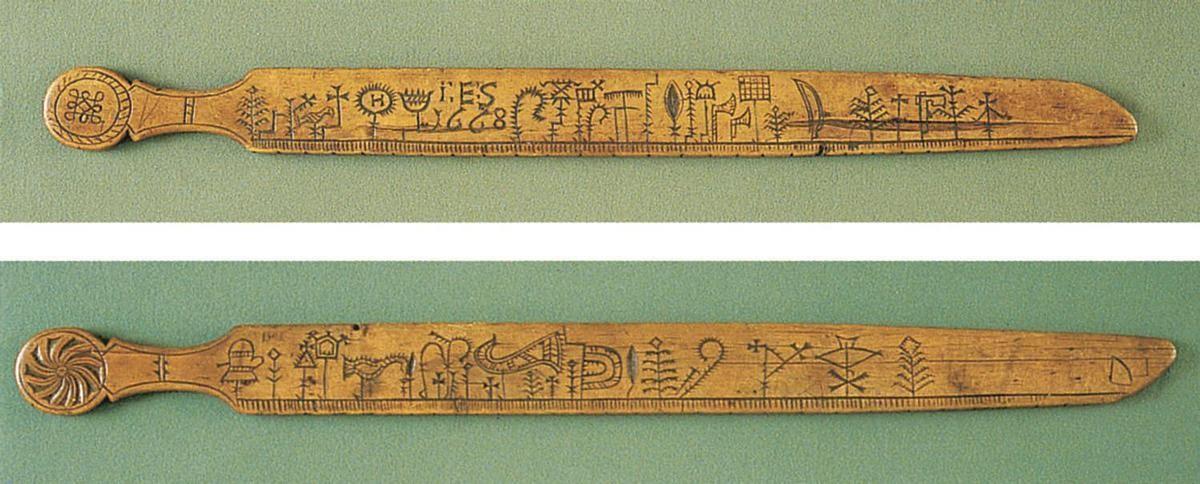
The primstav is a perpetual calendar that was in use in Norway up until the 19th century. The oldest specimen we have today is from 1457, but based on written sources it is assumed that the primstav was in use already in the 13th century (Alver 1981, Kismul 1979).
The traditional primstav is made of wood and marked with one line for each day, normally a larger line every seventh day, and engraved with images and symbols marking the different non-moving religious holidays.
The primstav has a summer side, and a winter side. This division of the year into two seasons, summer starting April 14th and winter starting October 14th, goes back to heathen times in Norway, and traditionally there were celebrations with sacrifices and feast connected to the change of season and mid-season.
While the main or overt purpose of the primstav was to keep track of the religious celebrations, in practical use and interpretation it was also a tool giving note of seasonal shifts, expectations and preparations in connection with these, rules of thumb for predicting the weather, when to start or end different types of work, especially in farming. You would have rhymes and sayings connected with different days which gave commands or advise for different activities in farming and everyday life.
The primstav went out of use in the eightieth century for several reasons, mainly, the change into the Gregorian calendar (1700, in Norway) and printed paper almanacs becoming more widespread, making the primstav obsolete.
So I just assume that the upper one is for summer, maybe because of the counterclockwise swastica fits the winter more, and maybe because of the mitten I actually didn't notice before I said that because the first two festivites lay directly on the first and the third days: 14th and 16th of April. Then April 25 is the third holiday, which is Markusmesse, so I think we're in the right. Only for whatever reason they didn't mark the Jørgensdag (23 апреля (6 мая) — общехристианский церковный праздник, в день смерти Святого) Maybe because it's not messe, b ut dag. And yes, 1th and 3rd of May are marked in both table and the stav. 15th of May is Hallvardmesse, marked on the primstav with letter H. Then the next one.. is it above 26th or out of 22th? I guess 22th is the day, they just moved it aside not to crowd that H-sun, as they did with Magnusmesse. 22th is the Bjørnevåk, and thus they missed the Erikmesse, which tells that no, not because messen are more important than dagen, but because those are all holidays, and naturally different places celebrated not all of them. And then they miss all the holidays before Boltovsmesse, so, you can get the point. They miss some holidays, but don't add ones not present on that table.
Jorgen is George is Egor, and here it is interesting that Jora[ʒóra] is a colloquial form of Georgij, that is as if Egor palatalizes it in reverse, but then hardly anybody in russia knows that Егор is Георгий, we'd rather tell that it is Игорь (as Летов was actually named) so it is not reversed, but normal palatalization, and not in Egor, but in George.
so the 31, if it is 31st, it's definitely the last day of the month. so it's T or Z per se, the 13 in reverse adding up to 4 as well. If it's 30th it's about 50% that it's the last day, if it's 29th, only 1/48 is the chance that it is the final day, if it's 28th, it's 3/48
either way, 32

But then we have two problems:
a) we have the crosses going downwards,
which is sorta crazy, considering the fact that it is from
the christian times, but then they still use runes, could
they be antichristian? I doubt it, but who knows, could
inverted crosses of the metalheads be not christian at all?
b) we contradict the guy who knew something about it, and he placed not only the numbers, but also the letters all over this thing. And how weird is it that if we rotate them once again, their sequence indeed goes from the bottom up:
Either way, let's do it the way the guy or gal who marked it
see it:b) we contradict the guy who knew something about it, and he placed not only the numbers, but also the letters all over this thing. And how weird is it that if we rotate them once again, their sequence indeed goes from the bottom up:

But still what a mess! Where's the original comment to what those abc's mean and why he jumps them?
Let's once agin leave it, let's jusm p m jump to something not far away:

It looks very much like the alphabet from bornm (born-m?) bornholm, but with some serious differences: the way it places ᚴ before ᚦ, the way it draws ᛩ, telling me that the way they drew ᚦ like ᚹ somewherte else, the way it tells taht ᛕ is ᚱ, the way it places ᛔᛕ before ᚱ, and the way it has different ᚢ's, one of which isn't even in the unicode, the way it probably adds the three added to get the golden number, but then their ᛏ is 19th, but then isn't it just placing runes into alphabetic order regardless of their historic or traditional order? Because this system needed 19 runes to represent the 19 golden numbers which stood for the 19 years of the perpetual calendar's cycle, the Younger Futhark was insufficient, having only 16 characters. The solution devised was to add three special runes to represent the remaining numbers: ᛮ (arlaug; Golden Number 17), ᛯ (tvimadur or tvímaður; Golden Number 18), and ᛰ (belgthor; Golden Number 19). In 1636, Ole Worm documented the Younger Futhark numeral system, including these three characters, in his Runir seu Danica literatura antiquissima (Runes: the oldest Danish literature).[1] and it closes its sequence with a binderune et, as some latin alphabets place & after z, maybe to get 27 letters sufficient to count.
Как говорит д-р Альфред Руссел-Валанс, наука всегда выступает против открытия новой Истины, и каждый раз ошибается! — Настоящий ученый подтвердит, что это так!
Фон Лист употребляет термин Futharkh вместо общепринятого Futhark, объясняя это в других своих работах тем, что более верно образовывать название рунического строя от фонетических соответствий первых семи, а не первых шести рун.
and golly he was right:
ᛘ man — человек, мужчина (нем. Mann); топ — Луна (нем. Mond) (та — мать; пустой или мертвый). Присвоение фон Листом имени Man (и, соответственно, звука т) руне , традиционно называемой Aigiz, может показаться читателю странным и сомнительным. Между тем, данный знак в относительно поздние времена действительно нередко использовался в Скандинавии для обозначения звука т и вытеснил во многих районах более древнюю руну Старшего Футарка традиционно именуемую ныне Man (или Mannaz).
and those signs on runic calendars are taken from privstaven:

So they didn't have four times of the year, they didn't even have three, they only knew summer and winter, at least their calendars did. No, not calendars, primstavs. There are some calendars divided into four seasons, I think, but the one we rotated earlier separates the year into 13 months of 4 weeks, 13 doesn't divide into two, nor four.
And I tried to compare this festivities' list to the calendar above, but it seems they had somewhat different lists of festivities. And calendars divided into 13 and into 2 are two different systems.
I will collect some primstavs, but I still didn't fined one find one correlating to that table. But wait a second, I think I've got it:

The primstav is a perpetual calendar that was in use in Norway up until the 19th century. The oldest specimen we have today is from 1457, but based on written sources it is assumed that the primstav was in use already in the 13th century (Alver 1981, Kismul 1979).
The traditional primstav is made of wood and marked with one line for each day, normally a larger line every seventh day, and engraved with images and symbols marking the different non-moving religious holidays.
The primstav has a summer side, and a winter side. This division of the year into two seasons, summer starting April 14th and winter starting October 14th, goes back to heathen times in Norway, and traditionally there were celebrations with sacrifices and feast connected to the change of season and mid-season.
While the main or overt purpose of the primstav was to keep track of the religious celebrations, in practical use and interpretation it was also a tool giving note of seasonal shifts, expectations and preparations in connection with these, rules of thumb for predicting the weather, when to start or end different types of work, especially in farming. You would have rhymes and sayings connected with different days which gave commands or advise for different activities in farming and everyday life.
The primstav went out of use in the eightieth century for several reasons, mainly, the change into the Gregorian calendar (1700, in Norway) and printed paper almanacs becoming more widespread, making the primstav obsolete.
So I just assume that the upper one is for summer, maybe because of the counterclockwise swastica fits the winter more, and maybe because of the mitten I actually didn't notice before I said that because the first two festivites lay directly on the first and the third days: 14th and 16th of April. Then April 25 is the third holiday, which is Markusmesse, so I think we're in the right. Only for whatever reason they didn't mark the Jørgensdag (23 апреля (6 мая) — общехристианский церковный праздник, в день смерти Святого) Maybe because it's not messe, b ut dag. And yes, 1th and 3rd of May are marked in both table and the stav. 15th of May is Hallvardmesse, marked on the primstav with letter H. Then the next one.. is it above 26th or out of 22th? I guess 22th is the day, they just moved it aside not to crowd that H-sun, as they did with Magnusmesse. 22th is the Bjørnevåk, and thus they missed the Erikmesse, which tells that no, not because messen are more important than dagen, but because those are all holidays, and naturally different places celebrated not all of them. And then they miss all the holidays before Boltovsmesse, so, you can get the point. They miss some holidays, but don't add ones not present on that table.
Jorgen is George is Egor, and here it is interesting that Jora[ʒóra] is a colloquial form of Georgij, that is as if Egor palatalizes it in reverse, but then hardly anybody in russia knows that Егор is Георгий, we'd rather tell that it is Игорь (as Летов was actually named) so it is not reversed, but normal palatalization, and not in Egor, but in George.
so the 31, if it is 31st, it's definitely the last day of the month. so it's T or Z per se, the 13 in reverse adding up to 4 as well. If it's 30th it's about 50% that it's the last day, if it's 29th, only 1/48 is the chance that it is the final day, if it's 28th, it's 3/48
either way, 32
...
